Articles by and about REOC members, their machines, their adventures, and anything else of interest. Available to read by anyone. Click on the title bar of the article you wish to read and it will open on your screen.
We arrived in Goa after a long and tiring 16 hour journey. We’d had a short break in Bahrain airport during the overnight flight. The opulence in the duty free there was out of this world but very expensive so my wallet stayed firmly in my pocket. It was all quite surreal. We’d had to take our hand luggage off the plane so we’d made contact with a few of our fellow companions for the next two weeks. The tank and helmet bags kind of gave us all away! There were three lads from Northern Ireland and a father and son from Essex. We had a doctor and a fully qualified ambulanceman in the party anyway!
Queuing to pass through immigration took a while, especially as we were keen to get our first view of the country we had travelled so far to see, but eventually we reached the arrivals reception area to be completely surrounded by the local porters clamouring to help us with our bags (at a charge) It’s difficult to say no when you’re totally out of your own environment, tired and don’t know how to react. Fortunately the tour company we were expecting to meet us were on hand and took charge. Our bags were soon loaded on their minibus as we gathered all the members of the group together. There had been eleven of us on the plane, five of whom we had already made contact with. The other four were Archie and Harry, pals from Scotland, Richard a young father ‘on leave’ from his wife and children along with Dave a biker from the old-school who maintained and rode a garage full of various old English bikes including Enfield Bullets and BSAs.
A fairly hectic 30 km ride in the minibus saw us introduced to the crazy Indian driving standards, which were rather scary and a bit of a culture shock. Soon we were delivered to the headquarters of the tour company, a large Portuguese villa from a previous age in the history of Goa. The house was one of dilapidated splendour, hidden from the main roads and guarded by various dogs and a monkey. We were given a welcome, a bit of a safety brief on local riding standards and then an introduction to the bikes. Outside there was a line of about 18 Enfields, mainly black with the chrome glinting in the sun. The bikes were chosen for us on the whole, by the mechanic, Jamal. We were shown how to kick-start the Enfield (there were a few of us who had never experienced this) then asked, in turn, to start our own bikes, having accomplished this it was followed by a short ride to familiarize ourselves with them. (Fortunately they didn’t examine our riding too closely and we all managed the bikes well enough for them to OK our riding! even if some of us had to have some help kick- starting the Enfields after they had been stalled).
Then we were taken into the nearby seaside resort of Kalangute to our hotel for the night. The evening was taken up with a walk to watch the magnificent sunset over the sea. The beach was full of hundreds of people – locals and tourists all just there to watch the same spectacle of the sunset, a daily occurrence! Floating overhead were thousands of dragonflies in a myriad of different colours. The sun set really quickly and we walked back in the dark to supper in a cosy restaurant we found. It was pretty hot that first night and we were grateful that we were to be up early and heading for the cooler hills – colonial style.
The next morning we were picked up at dawn by the mini-bus and taken back to the villa. We had now been joined by Angie, a rider from Preston who had travelled on a later flight. We were soon on the road, travelling east, although we stopped after about an hour for breakfast. Those early miles were quite a challenge for all of us, especially those who had never ridden an old British bike with its right foot gear change, one up, three down and left foot brake. There was also a considerable lack of power compared to the Harleys Vanessa and I were used to. The Enfields are very pleasant bikes to ride though and ideally suited to the Indian roads and traffic.
We soon left what had passed for comfortable habitations, into the countryside. It was quite a shock to see how some of the villagers live. A tangle of branches by the road side daubed in mud would often reveal itself to be a home for a large family. The route deteriorated and we were now riding on a very uneven track, albeit twenty feet wide. We had arrived in Goa just at the end of the monsoon season. The roads are usually badly damaged or even washed away during the monsoons and much of the dry season is spent rebuilding and repairing them, mainly by hand with only basic tools. This particular road had suffered more than usual and for about 30 miles we lurched between ruts and potholes. We were both glad that we had been on an off-road course just before we travelled to India. At times we were riding through soft red mud and at other times we were being covered in red dust, constantly dodging the continuous stream of lorries making much slower progress in both directions. Although traffic was essentially driving on the left as in England, it seemed not to matter too much especially on this road where occasionally there simply wasn’t anywhere to go other than on the righthand side.
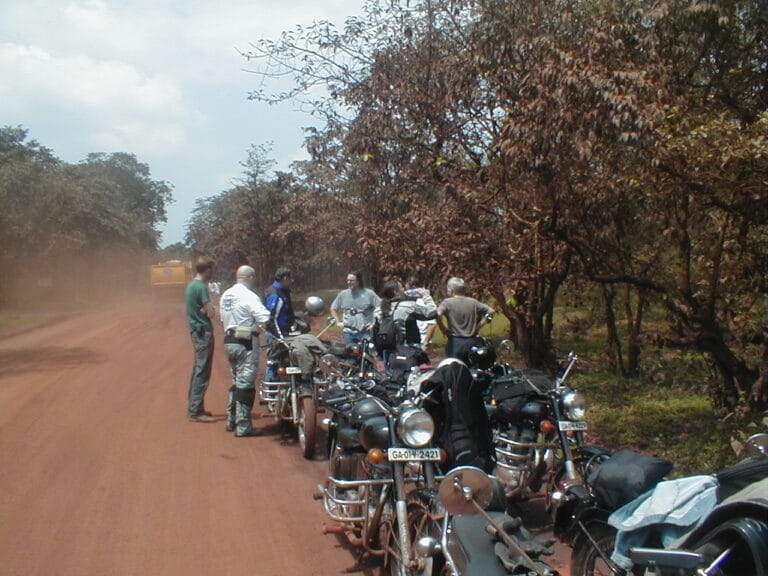
I should also say that at this time we had no idea where we were going or what kind of places we were to stay in each night. The tour was run on a “need to know” basis which worked very well as each stop was different to the last and was a surprise. As well as the paying customers the group consisted of Ryan the leader, Jamal the mechanic and tail ender, Clint an outrider, Ali the support vehicle driver and Josie the medic, who sometimes rode in the van and sometimes pillion with Jamal. At times we did get spread out but Clint’s job was to drop off at the junctions to make sure we didn’t miss any turnings. This system worked well and no-one got lost.
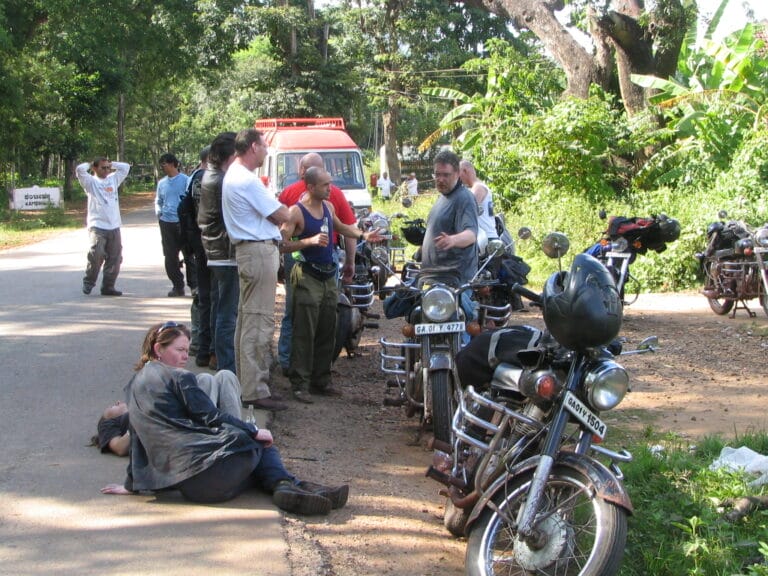
Once the track came to an end we had about 30 miles of a wonderful biking road, empty of traffic and lovely sweeping bends on a well surfaced road before suddenly arriving at our destination for the night. Totally unexpected it was a jungle camp consisting of mud huts and a restaurant. 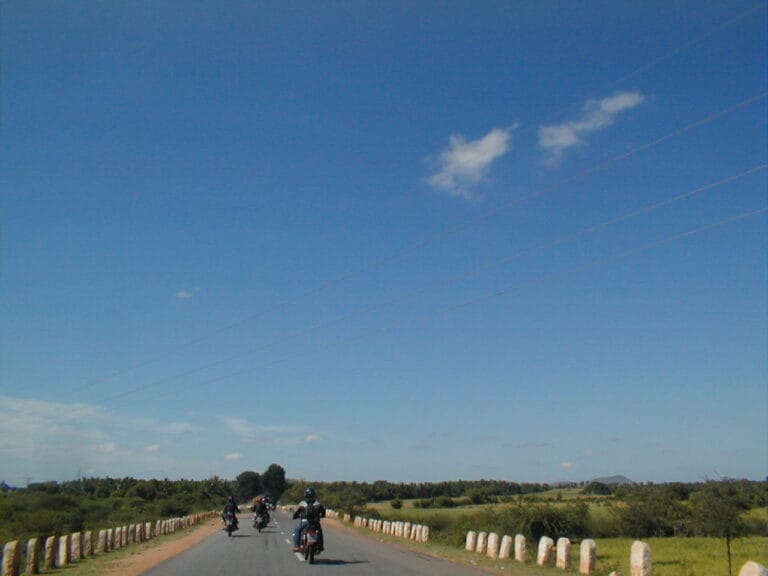
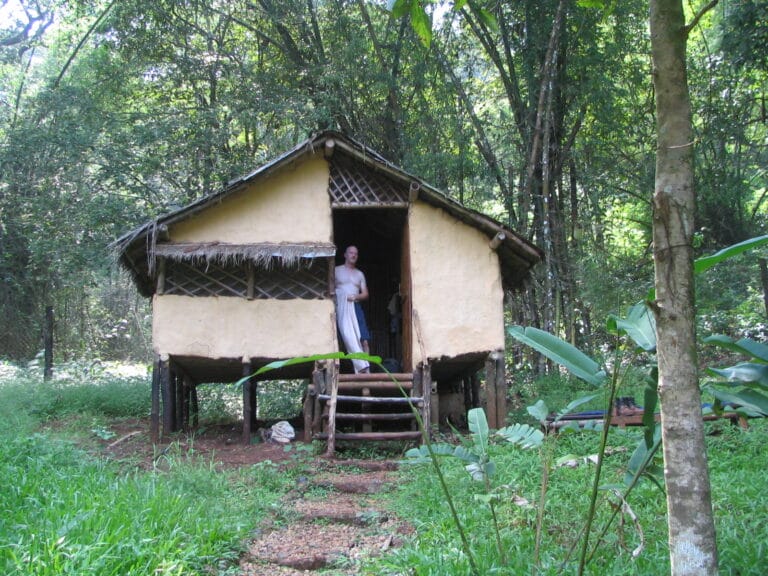
Because we’d had such an early start it was only just lunch time when we arrived, which gave us plenty of time to enjoy some white water rafting before gathering round the campfire and enjoying a few Kingfishers.
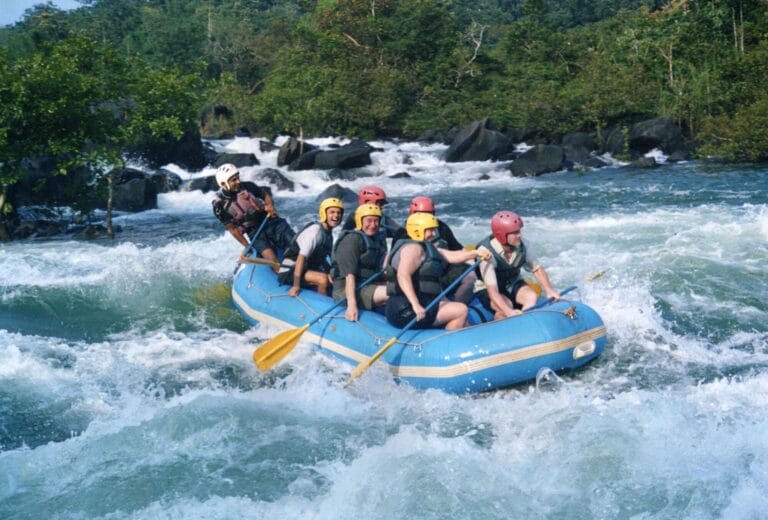
The campfire and the Kingfishers were to become a regular ritual over the next 10 days or so. 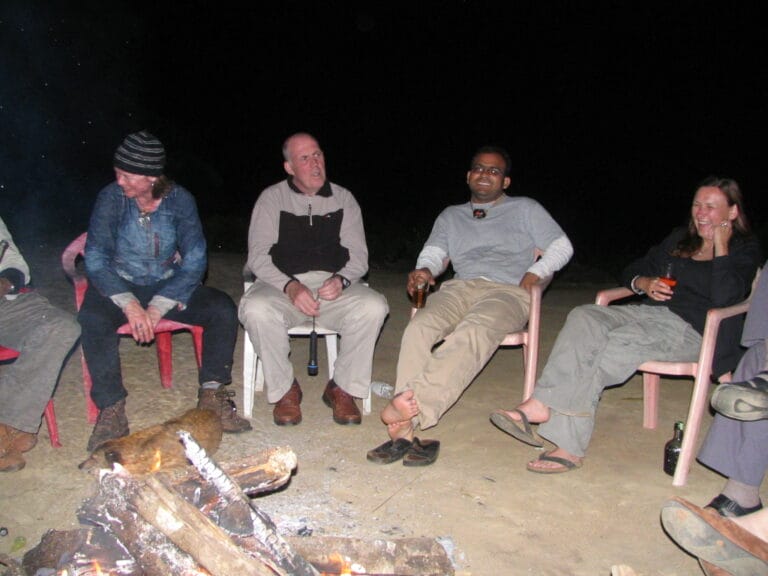
The following morning saw a more leisurely start after a traditional Indian breakfast of chapattis, eggs and coffee. The bikes were now covered in a layer of red mud and were to remain that way until our return to Goa. We had quite a long ride that day and it wasn’t far off nightfall when we arrived fairly exhausted at our hotel near Hampi. We had ridden through a couple of extremely busy towns on the way and we needed all our wits about us to avoid the manic car drivers, bike riders and tuc-tucs. Everyone drives very assertively, bordering on lunacy, and we had to do the same otherwise it would be impossible to get through the intersections or make any progress. We soon learned that the horn was one of the most important features of the Enfield, as with any other vehicle on the road. It needed to be used loudly and frequently – essentially the idea seems to be that indicators and lights mean nothing you just have to let the guy in front know that you are there by ‘beep-beeping’. Correspondingly we also needed to use our ears because that’s how we find out who’s behind, or in front, or to the side.
Hampi is well known for its selection of Hindu temples and monuments. The bikes were left unused the next day as we assumed the role of normal tourists and signed up for a guided sight-seeing tour. We spent the morning viewing temples in the baking heat before being led to a delightful outdoor restaurant, known as the Mango Tree. This was a vegetarian open air eatery with great food and a magnificent setting, overlooking the river valley. We sat crosslegged on the terraces watching men fishing in coracles, water buffalo being bathed and women pounding washing in the river to clean it, the light was unbelievable. Fed and watered we crossed the river in a small ferry and then were off climbing hundreds of steps up nearby monkey mountain to see the wild monkeys who lived there and the temple to Hanuman – the Hindu monkey god and the monastery at the very top. We stayed there to watch another beautiful sunset and gazed at it along with the monkeys who seemed just as mesmerised as we did. We had to be careful on the way down as darkness was falling quickly.
Another days riding saw us in a small town, the name of which neither of us can recall. The hotel here was probably the worst we had during the trip. Cockroaches in the bathroom and sheets that didn’t look as if they’d been cleaned too well weren’t all that welcome to us tired travellers. Fortunately we’d brought a couple of silk sleeping bag liners with us for just such occasions. A stroll around the town that evening combined with some sight-seeing around the centre kept us occupied before eating.
An early wake-up call saw us breakfasted and on the road at sun up the next day. We rarely rode for more than an hour and a half at a stretch. The various different roadside stops all added to our experience of this incredible country. Small huts selling just the local tea known as chai, roadside stalls with soft drinks, coconut sellers in the middle of nowhere and restaurants of varying size and quality were all eagerly enjoyed. 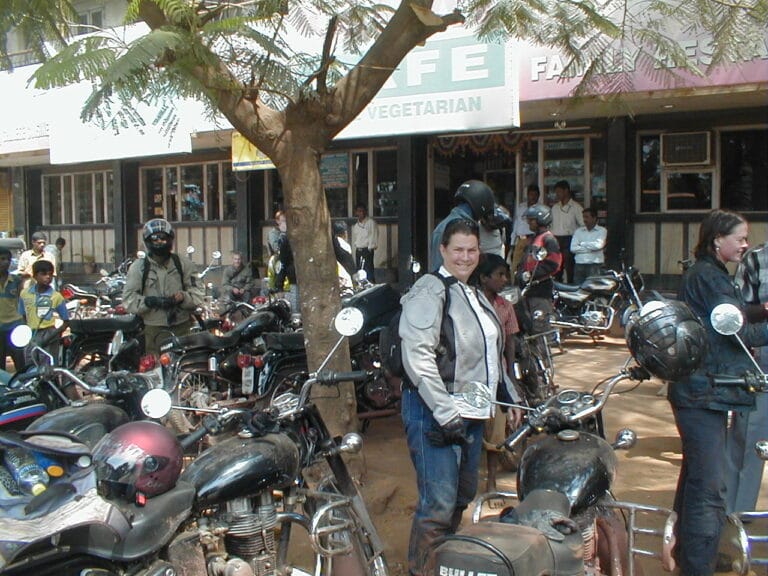
The reason for tearing us out of our beds at that hour wasn’t because we had a long journey but so we could arrive at our next destination of Mysore at a reasonable time. Mysore was to be our main opportunity to do some shopping. It was the largest town or city on our route and is well known for silk goods, sandalwood carvings and jewellery. After a short lie down in what was probably the grandest hotel of the trip we went for a wander. We tried our best to avoid the constant haranguing from the street vendors, would-be guides and beggars but we couldn’t shake off one young lad who insisted on tagging along with us. Eventually we let him show us around and we followed him from shop to shop (all part of his itinerary) whilst he gave us a running commentary of the town and its people. We got away without spending too much, although our daughter Rowanna’s wardrobe now includes a silk sari.
Breakfast the next day was enlivened by watching one of the local monkeys stuffing himself with the freshly cooked rice one of the chefs had laid out on a table to cool and then playing games with the chef as he tried to chase him off. Made mental note not to eat boiled rice for the rest of the trip. One or two of our party did suffer quite badly from the local food at times, but Vanessa and I fared reasonably well. Mainly, I think, because we tried to avoid the meat dishes and the rice. Chapattis are always freshly cooked and vegetable dishes don’t suffer from undercooking in the same way as meat can. There was always a good selection of vegetarian dishes. Meat, when offered, was usually chicken, lamb or possibly goat. Cows are sacred of course so don’t appear on the dinner table and you wouldn’t eat the pigs either once you’ve seen what they live on!
Moving further South saw us leaving Karnataka and entering the department of Tamil Nadu. We were now in a nature reserve and we chose to ride the last 20 miles or so without helmets so we could appreciate the sights and sounds of the wildlife around us.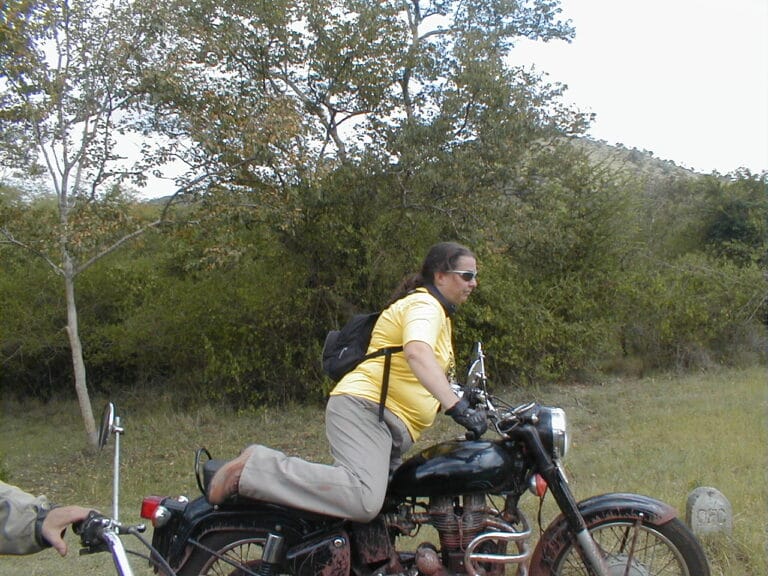
This was to be the furthest point of the tour from Goa and was one of the highlights. The Jungle Retreat is set in the middle of a nature reserve, where wild animals roam. We didn’t come across any tigers but we did see plenty of wild elephants, monkeys and deer. Unfortunately for us our visit coincided with the Hindu festival of Diwali and the constant noise of fireworks from the villages around and about kept most of the animals under cover. We spent two nights in this wonderful resort, housed in our own bamboo hut and made full use of the outdoor swimming pool in the mountains when we weren’t on a nature ramble or visiting the nearby elephant camp.
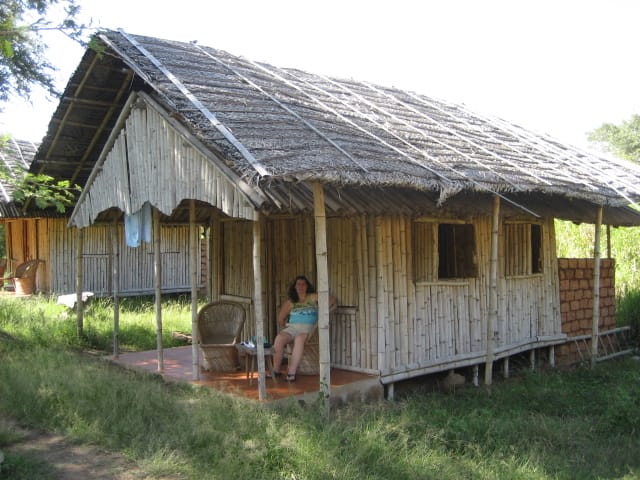
Leaving the Jungle Retreat we were now passing through coffee and tea plantations as we started the long trek back towards Goa. Our overnight stop was in the middle of a coffee plantation in a large dormitory. Being the only couple on the trip Vanessa and I were given the honour of the only separate room to ourselves. The following morning saw another early start on the road and a disaster for Vanessa. We’d been on the road about an hour by 7:30. The group had become a bit disjointed and I was following a couple of bikes behind Vanessa. I saw a bike go down suddenly and my worst fears were confirmed when I got closer and saw it was Vanessa. She lay in the road groaning, her mangled bike on its side some feet away. I just let my bike fall as soon as it came to a stop and rushed over to her. Josie(the medic) was right behind me yelling at me not to try to move her. A couple of the other riders who were with us quickly set up a warning for other road users as there was a very real danger that another vehicle would come hurtling round the bend and straight into us. A crowd soon gathered as Josie was working furiously to try to assess how bad the injuries were. Eventually we got her on a spinal board and into the back of the minibus to take her to hospital. An optimistic prognosis by Josie was a dislocated shoulder, but unfortunately it turned out to be a broken collar bone. By the time we left the hospital, Josie, Vanessa and myself were on our own, some 150 miles from the beach resort where the others were spending the night. I rented an ambulance, which was really a private taxi with room for a stretcher in the back. This was probably the hardest day of the trip for all of us. The taxi ride was an incredibly tedious journey and very painful for Vanessa. The others had also had a really tiring day. The traffic had been very heavy around Bangalore and the roads had been truly awful for most of the ride. Plus of course they had all been delayed because of the accident so they’d been pushing to arrive before nightfall. Another incident that day saw Jamal run off the road by a passing car, fortunately without injury, but the day’s events made everyone realise how vulnerable we all were. Much of our own journey was after dark and it was very late by the time we arrived. The resort, on a stretch of beach known as Turtle Beach was a very pleasant place to stay but unfortunately neither Vanessa nor I were in a position to enjoy it.
The next day saw me back on the bike and Vanessa travelling in the minibus, mostly drugged up with painkillers to try to keep her semi-comatose. We spent the day mostly following the coast Northwards. We already knew that our planned overnight stop that night was going to be camping wild on a beach. Paradise Beach is known for its remoteness and tranquil beauty. It’s also a favourite destination for hippies and dropouts, despite the numerous attempts by the authorities to try clamp down on the strange substances they bring with them. It sounded idyllic but not really what Vanessa was looking forward to. We tried to find a hotel or guest house as we approached the beach but with no success. Vanessa was too drugged up to really know what was going on and we didn’t really have a choice so after we’d parked the bikes in a safe location and sorted out our belongings for the night we bundled her into a small motor boat with the rest of the party and we all went for a short boat ride round the headland to get to the bay. Josie and Ryan did their best to try organize one of the huts for Vanessa and myself but by the time they had succeeded it was dark and Vanessa was already half asleep on the beach so we stayed where we were.
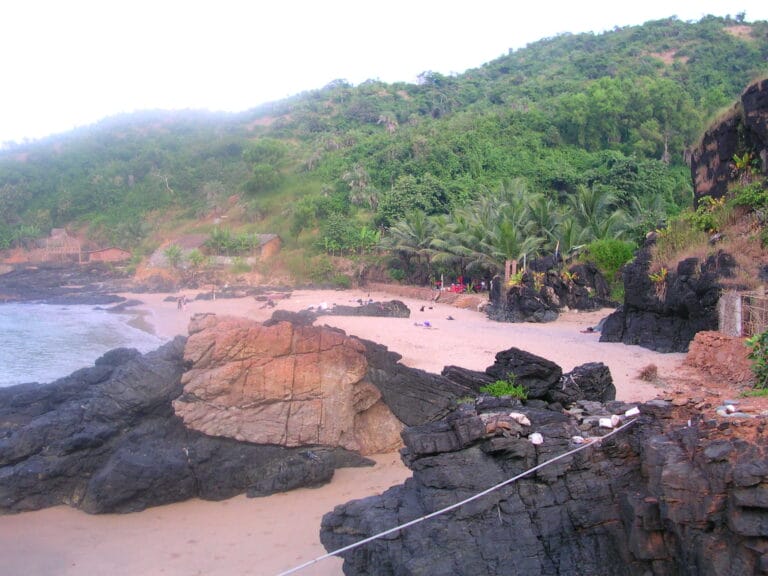
Most of us managed a swim in the sea at some point during our stay at Paradise Bay and it was so warm. It really was like taking a bath. The next day was to be our last day on the bikes as we started the homeward run back to base. We had a late start and everyone was now riding extremely carefully so as to avoid any incidents on the last day. We were riding alongside the coast for much of the way with a pleasant sea view to keep us company.
Vanessa was getting more and more uncomfortable and the return to the seaside temperatures after the relative coolness of the hillier interior wasn’t helping. I asked Ryan to phone ahead and try arrange a European standard hotel for us with air-con. I felt the most important thing now was to get Vanessa somewhere where she could be as comfortable as possible. The hotel they found for us was a wonderful place, known as a boutique hotel, although it was very expensive, even by European prices. Despite Vanessa’s injuries we did enjoy the last week on our own after we’d returned the bikes and the rest of our party had left for home. We didn’t ride any more bikes, although we did hire a little jeep for a few hours to give Vanessa chance to get out a bit. Other than that we spent a lot of time lazing around the pool and drinking the local rum.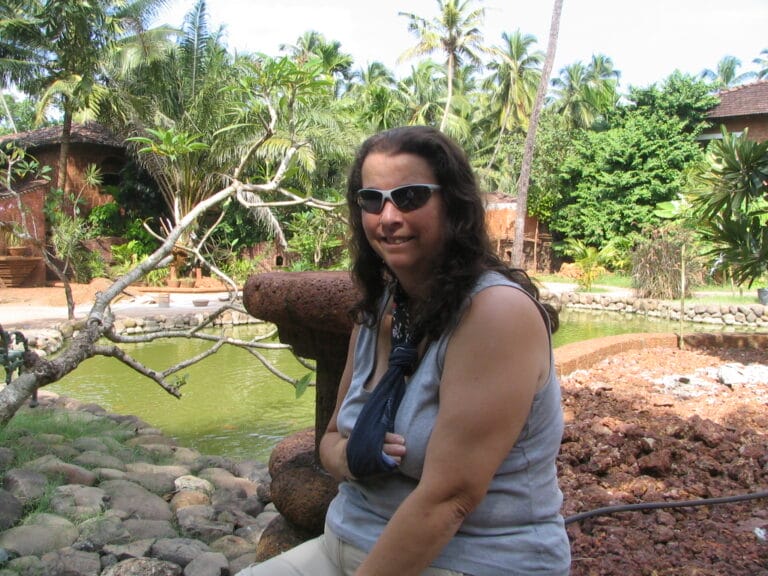
Would we go back? Yes we certainly would!
Editor’s note: A short while ago, we were contacted by Gordon May, our lead into Royal Enfield UK, about an opportunity involving the Goodwood Revival event. They were taking some of their classic RE collection to take part in the early morning Motorcycle Parade laps around the track, and invited us to supply up to six classic (pre-1966) machines to add to theirs. Various incentives were offered. Given the rather short notice there wasn’t much that most of our members could do, but one, Roger Allen, managed to make it there, with his 350. Here is his story.
A couple of weeks ago I had the honour of riding my 1961 350 Bullet on the opening parade at this year’s Goodwood Revival.
The daily parade consisted of nearly 200 bikes doing a couple of laps at the start of each day.
I learned of the parade from a post by John Dove on the club’s Facebook page which said anyone who wished to participate should get in touch. I didn’t have to think about it twice!
I’ve been going to the Goodwood Revival for the last 6 years as a Track Marshal and was chosen to do the same this year. I got the okay from the Chief Marshal to take part in the parade and was allocated to a post that would be easy to get to when the parade finished.
It wasn’t until mid-August that I received an email from the Duke of Richmond inviting me to take part in the parade. Unlike other motor racing events, you don’t apply to take part you have to be personally invited. There are strict rules and only pre 1966 Vehicles are allowed inside the circuit during the meeting, and there is a dress code that you are strongly encouraged to follow.
I decided that I would take my newly acquired 1961 Redditch built 350 Bullet which was an impulse buy just a month earlier. I bought it from a fellow REOC member, Ted Smith from Colchester, who had owned the bike since 2000. I wasn’t looking for a 350, but Ted had maintained and looked after the bike so well and I decided that it would be difficult to find anything better – plus it sounds awesome!
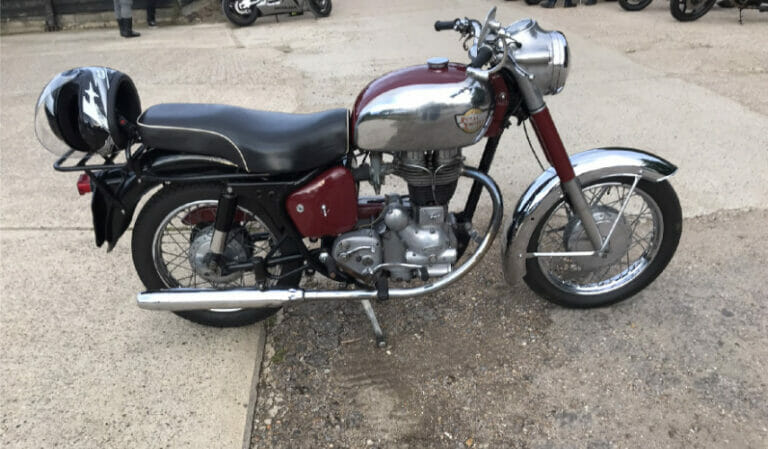
So, I had the bike but nothing much to wear to look the part of a 1960’s biker. I found my uncle’s old pudding basin helmet and a pair of goggles. I managed to pick up a decent well-worn motorbike leather jacket for £40.00 and, with the addition of a white t-shirt, jeans, and boots with fisherman’s socks turned over the top I started to look the part.

A few days before the event I received my driver pack which contained two sets of passes and several vehicle passes, one of which allowed me to deliver the bike to the circuit. The signing-on was on Thursday, so we set off from Colchester early Thursday morning (06:30am) and arrived at Goodwood by 10:30 – which wasn’t bad going driving a motorhome with a trailer.
Displaying my many passes we were waved onto the circuit and told to go to the area near the start / finish line. Unfortunately, this wasn’t the correct location so we were sent around the track again to another location. We eventually found where we needed to be and set off to the Pilots Club to sign on where we were given more wristbands, badges, and meal vouchers. By the time we got back a number of bikes had already been unloaded and parked up. We unloaded my bike and made sure everything was ready for the next day.
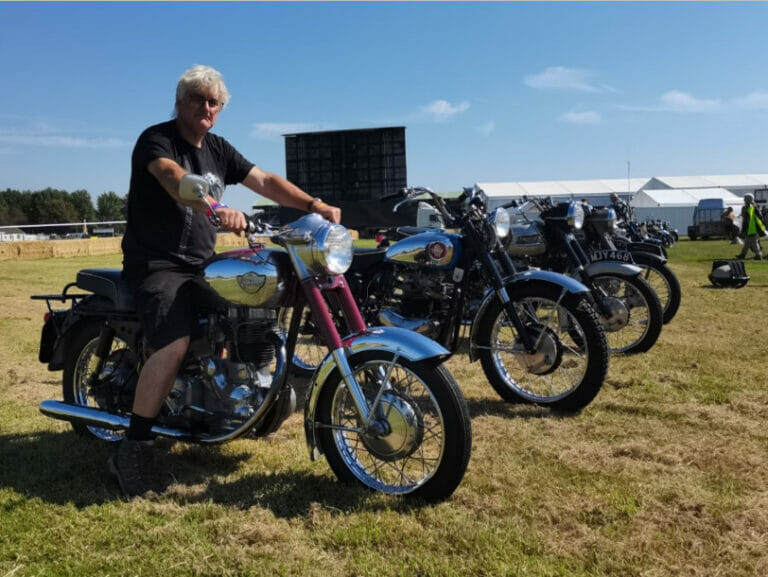
The next morning (Friday) I got to the circuit at 07:30 as I had to sign in as a Marshal. That done I was straight over to my bike. The parade wasn’t due to start before 09:00 so there was plenty of time to get ready. At 08:00 there was an air display with 3 Spitfires which was pretty awesome.
We were assembled in an area along the Lavant Straight. The gathering of so many bikes in a small area impacted all of your senses – sight, sound, and smell – you could taste the fumes! Sidiq Khan would not have approved.
The plan was to be led from the assemble area by the safety car, an E Type Jag, to the start line. We would line up on the grid for a short period of time until the Union flag was waved, signalling the start the parade behind the safety car.
As with other parades, I had assumed it would be limited to around 40mph behind the safety car, however, I think the safety car driver thought he was doing the green flag lap for the F1 as he shot off never to be seen again.
I took it fairly easy for the first lap, but the rest of the pack had started to disappear so I quickened the pace. The track was in perfect condition, and it felt very comfortable. I enjoyed every minute of it. The crowds were very supportive, clapping and waving as we went past.
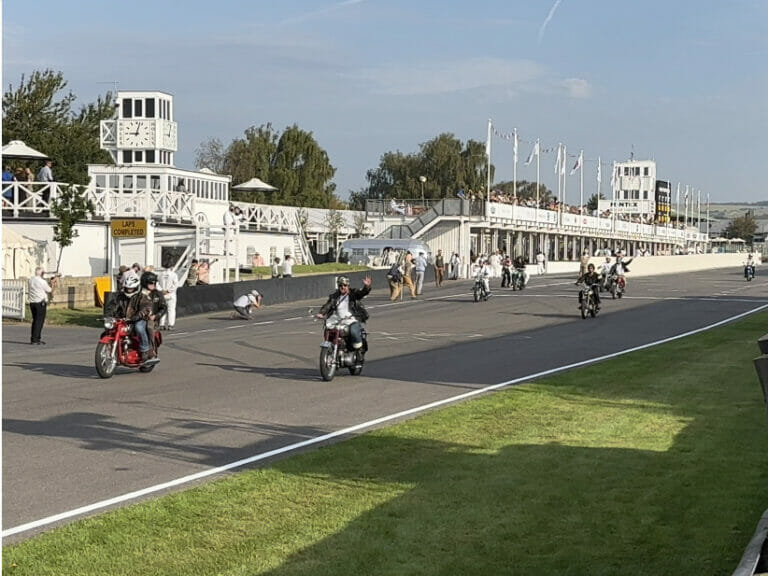
Unfortunately, Royal Enfield was in the minority, but I did manage to get a few pictures of other RE’s taking part.
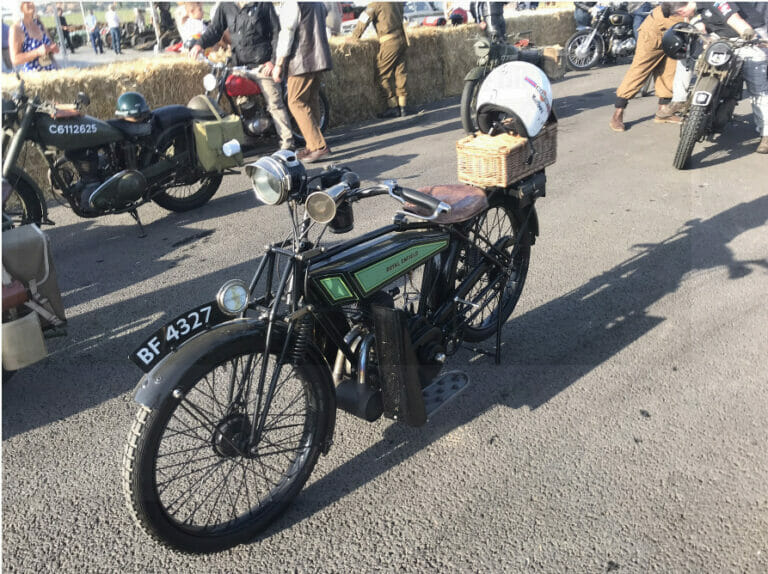
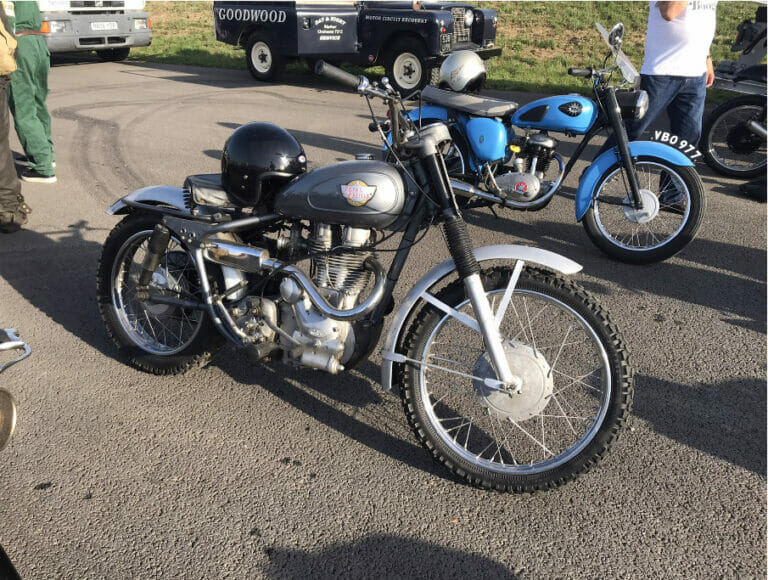
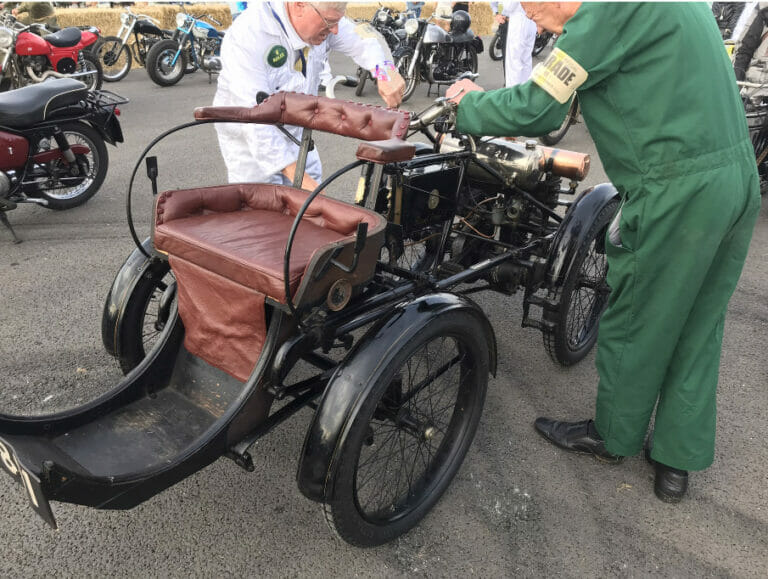
If you are ever given the opportunity to take part in something like this I would highly recommend it.
If you want to see more of this year’s Revival, do a search on YouTube Sky Livestreamed as all 3 days are available to watch. (Editor’s note: If you watch this video,which will open in a new tab in your web browser) Roger is visible on his 350 at around the nine minute ten seconds mark)
I would like to thank John Dove for putting my name forward, my fellow marshals for standing in for me whilst I was gallivanting around the track, my friend Graham Rose for lugging all my gear around, and my daughter Lucy for bringing refreshments and taking photos.
Ian Tompkins wandered around the venue and took the following pictures, which he has very kindly made available to me to add to the website. Thanks Ian!
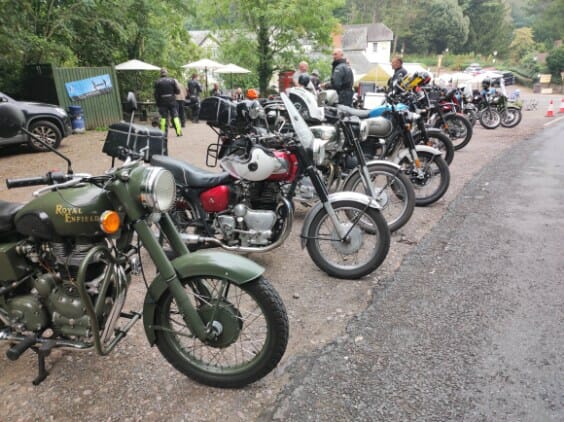
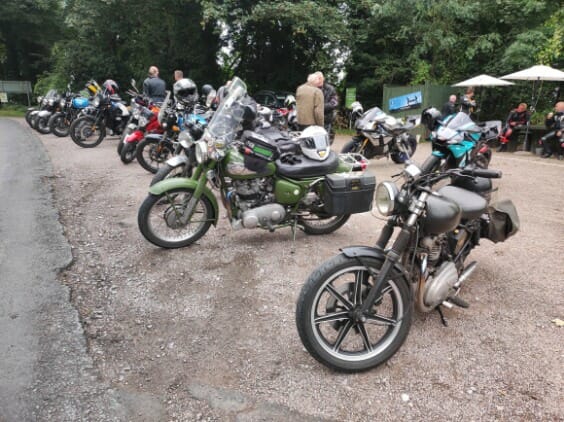
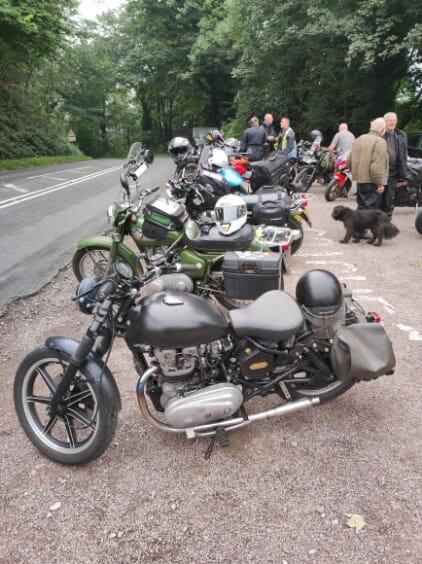
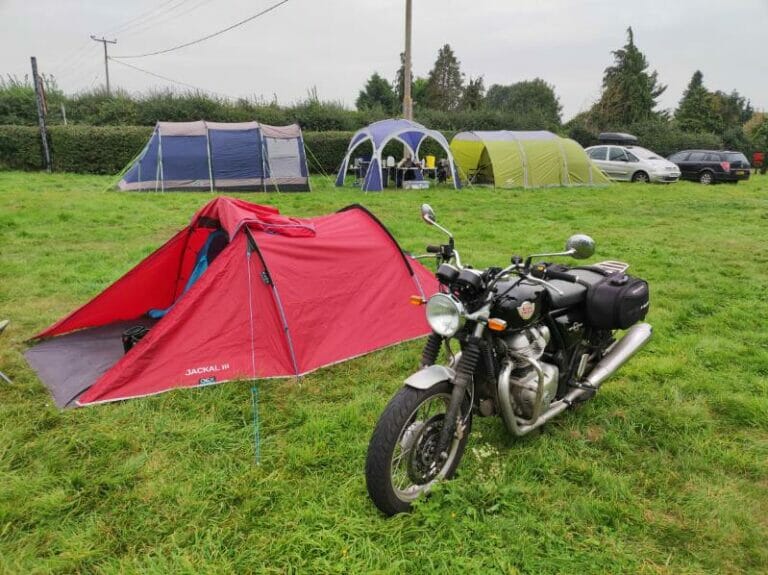
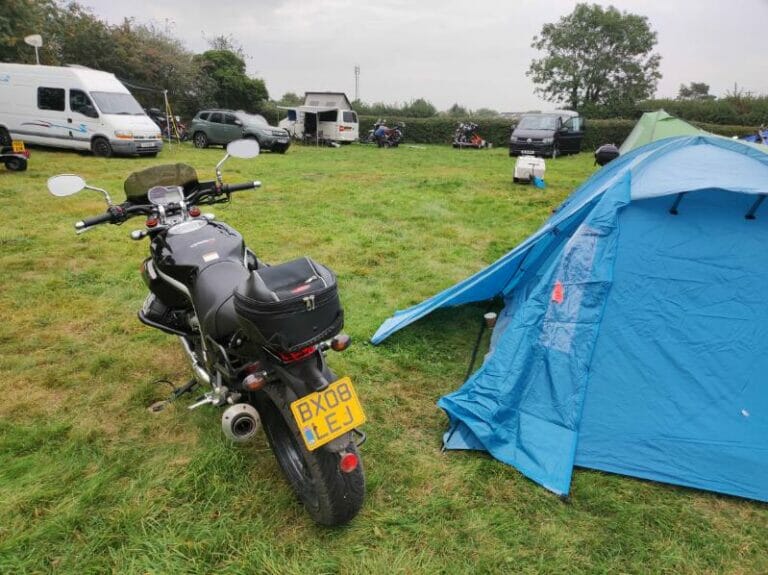

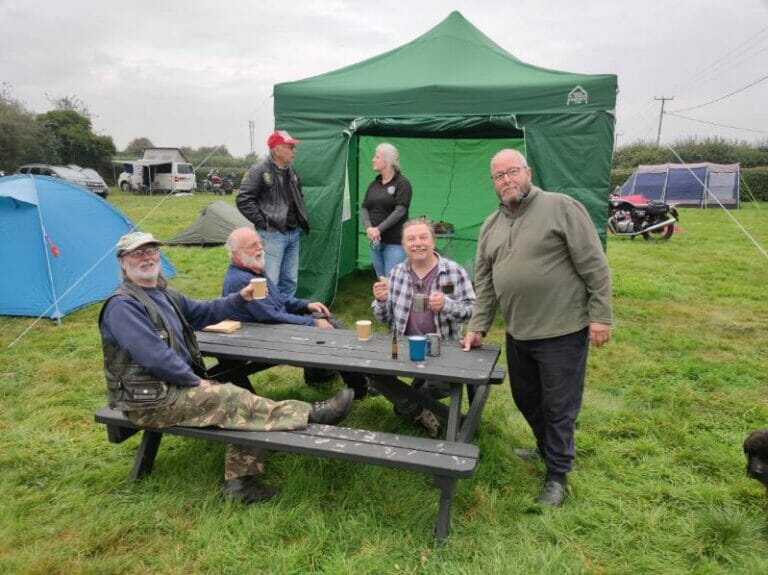
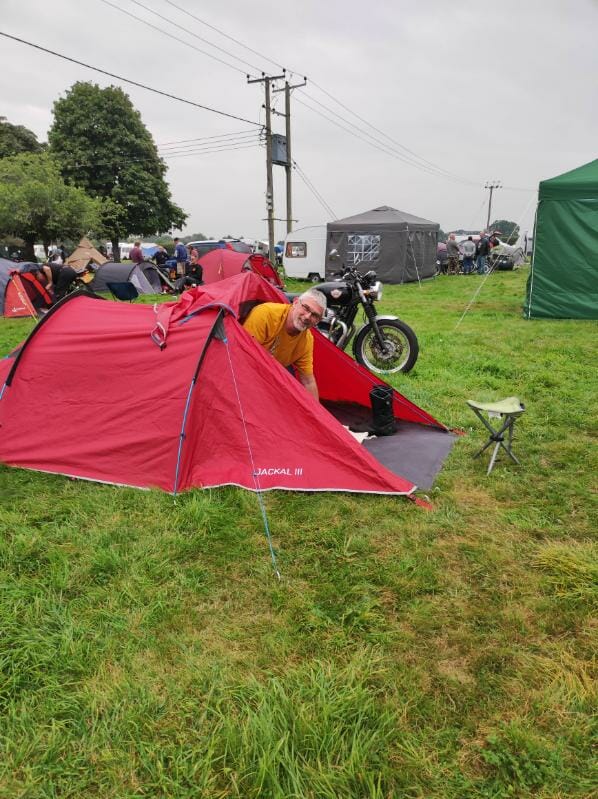
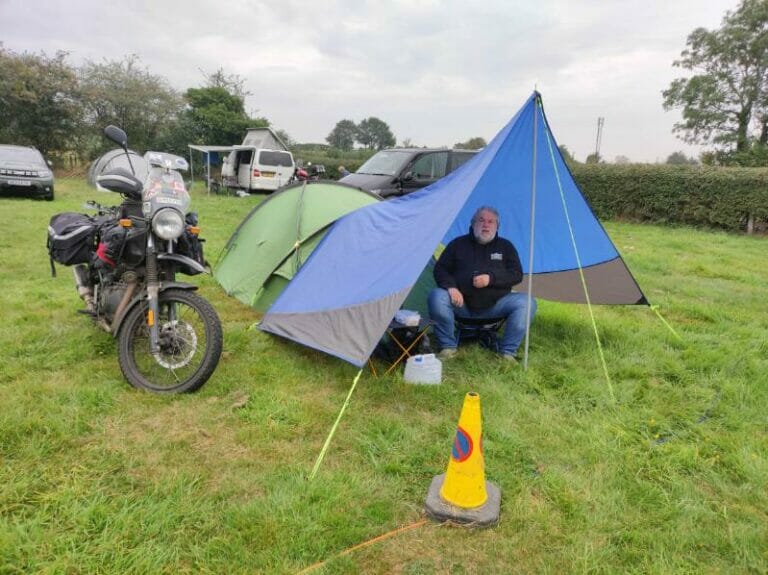
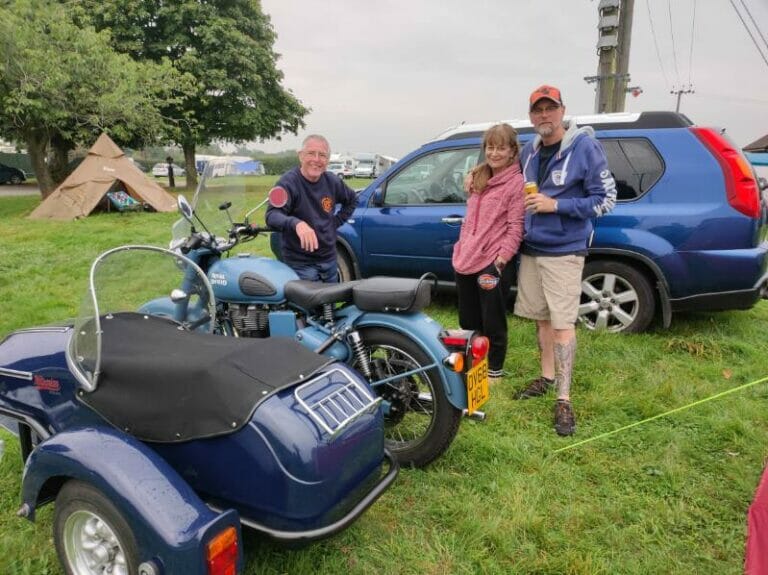
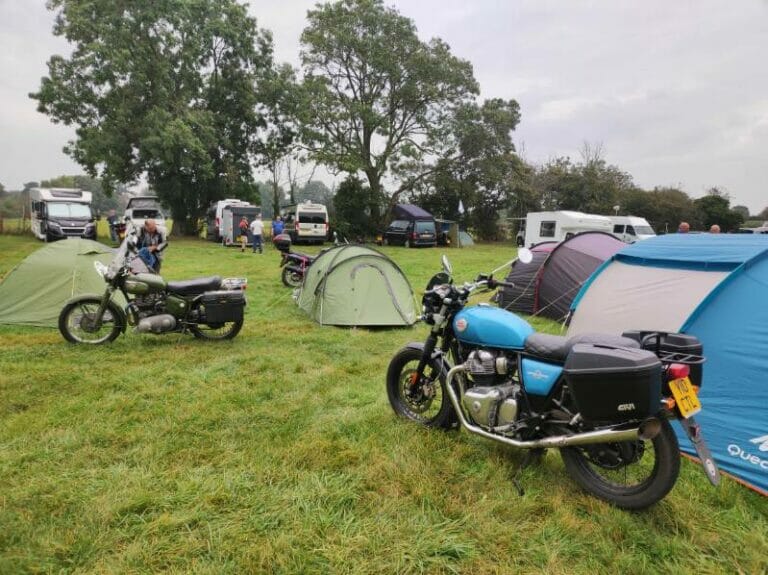
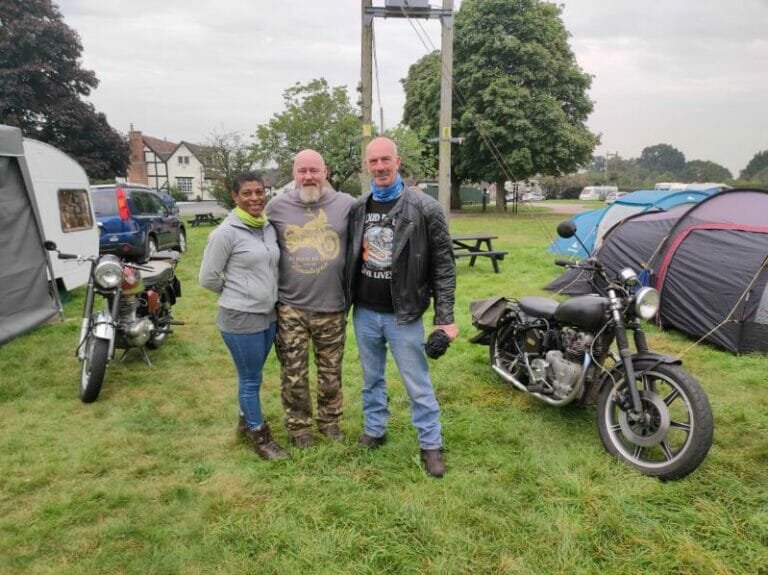
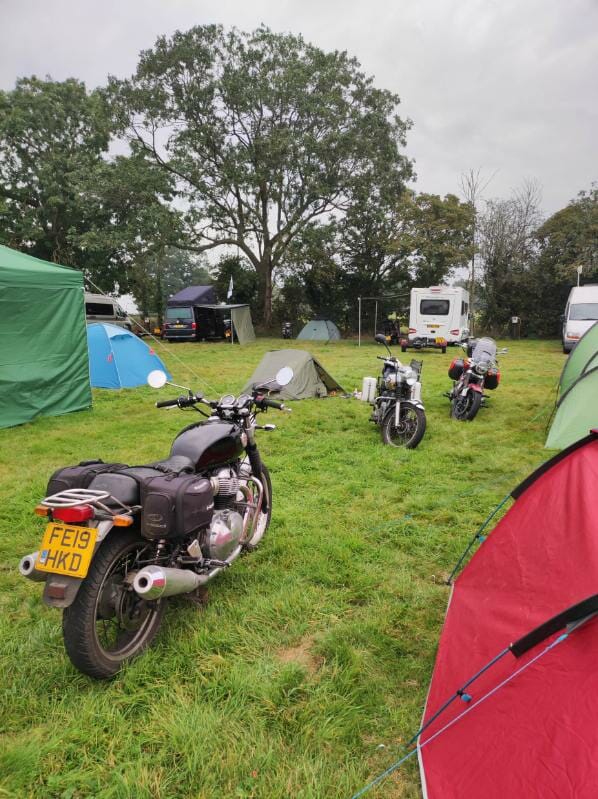
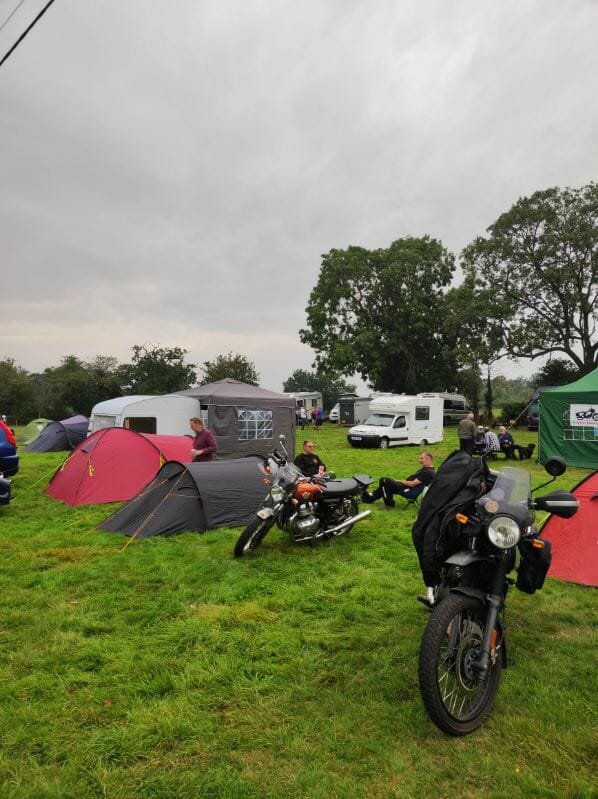
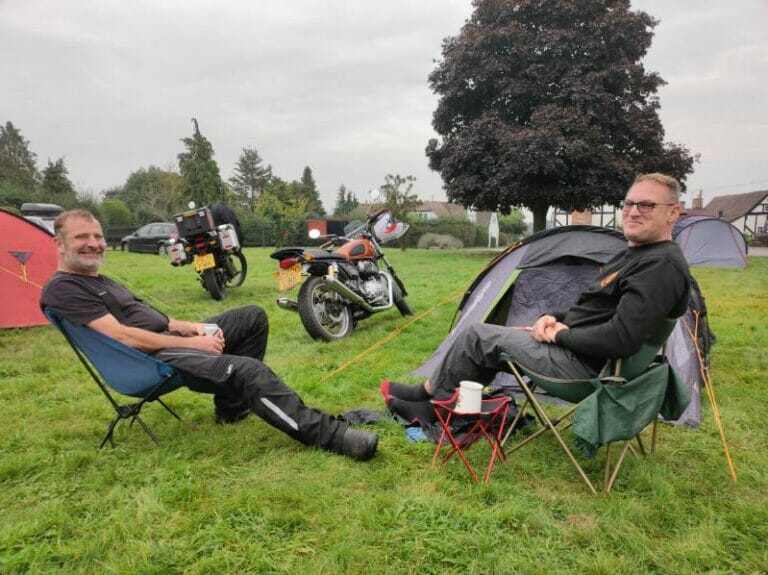
Early G2 Bullet trials machine build.
A few years ago I acquired a lovely 1951 G2 Bullet with original features. The bike came with an incomplete and somewhat unloved sibling. A brief record check on the second machine showed it to be a numbers correct earlier ‘swing-frame’ G2 that left the Redditch factory on the 17th of February 1950.
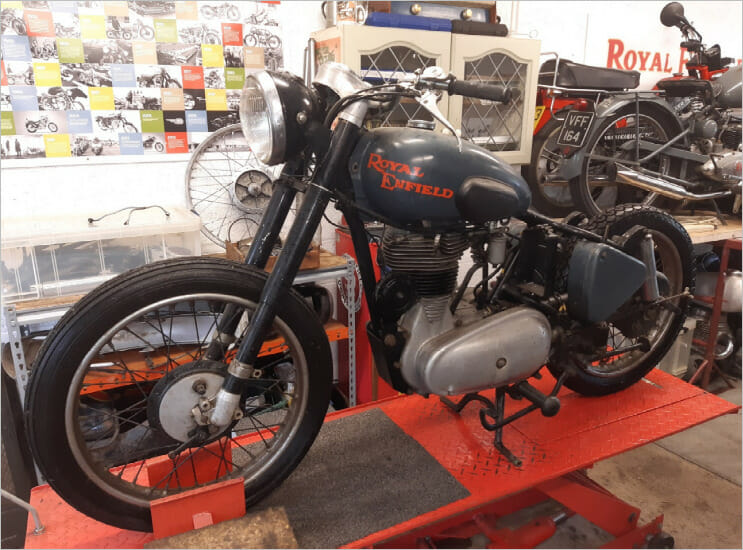
The forlorn and incomplete Feb 1950 G2. Oddly the bike came with a couple of features seen on early trials models; chrome rear shocks and the extra lug on the lower fork casting.
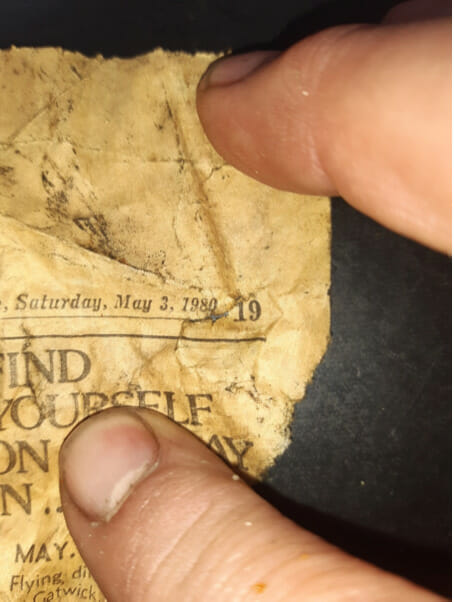
Toolbox contents showed the bike’s last-active date.
The forlorn G2 rested for a year or two while until my frustration with a 1963 ‘New-Bullet’ trials machine finally got the better of me. Getting the unit construction NB to ‘stomp’ like it’s a semi-unit forebear was beyond me. After three years of running mods I could only put that down to flywheel weight. On the upside that moment of clarity did cause me to consider the benefits of doing something constructive with the 1950 G2. Hence the Trials-Bullet project began in haste – I have yet to repent.
Initially I had planned to build a “found it in the spares pile” machine but test rides on a couple of Royal Enfield trials machines built by Steve Goodman persuaded me that I would be well served if I enlisted the help of an experienced trials bike builder. Although I have rebuilt a few REs it has become apparent to me that building a trials bike, a good competitive example and not just a green lane style machine, requires function specific experience and lots of it. Just like riding a trials bike; the skill set required to build one varies dramatically from usual road bike considerations.
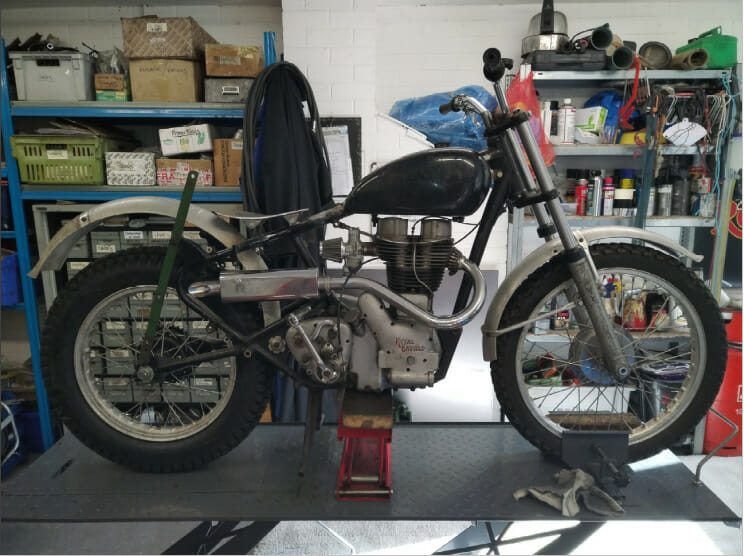
The mock up ‘spares pile’ variant in October 2022. Excelsior Consort tank, MP forks and cut down RE front hub.
Discussions with Steve highlighted the extent to which his Bullet builds utilised modifications for improved running. To reiterate; these were trials specific mods. For the sake of brevity let’s just look at a couple of points if interest. Firstly the squish head modification and fuel choice. For a longer burn, E5 fuel with Tetraboost additive is used to produce a five star leaded equivalent. Used in conjunction with the combustion chamber mod for squish the effect is dramatic. The mod started with the chamber sides being welded in before milling for clearance could happen. As an aside; initially the welder could not get the material to take until he tried rods with higher magnesium content.
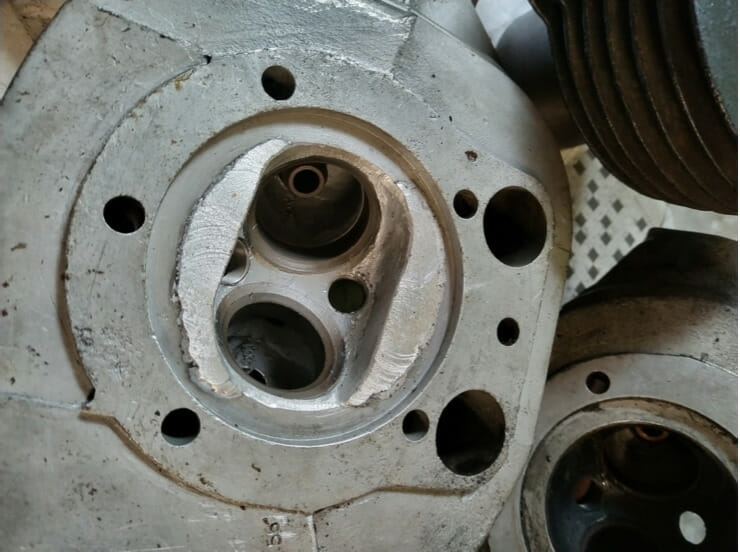
Squish combustion chamber used, in this instance, with a flat top piston and alloy barrel.
Any off road rider knows that weight-saving is never a bad mantra when undertaken sensibly. After some discussions we opted for Steve’s suggestion of removal of the downward frame tube that braces the gearbox top mount. The frame was extended rearwards from the top tube and braced horizontally across to meet the rear loops. Making it much like the post 56 frames in that approach.
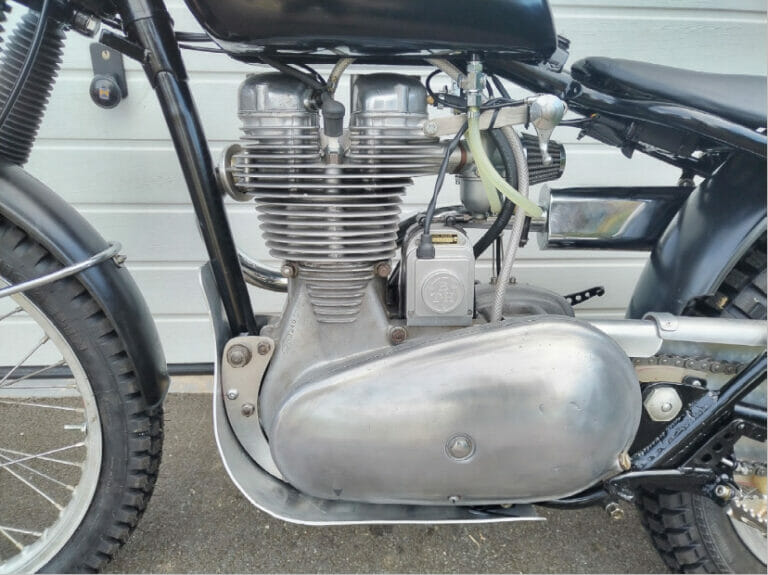
Conspicuous by its absence, the missing gearbox frame brace saved weight and offers clean lines.
The picture also shows signs of more practical mods such as the alterations to the early Bullet ‘crank end through outer primary breathing system’ which was impractical for trials application. Eagle eyed readers’ will spot the alternative breathing route used. Thanks to Wayne at Hitchcock’s we were able to acquire an early WDC timing chest to save the weight over the stock filtered variant. In truth I also wanted to doff my cap to John Brittain’s filter-less trials machine. A 630 concentric carb came from the same supplier and the rear shocks from Feked.com. Slinky glide cables were made to measure and the stock MP (Metal Profile) fork springs replaced with a selection of three springs portioned accordingly. Steve modified the exhaust to a clamp rather than strap type retention which facilitated a tighter line for the downpipe. A constant tension chain guide was used in preference to a sprung roller tensioner. The list goes on. As I suggested earlier; building a competitive trials machine requires lots of experience that is not gained from building road bikes.
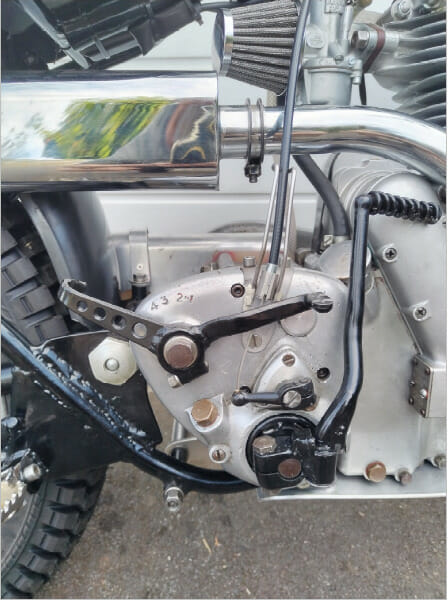
Modified external clutch mechanism type gearbox.
The clutch pull mechanism was rotated to allow clearance and the neutral finder repurposed as the gear change with a heel and toe lever. Foot pegs are in the latterly favoured position of being placed level with the front of the rear tyre at the height of the sump. This positioning gives a very ‘planted’ feel.
A real plus comes in the fact that the bike weighs in at 258 pounds with oils and a gallon of fuel on board. Could we have saved more weight by using a smaller alloy tank? Undoubtedly but I like the look of the spares pile Consort tank and it does lend itself to a vintage look. How far do you go with weight saving? Well for an average clubman rider like me that is a rabbit hole best peered into rather than jumped into.
With the local trials season starting on September the 10th the bike will need a few more shake down runs to be fully ready for action. The Taverners events that the bike is aimed at are set out for pre 57 machines and are endurance trials of eight laps of eight sections. Wish me luck!
JD, Midshires Branch,
A UK Member’s adventure to the International Rally, Greece, June 2023
By Simon Gibson – posted 13th August 2023
(A note from the editor: There are a number of mismatches between the photographs that were supplied, and the numbering in the text. I have tried to insert the photos in the correct places in the text, and have edited some of the numbering in the text where it seemed incorrect, but I apologise for any discrepancies – I can’t edit the numbering that is embedded in the pictures. I hope that this does not spoil your enjoyment of this article)
There will, I’m sure, be many accounts of the fabulous Greece International held in early June 2023 and so I thought it might be of interest to others to describe my journey to and from the rally.
With the luxury of retirement, fellow Lincolnshire branch member Simon Thackray and myself could span our journey over 5 weeks, with Simon on his new (3/2023) Tiger 660 sport and me on my (9/2020) Interceptor. As attractive as the generous discount Andreas had negotiated with the ferry company was, the chance to ride down through the Balkans was too good to miss on and that decided our outward route. Having been fascinated with tales from Greek mythology at primary school it seemed natural to return from Greece via a ferry to Chios and then on to Turkey, to visit Ephesus and Troy and then pay our respects in Gallipoli. A visit to Istanbul by train and then back via Bulgaria, Romania, Hungary, Slovakia, Austria, Czechia, Germany, Belgium and France was the plan.
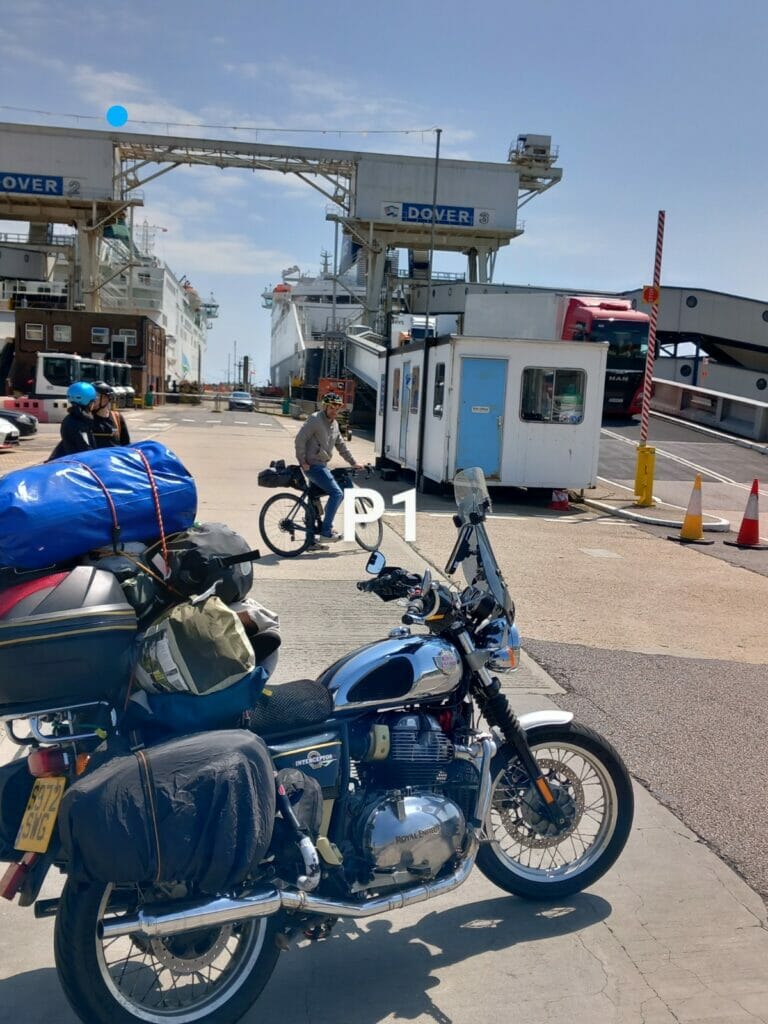 21.5.23 – As a long suffering Leeds United fan, Simon wanted to go to the penultimate game of the season at West Ham and so I met him at a Premiere Classe hotel in Dunkirk (P1) on the Sunday evening of 21st May 2023.
21.5.23 – As a long suffering Leeds United fan, Simon wanted to go to the penultimate game of the season at West Ham and so I met him at a Premiere Classe hotel in Dunkirk (P1) on the Sunday evening of 21st May 2023.
Sadly the breakfast at the Premiere Classe was not very inspiring and we have noticed how, like so many things they have been trimmed down to basically bread and jam, when it was cheese and meats etc about 20 years ago.
22.5.23 – A rather boring ride through Belgium (to keep off the French motorways) took us to Luxembourg, where petrol used to be considerably cheaper, but again no longer. We observed that an “L” for Luxembourg on a number plate usually also indicated an aggressive and impatient driver. We had a quick look at the Maginot line forts and some interesting propaganda (P2) before staying at the Kyriad hotel in Hagenau for the second night.
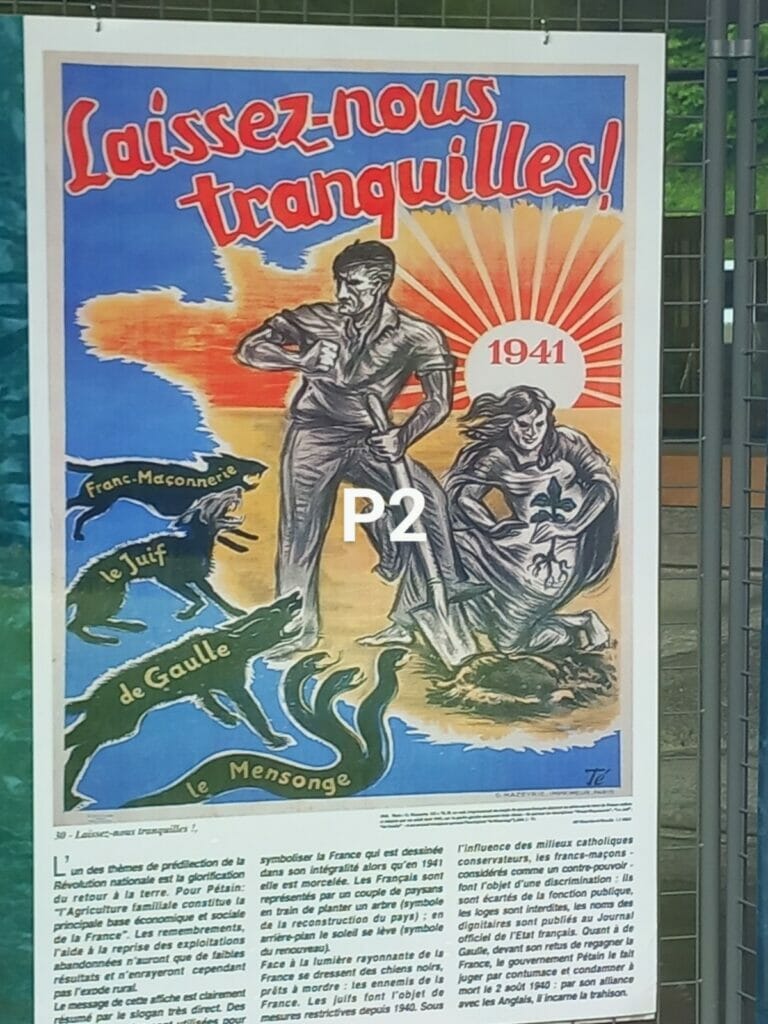 23.5.23 – Set off to overcast skies on Tuesday morning for our ride through the Black Forests’ famous 500 road. Unfortunately as soon as we crossed the Rhine the rain started and did not stop until we arrived at a campsite in Fussen in southern Germany, but at least we could put the tent up without the rain. (P3)
23.5.23 – Set off to overcast skies on Tuesday morning for our ride through the Black Forests’ famous 500 road. Unfortunately as soon as we crossed the Rhine the rain started and did not stop until we arrived at a campsite in Fussen in southern Germany, but at least we could put the tent up without the rain. (P3)
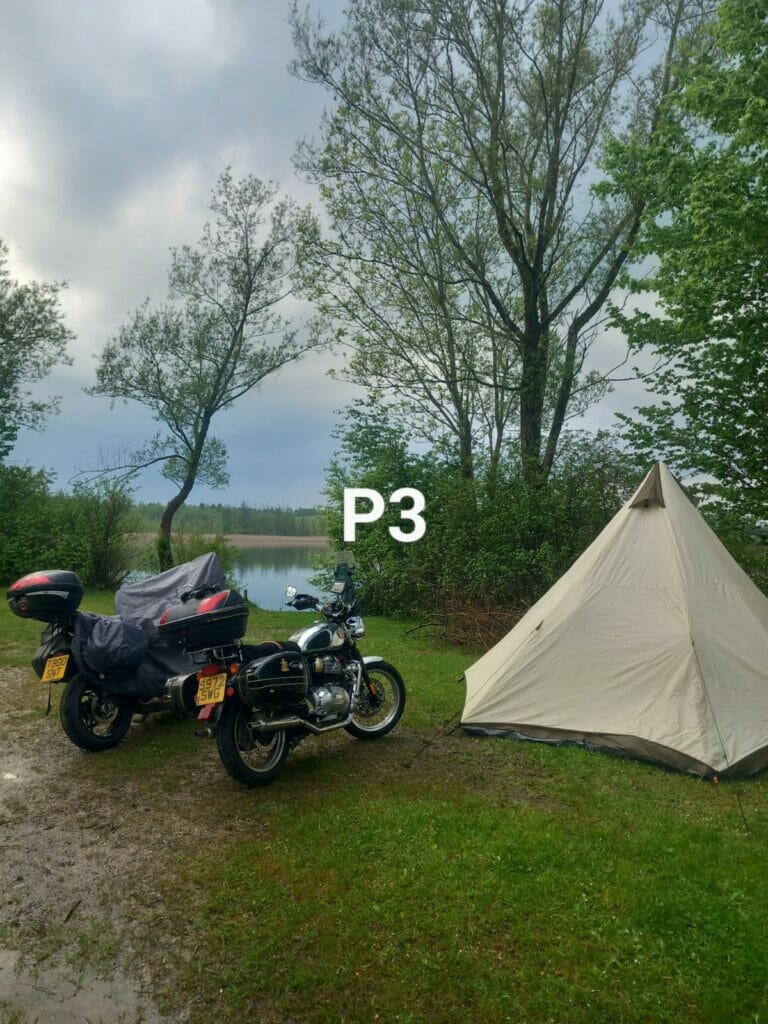 It was only a short window however as the rain started again and continued for another 24 hours or so, so we turned the Thursday into a rest day and only left the tent for a bit of shopping and a short trip to the World Heritage church of Die Wiesse. It is a truly spectacular baroque church for such a small ‘backwater’ in a rural community. I did notice inside the church that as well as a Roll of Honour for locals who had died in the Great War, they had also listed the names of men who had returned and I don’t recall seeing this anywhere else before. (P,4,5) It was on this ride out that I noticed the battery warning light took a long time to extinguish; more of this later…
It was only a short window however as the rain started again and continued for another 24 hours or so, so we turned the Thursday into a rest day and only left the tent for a bit of shopping and a short trip to the World Heritage church of Die Wiesse. It is a truly spectacular baroque church for such a small ‘backwater’ in a rural community. I did notice inside the church that as well as a Roll of Honour for locals who had died in the Great War, they had also listed the names of men who had returned and I don’t recall seeing this anywhere else before. (P,4,5) It was on this ride out that I noticed the battery warning light took a long time to extinguish; more of this later…
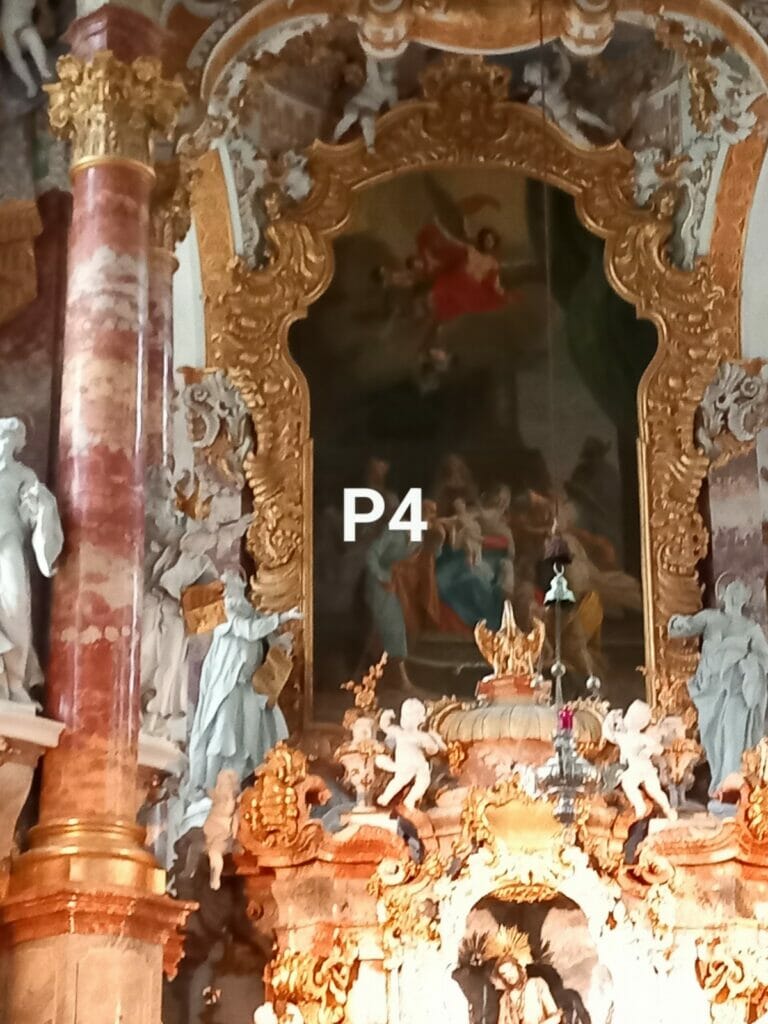
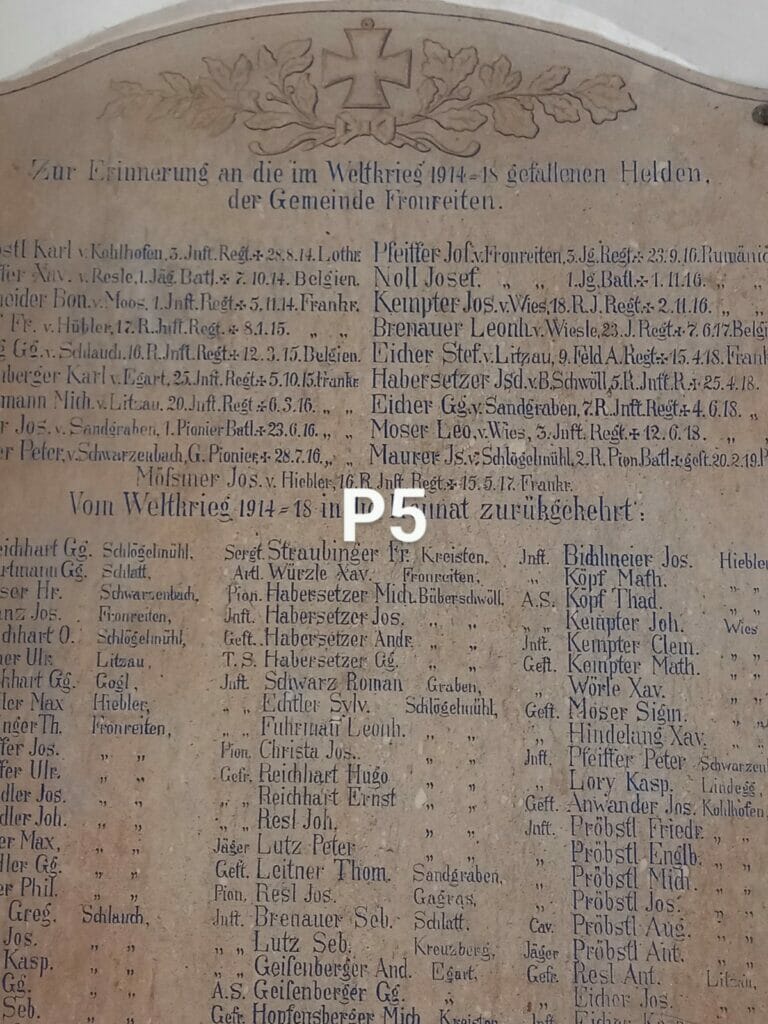 25.5.23 – We were excited to be moving on to Austria; the plan for today was as simple as it was exhilarating – we were going to cross the Grossglockner pass. At 30euros it isn’t cheap, but so well worth it to ride the hairpin bends, watch the Marmots and climb to the summit (P6) to look out over snow covered alpine peaks. We set up camp at Leinz where the weather was the exact opposite of Germany as it was very hot, almost uncomfortably so, which necessitated plenty of brew stops on the way. By now we had recognised a pattern of progress on Facebook of others on their journeys too.
25.5.23 – We were excited to be moving on to Austria; the plan for today was as simple as it was exhilarating – we were going to cross the Grossglockner pass. At 30euros it isn’t cheap, but so well worth it to ride the hairpin bends, watch the Marmots and climb to the summit (P6) to look out over snow covered alpine peaks. We set up camp at Leinz where the weather was the exact opposite of Germany as it was very hot, almost uncomfortably so, which necessitated plenty of brew stops on the way. By now we had recognised a pattern of progress on Facebook of others on their journeys too.
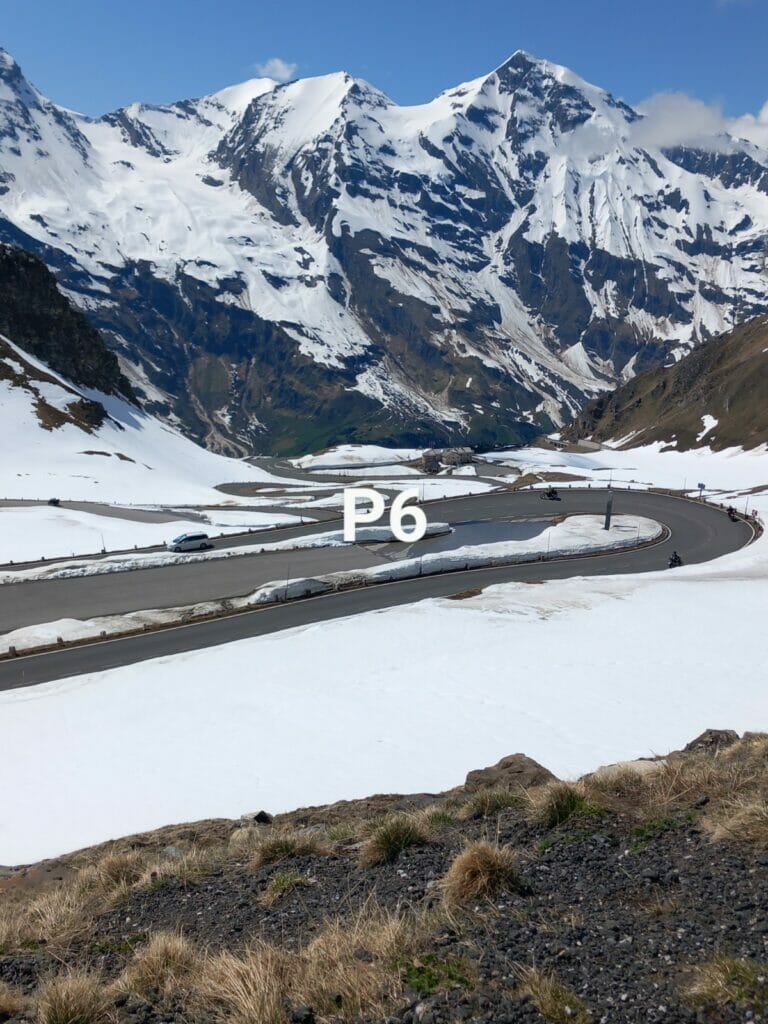 26.5.23.-. Time to make our way to Slovenia by the Wurzen pass to drop down to the border and the views were simply stunning and all this in lovely weather! All this time I had noticed that the little voltmeter/usb port I have was showing inconsistent charging and sadly, things were going to take a turn for the worse. Although we had a rough plan to stay at Lake Bled it was just so busy and touristy that we couldn’t even park up for a quick photo without being moved on by hotel owners etc. (P8) We decided to push on to the Plitvice lakes National Park in Croatia. And around 4.00pm, we stopped to obey the golden rule of “tank full bladder empty” but when we got back on the bikes I was greeted by a clicking sound from the starter button! I phoned the RE Road assistance number to find it wasn’t recognised, so phoned the UK number and discovered my bike wasn’t registered with them; OK they can register it, but as my bike is 2 years and 9 months old, it’s not covered; the operator agreed to make some enquiries and phone me back.
26.5.23.-. Time to make our way to Slovenia by the Wurzen pass to drop down to the border and the views were simply stunning and all this in lovely weather! All this time I had noticed that the little voltmeter/usb port I have was showing inconsistent charging and sadly, things were going to take a turn for the worse. Although we had a rough plan to stay at Lake Bled it was just so busy and touristy that we couldn’t even park up for a quick photo without being moved on by hotel owners etc. (P8) We decided to push on to the Plitvice lakes National Park in Croatia. And around 4.00pm, we stopped to obey the golden rule of “tank full bladder empty” but when we got back on the bikes I was greeted by a clicking sound from the starter button! I phoned the RE Road assistance number to find it wasn’t recognised, so phoned the UK number and discovered my bike wasn’t registered with them; OK they can register it, but as my bike is 2 years and 9 months old, it’s not covered; the operator agreed to make some enquiries and phone me back.
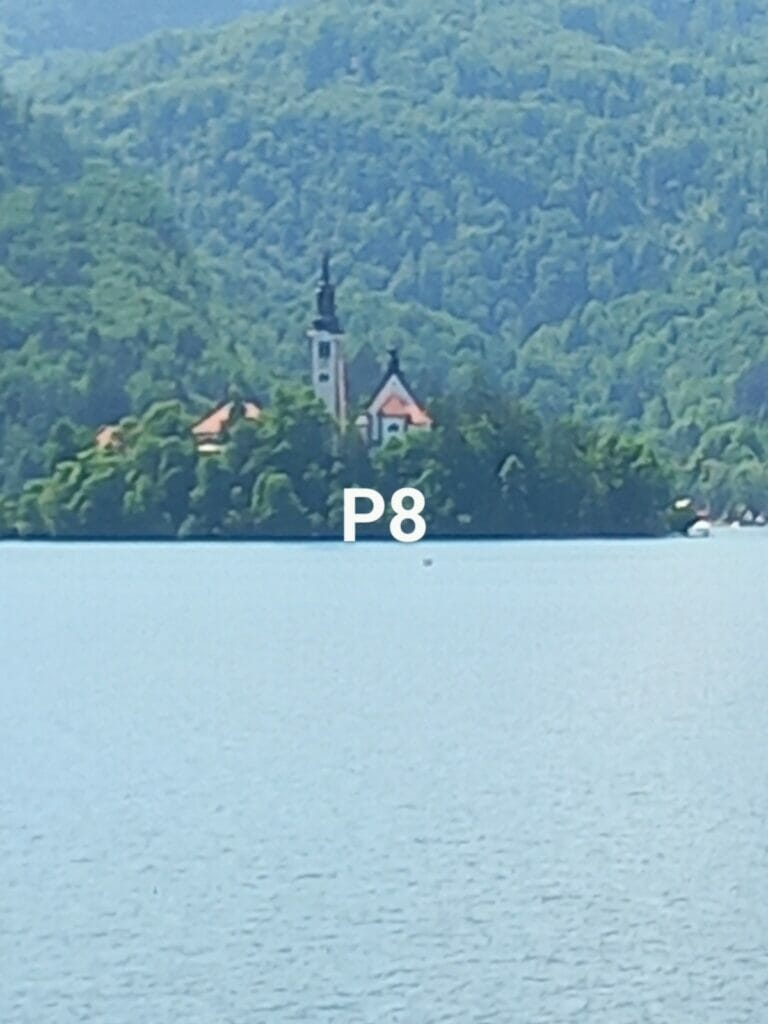 While I was doing this Simon had found a campsite in the village and also an Enfield dealer about 45 minutes away in Croatia.
While I was doing this Simon had found a campsite in the village and also an Enfield dealer about 45 minutes away in Croatia.
By the time Simon had set up the tent and returned the RSA had confirmed I had 3 year warranty and passed the claim onto to local service. A quick bump start, the bike fired up and a short ride to the Lovsin Estate campsite, where the owners were really friendly and helpful, producing a battery charger and much needed beer! (P7) The recovery service phoned from Vienna but we decided that there was little point in them attending if they could not supply a new battery. Mine was only showing 12.3 volts despite being on charge all night
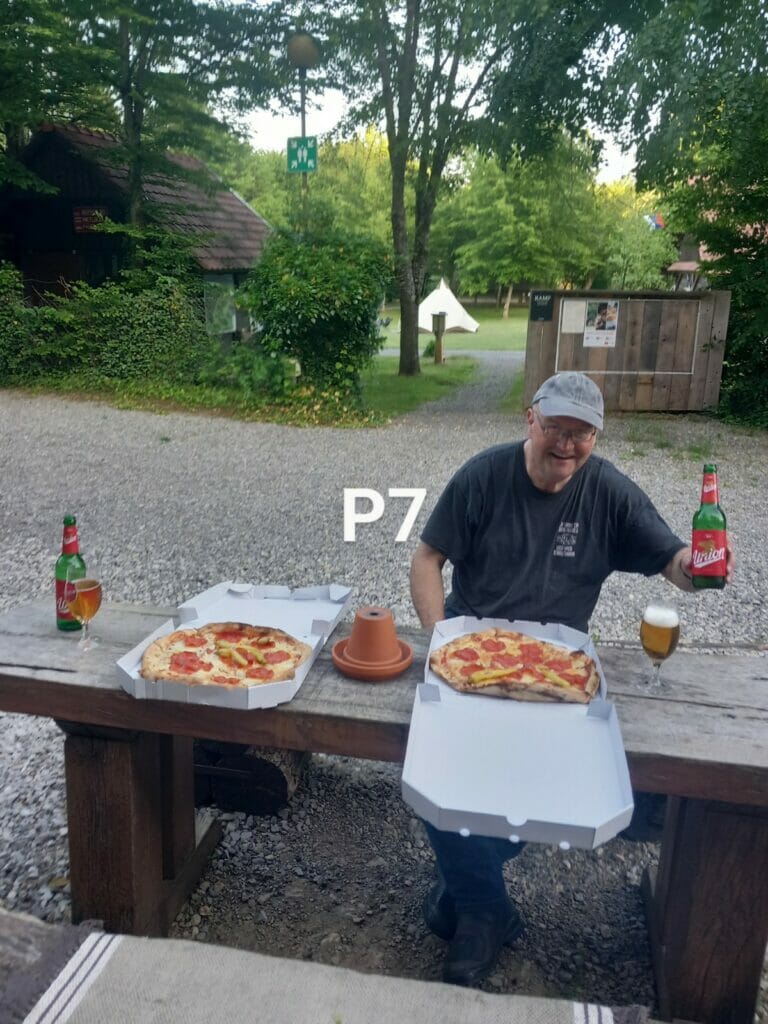 27 5.23 – A phone call to Novema Nova motorcycles in Draganici in Croatia to confirm they have a battery and 45 minutes later we were at a very smart Royal Enfield dealership. However, the ‘correct’ battery cited on their computer had its terminals ‘the wrong way round’ so a further wait to charge the second one and another brew in their busy car park. The destination now was to explore the Plitivice lakes, but when we got there again it was like Blackpool on a bank holiday and the lakes were quite some distance away and only accessible if a ticket was bought. After, waiting an age for something to eat we simply set off for Kamp Seget, near Split on the Croatian coast, only to find the battery warning light on again!
27 5.23 – A phone call to Novema Nova motorcycles in Draganici in Croatia to confirm they have a battery and 45 minutes later we were at a very smart Royal Enfield dealership. However, the ‘correct’ battery cited on their computer had its terminals ‘the wrong way round’ so a further wait to charge the second one and another brew in their busy car park. The destination now was to explore the Plitivice lakes, but when we got there again it was like Blackpool on a bank holiday and the lakes were quite some distance away and only accessible if a ticket was bought. After, waiting an age for something to eat we simply set off for Kamp Seget, near Split on the Croatian coast, only to find the battery warning light on again!
28-29/30.5.23 – The ride down the Dalmatian coast was notable for good views and particularly the new bridge which links an island to mainland Croatia and then carries on to Dubrovnik. (P9) This bridge obviated the need to enter Bosnia for the 10 miles or so, thus avoiding their Customs and charges.
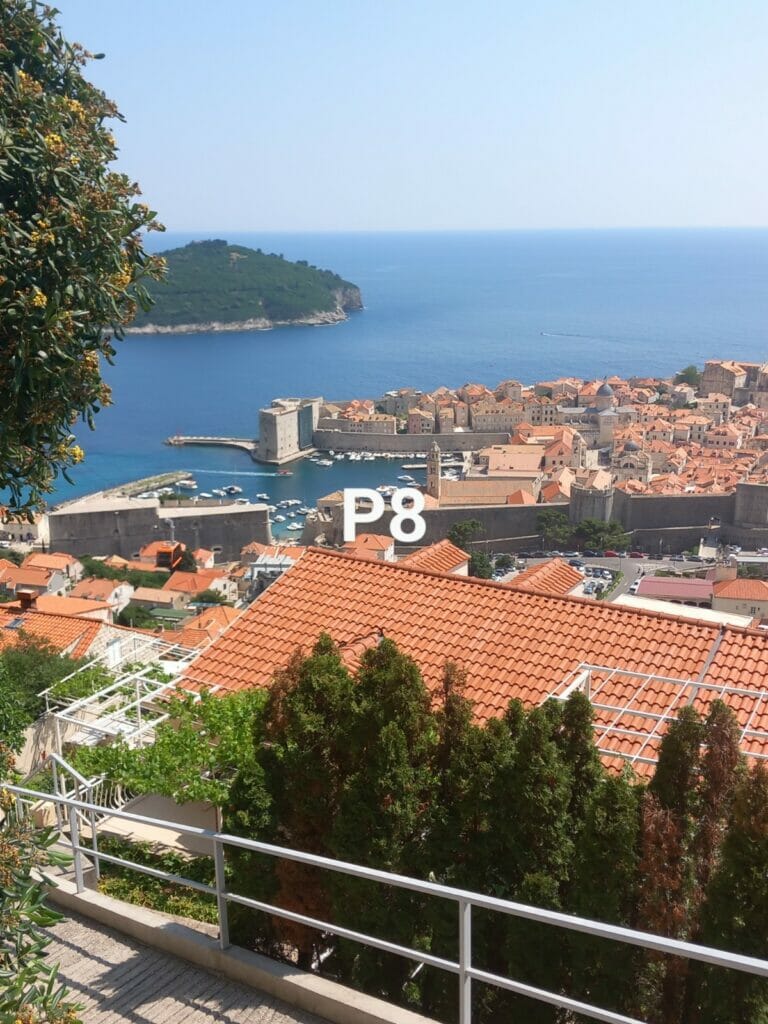
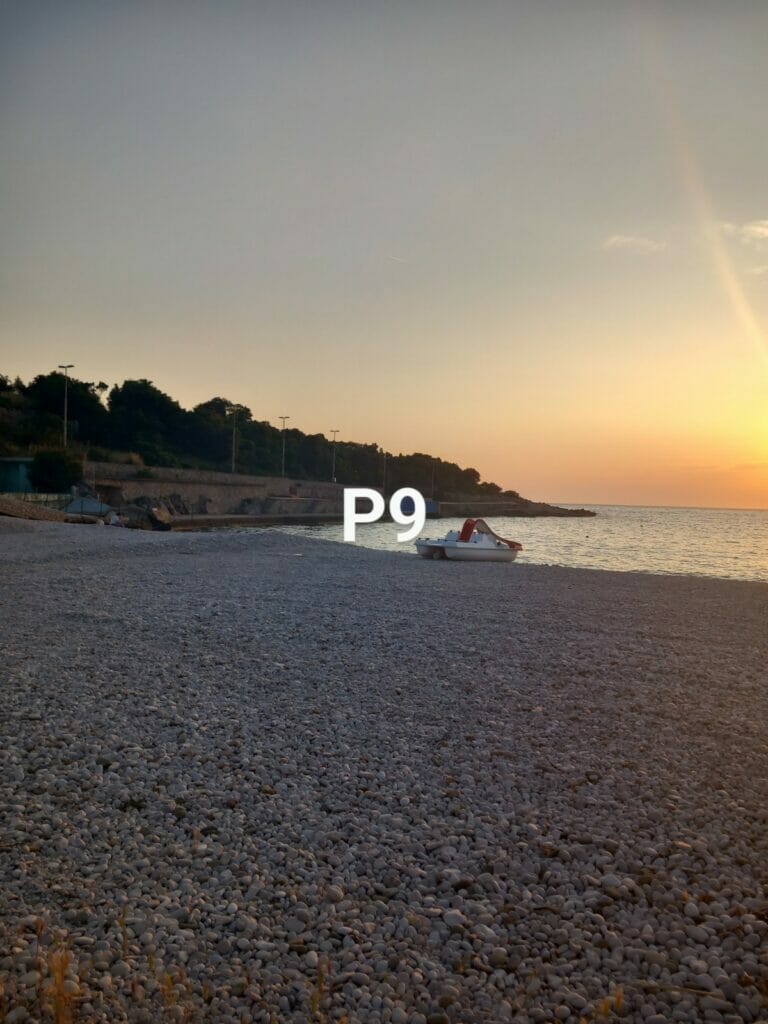 We soon drove through Montenegro, camping just near the border with Albania at a perfect beachside campsite (P10) in Ulcinj (So nice I recommended it to Jak Lemon on his return leg!) and the wildlife in Montenegro was the most varied we had seen with snakes, lizards, tortoises and some type of pole cat. Crossing into Albania created some anxiety, as we were waiting a long time, but I didn’t want to turn of the engine; also Simon wanted to buy insurance, but there was nowhere we could see so he ended up without it (the same thing having happened in Montenegro! Albania itself was a mixed experience with the outskirts of larger towns surrounded by shanty type dwellings and beggars but away from these the land looked a little barren apart from very delicately scented yellow shrubs (looked like Forsythia?) and fruit and veg stands all along the roads. The people however were very friendly and helpful. Having decided to buy a battery charger we stopped at a very flashy tyre and battery store in Gjirokastra and though they didn’t sell them, a staff member grabbed his helmet and motioned for us to follow him across town to another electrical store, who having been forewarned of our arrival was waiting with a multimeter in hand. Although this didn’t help, they couldn’t have been more concerned. A young boy was found to translate to English for us and it was as much an experience for them as it was us! After a biblical thunder and lightning storm (where we passed Paul Myers, donning waterproofs, though we didn’t know him then) we stayed that night in an AirBnB in Sarande before finally crossing over into Greece.
We soon drove through Montenegro, camping just near the border with Albania at a perfect beachside campsite (P10) in Ulcinj (So nice I recommended it to Jak Lemon on his return leg!) and the wildlife in Montenegro was the most varied we had seen with snakes, lizards, tortoises and some type of pole cat. Crossing into Albania created some anxiety, as we were waiting a long time, but I didn’t want to turn of the engine; also Simon wanted to buy insurance, but there was nowhere we could see so he ended up without it (the same thing having happened in Montenegro! Albania itself was a mixed experience with the outskirts of larger towns surrounded by shanty type dwellings and beggars but away from these the land looked a little barren apart from very delicately scented yellow shrubs (looked like Forsythia?) and fruit and veg stands all along the roads. The people however were very friendly and helpful. Having decided to buy a battery charger we stopped at a very flashy tyre and battery store in Gjirokastra and though they didn’t sell them, a staff member grabbed his helmet and motioned for us to follow him across town to another electrical store, who having been forewarned of our arrival was waiting with a multimeter in hand. Although this didn’t help, they couldn’t have been more concerned. A young boy was found to translate to English for us and it was as much an experience for them as it was us! After a biblical thunder and lightning storm (where we passed Paul Myers, donning waterproofs, though we didn’t know him then) we stayed that night in an AirBnB in Sarande before finally crossing over into Greece.
31.5.23/1.6.23 – Finally into Greece and immediately the landscape changed to brightly coloured flowers and a much more cared for appearance everywhere. Another AirBnB at Aigio and the following day we rode on the rack and pinion railway up to the Holocaust massacre village of Kalavrtya, where in an act of retribution almost every male over 14 was executed on 13.12.1943. (P 10, 11, 12)
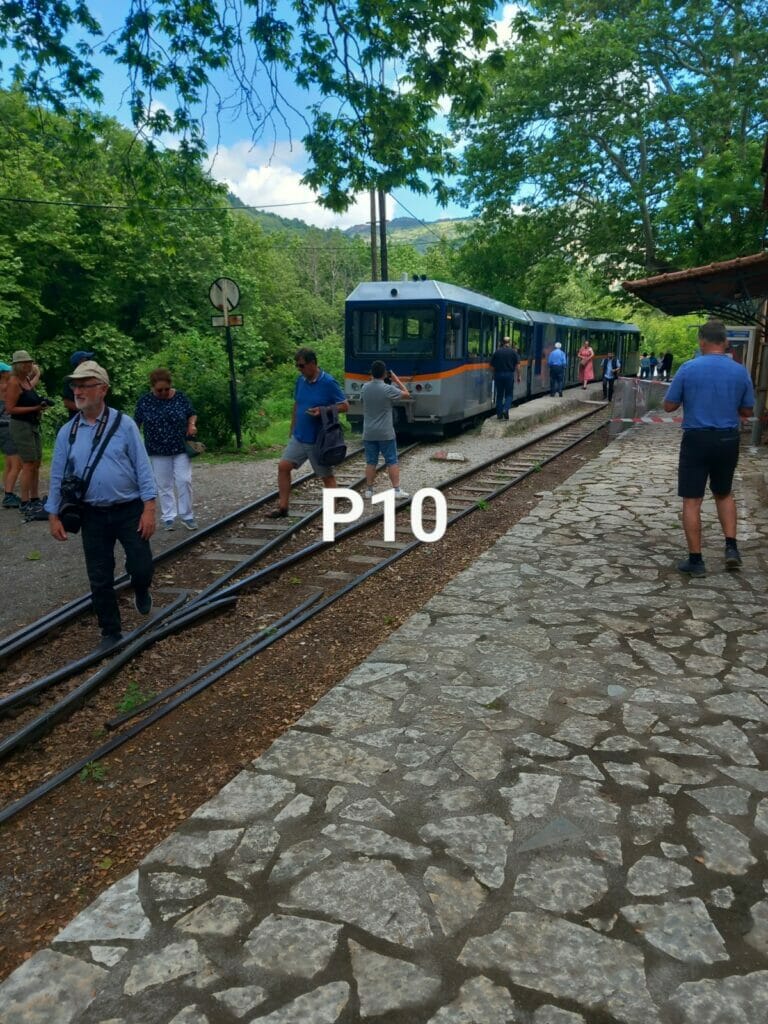
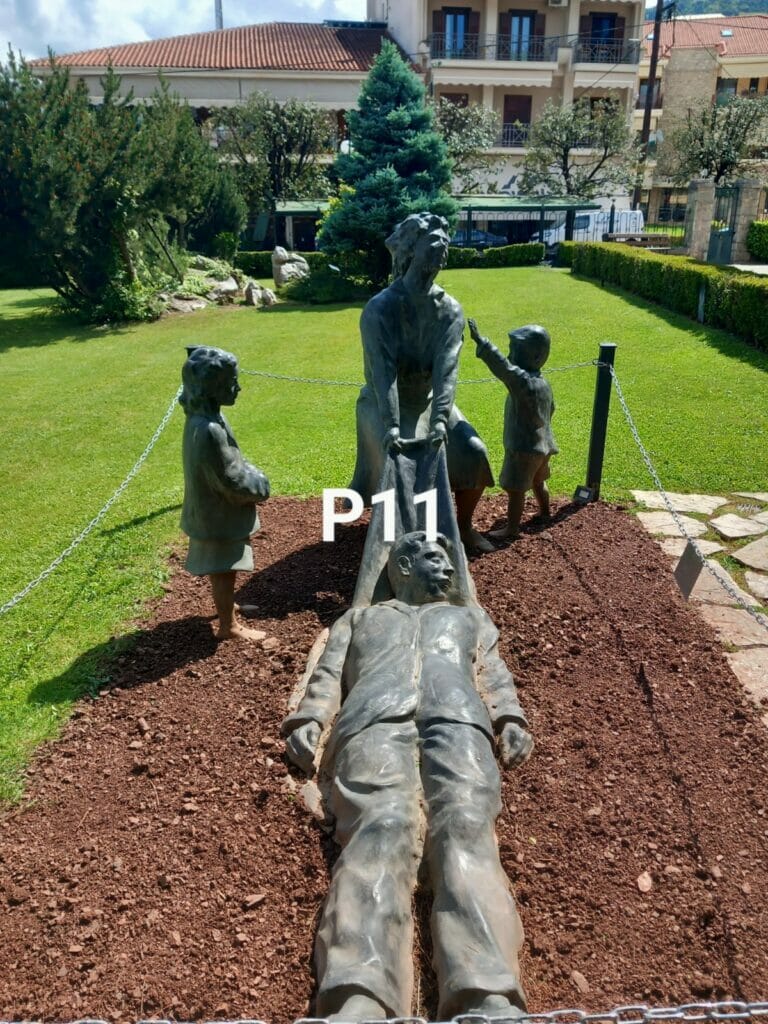
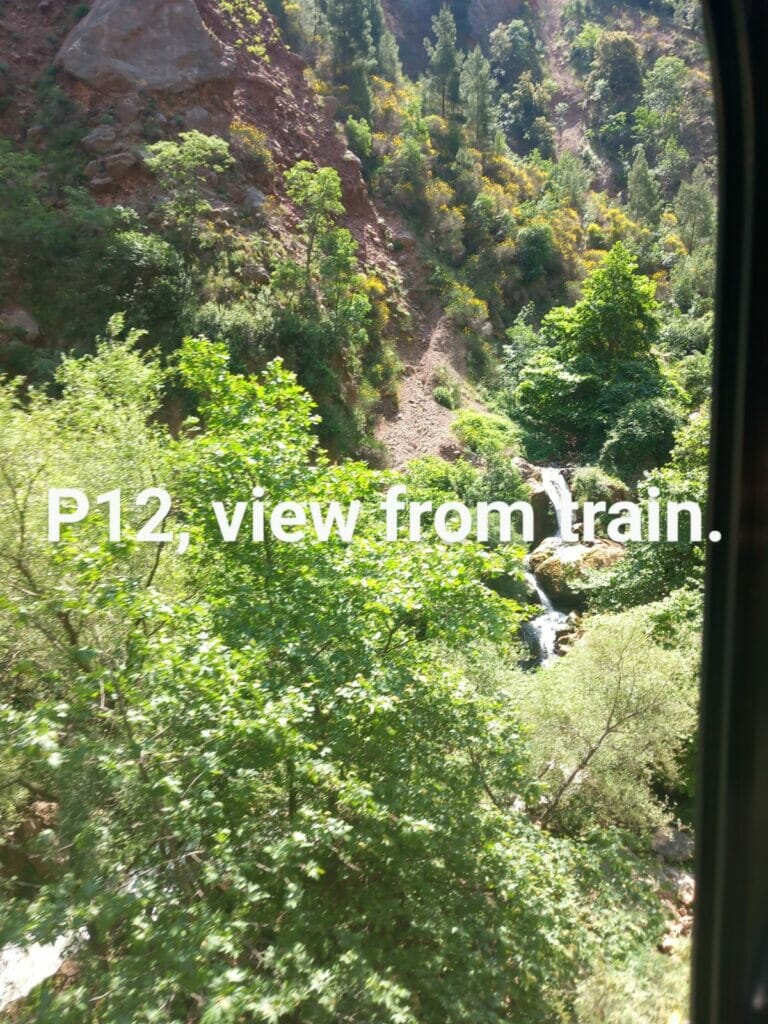
We arrived at Camping Nicholas Epidaurus late afternoon and celebrated with a beer. Even though the rally did not officially start for 2 more days, there were quite a few who had travelled by different routes and means already there. We could finally put faces to the people whose progress we had been “following” on Facebook. At this point I’d like to thank the couple from near Bristol, who kindly charged my battery and Darren Waite who lent me his charger for the return leg.
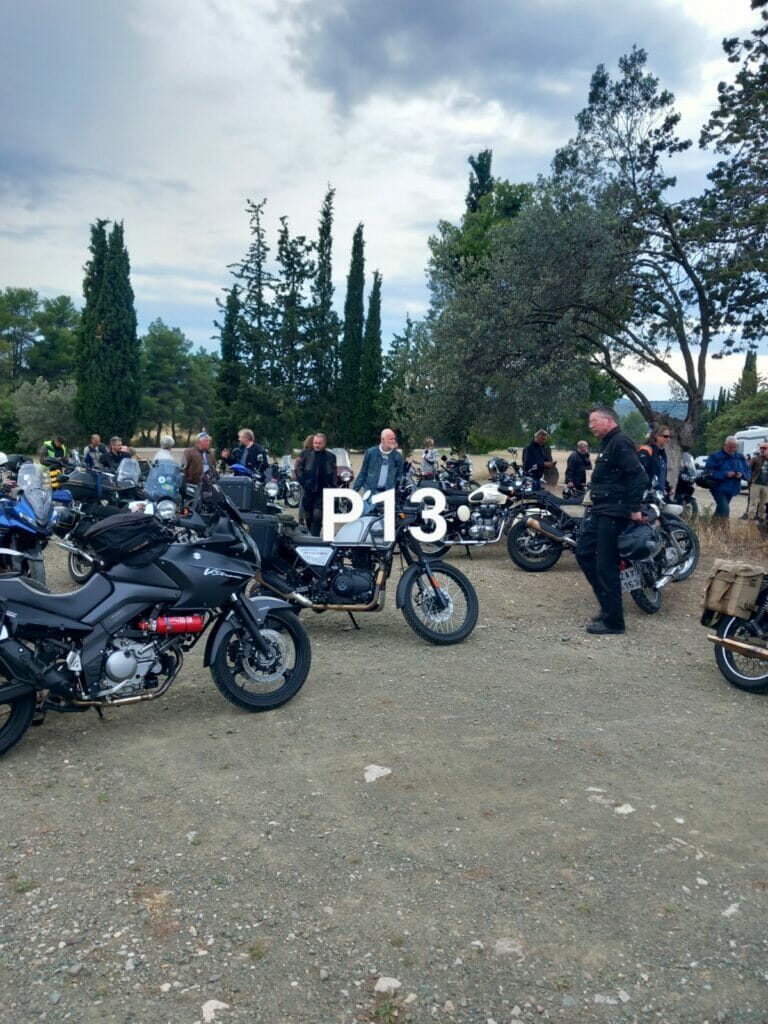
The rally itself was without doubt the best one I have attended by any club, being so well planned, organised and such a friendly atmosphere. (P13)
The efforts and hard work of the Greece Branch certainly paid off. As an aside I had luckily arranged a Service with MotoPetsas in Athens before leaving home to preserve the warranty, but used this slot to repair the charging system. As we had booked ferries to Turkey from Piraeus that evening, we had to leave early on the Sunday to get the bike to Athens for early Monday morning.
7.6-9.6.23 – The bad news was that the problem could not be rectified, though some weak connections were made good and the volts appeared healthy. Sadly we had to forgo the Turkish leg of our trip and set off to Meteora in central Greece. James Bond fans will recognise these high monasteries from “For Your Eyes Only” as St. Cyrils.
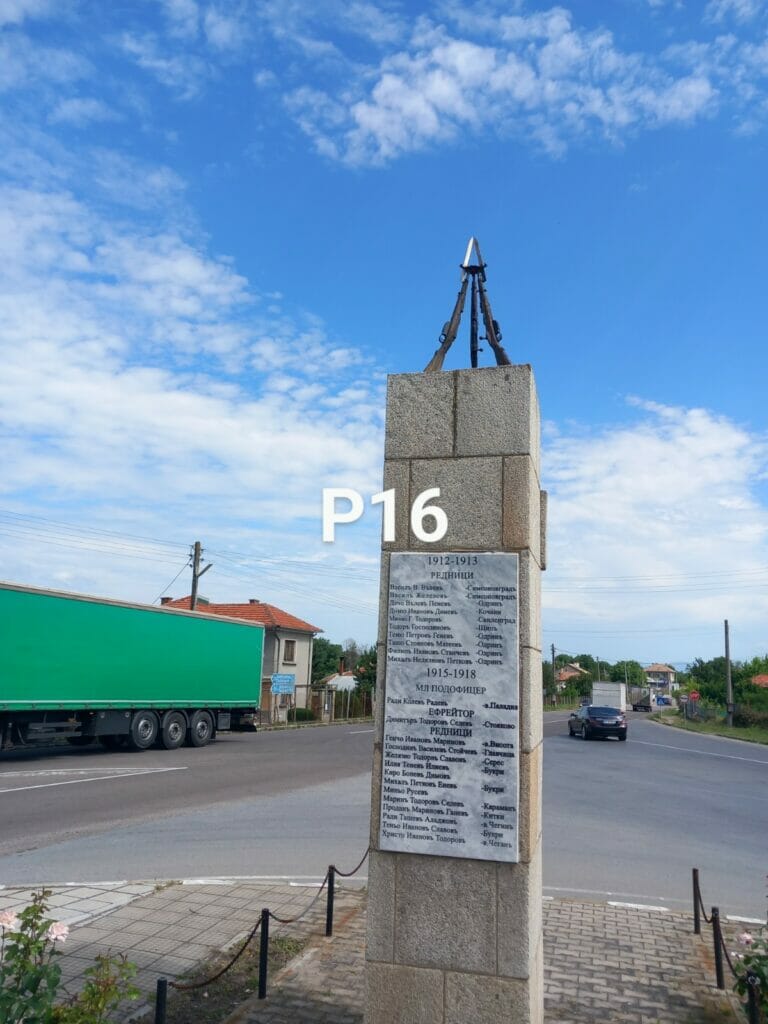 Sadly the volts started to drop again, but unplugging the headlight restored charging for a few days, until the novelty wore off and it was back to overnight mains charging of the battery. Meteora would have been worth a much longer exploration, but given an effective range of about 300Kms of battery life we planned a steady ride home in short steps. After an overnight near Serres we left Greece via Mount Olympus and Thessaloniki into Bulgaria.
Sadly the volts started to drop again, but unplugging the headlight restored charging for a few days, until the novelty wore off and it was back to overnight mains charging of the battery. Meteora would have been worth a much longer exploration, but given an effective range of about 300Kms of battery life we planned a steady ride home in short steps. After an overnight near Serres we left Greece via Mount Olympus and Thessaloniki into Bulgaria.
9 /10.6.23 – Stunning sylvanian scenery and stray dogs chasing the bikes were the most noticeable things on our way to Kardzali, where we stayed at the Meatsa Hotel.
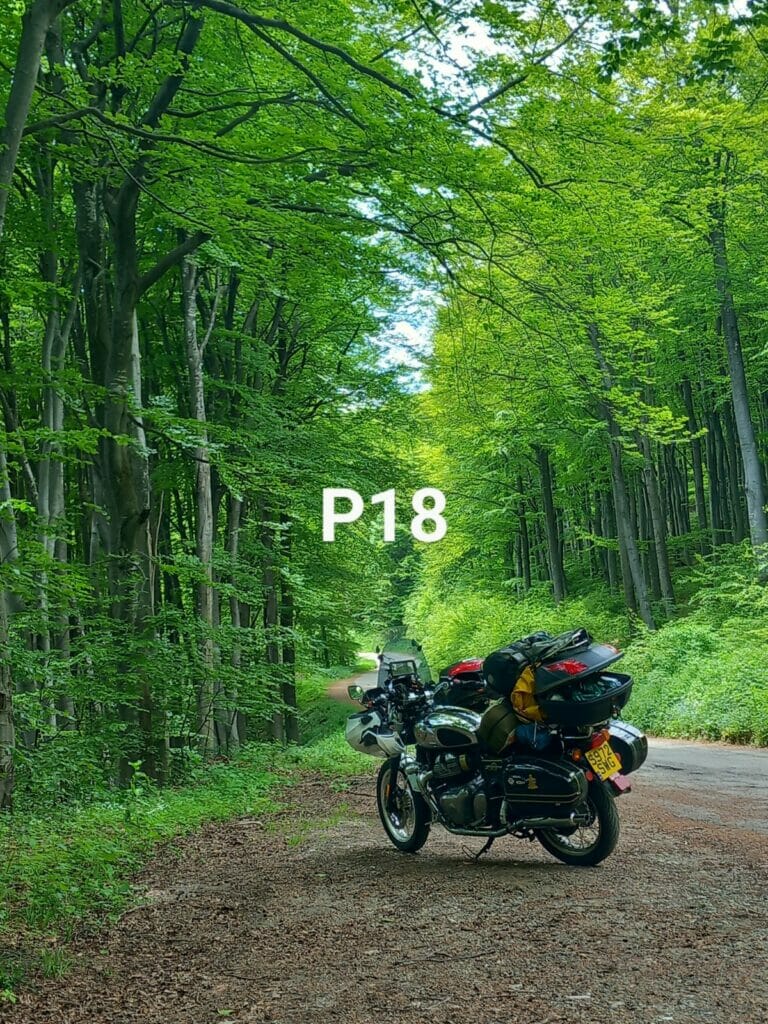
Generally we were able to get by without local currency, by using Euros at an exchange rate decided by the venue, with change in the local Lev, Lek or Leu. Saturday saw us heading for Motocamp Bulgaria; we had heard many good reports of the Motocamp and from the moment we were on the road there was a seemingly never-ending groups of bikes – cruisers, sports bikes, adventure bikes all riding together, rather than the usual one genre groups normally seen and everyone waving. We were a little concerned that with so many ride outs for the weekend, maybe the campsites would be full? On the way we tried to get to the Bulgarian Space Memorial, or UFO at Buzludzha, but turned the wrong way! I was very impressed and intrigued by the size, distinctive style and frequency of Communist era statutes (P16,17)
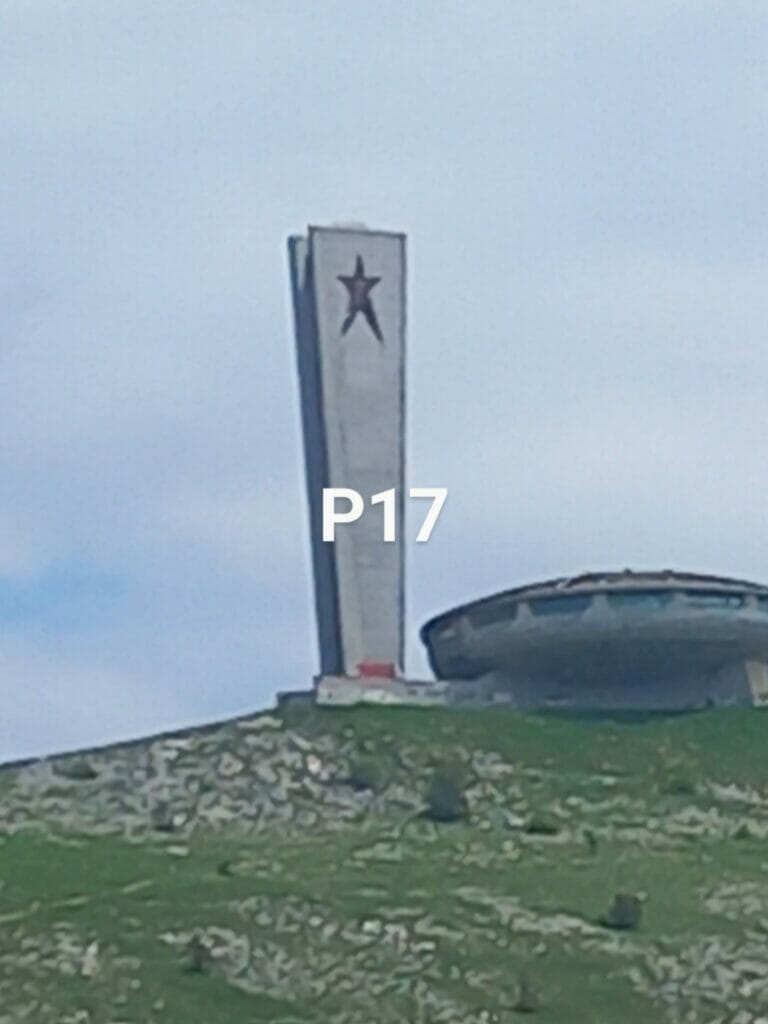 which we passed along the way, where in other countries they had been demolished. The MotoKamp wasn’t easy to find by our phone SatNavs, but the diversions were rewarded by fantastic scenery. Once there it was like a bikers oasis, with about a dozen riders from 4 or 5 different countries and an honesty box beer fridge, which was very welcome. The camaraderie was epitomised by a group of Hungarians who had prepared their traditional meal, I think it was called Borek and shared it with everyone (I hope I’ve got the name right, cheese, spinach in a kind of dough prepared in a flat pan and very tasty) A return visit to explore the region more is definitely needed.
which we passed along the way, where in other countries they had been demolished. The MotoKamp wasn’t easy to find by our phone SatNavs, but the diversions were rewarded by fantastic scenery. Once there it was like a bikers oasis, with about a dozen riders from 4 or 5 different countries and an honesty box beer fridge, which was very welcome. The camaraderie was epitomised by a group of Hungarians who had prepared their traditional meal, I think it was called Borek and shared it with everyone (I hope I’ve got the name right, cheese, spinach in a kind of dough prepared in a flat pan and very tasty) A return visit to explore the region more is definitely needed.
11.6.23 – Despite the Romanian border not being very far on the map it took a long time to get to the Danube for the ferry across. At first the sight of lines of lorries queuing up were a little disconcerting, but we sneaked to the front and were waved up by Customs, who quickly processed us and we waited for the ferry to return from the other side. Loading was a bit of a challenge as they use heavy metal “duck” boards for the lorries and with a heavily loaded bike it was a bit nerve wracking getting lined up on the ramps. Into Romania and we headed for Slatina for a Hotel as the forecast was poor. Feeling a little tired we decided to eat at the hotel, which provided a huge feast of mixed grill for two for around £15.
12.6.23 – The forecasted rain arrived as we set off and waterproofs were definitely needed, we even got flood warnings on our phones in Romanian and English. The miserable sodden ride to MotoKamp Sibiu in Cisnadioara was more than compensated by the friendly welcome we received despite us dripping everywhere. Our arrival was celebrated by Doru, the owner, offering us home-made plum spirit, which was too strong even to smell without going light-headed; the honour was returned when I made a pot of Yorkshire loose leaf tea, which was too strong for him! Having explained my charging problems he quickly arranged for a friend, who is an auto electrician to look at the bike which revealed that of the 3 charging coils one was putting out nothing, one 2 volts and one 5 volts. The best conclusion was to buy a second battery and the following day Doru took us into the delightful town of Sibiu, or Hermanstadt to give it the historic German name (P20, 21).
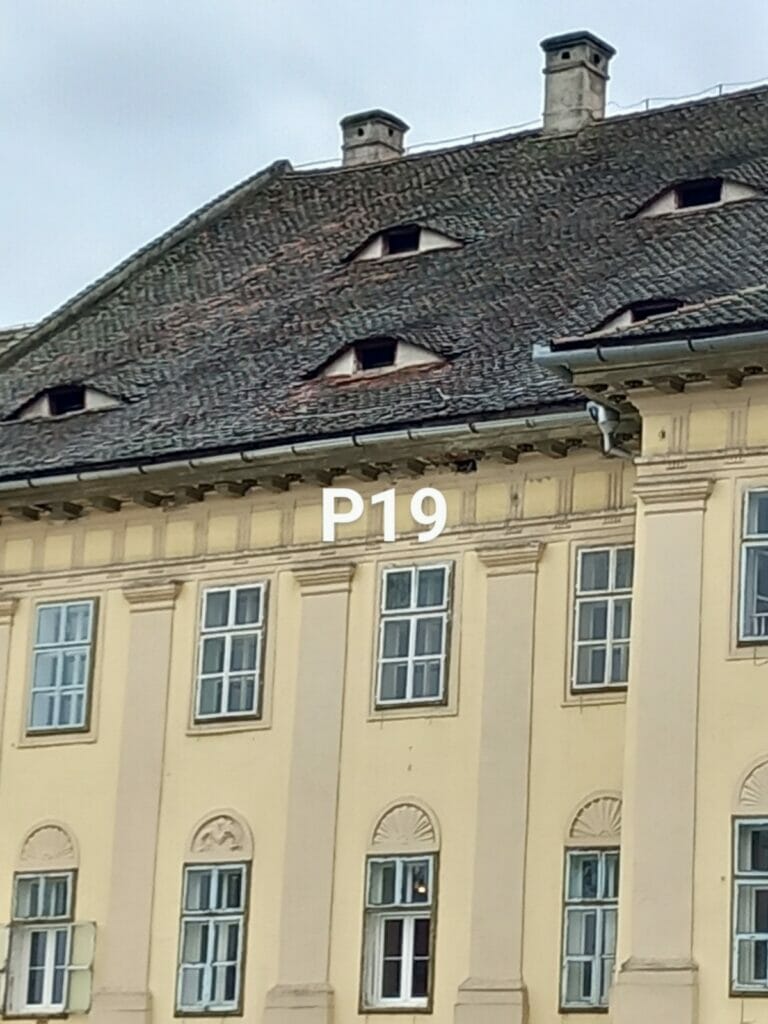
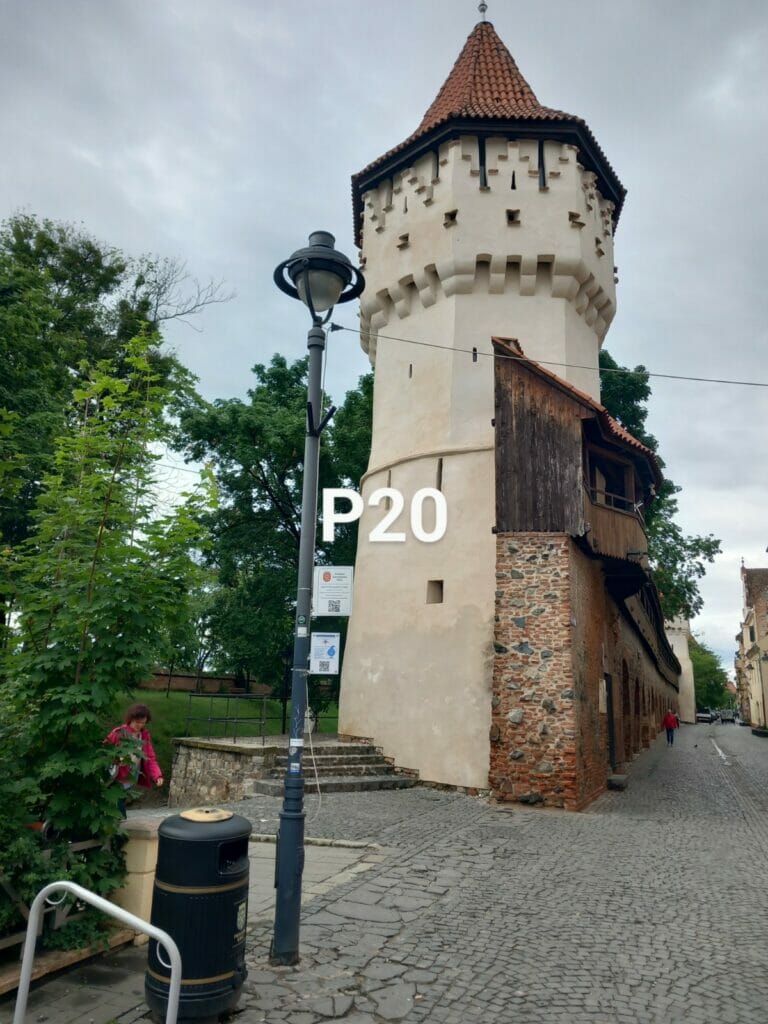 What a delightful little town known for its “eyes in the sky” as many roofs have elliptical windows in them. Throughout our time there Doru could not have been more helpful, advising us of the state of the Transfagarasan, which had still not opened and of course arranging the new battery. Leaving Sibiu on 14.6.23 we travelled to Arad for our final night in Romania, where we arranged the Vignettes for Hungary, but decided against using motorways Austria and Slovakia. Among the signs on the hotel door with No Smoking etc was No hand guns!!!
What a delightful little town known for its “eyes in the sky” as many roofs have elliptical windows in them. Throughout our time there Doru could not have been more helpful, advising us of the state of the Transfagarasan, which had still not opened and of course arranging the new battery. Leaving Sibiu on 14.6.23 we travelled to Arad for our final night in Romania, where we arranged the Vignettes for Hungary, but decided against using motorways Austria and Slovakia. Among the signs on the hotel door with No Smoking etc was No hand guns!!!
15./16./17.6.23 – The Hungarian plains seemed to be endless as we made our way to Budapest and the Motocamp Budapest in the centre of town, which was really no bigger than someone’s back garden, though it was very well organised with all the facilities including a kitchen and covered dining area. We planned on doing the open top bus tour, but found the various trams, tube and trains provided a good insight into this beautiful city. The only downside was that I had been keen to eat a Goulash, but we were very disappointed with the restaurant we chose. Perhaps the most moving sight was the row of 60 iron shoes of all sizes on the banks of the Danube to commemorate the massacre of Hungarian Jews by the Fascist Arrow Cross movement in 1944-45 (P22,23).
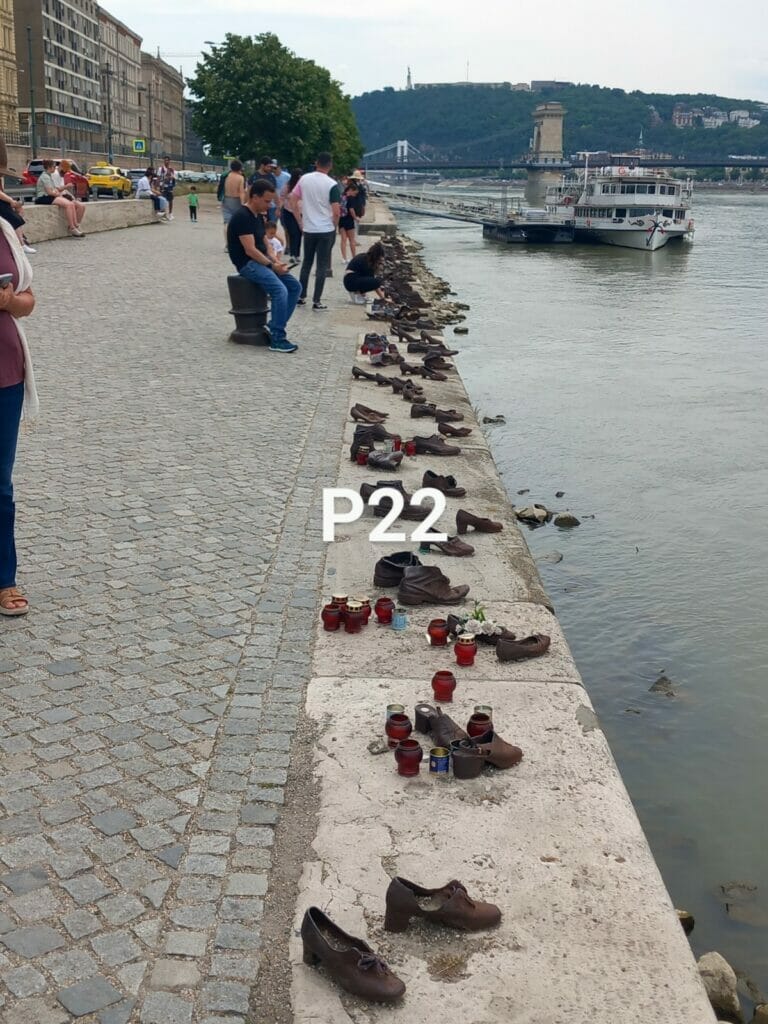
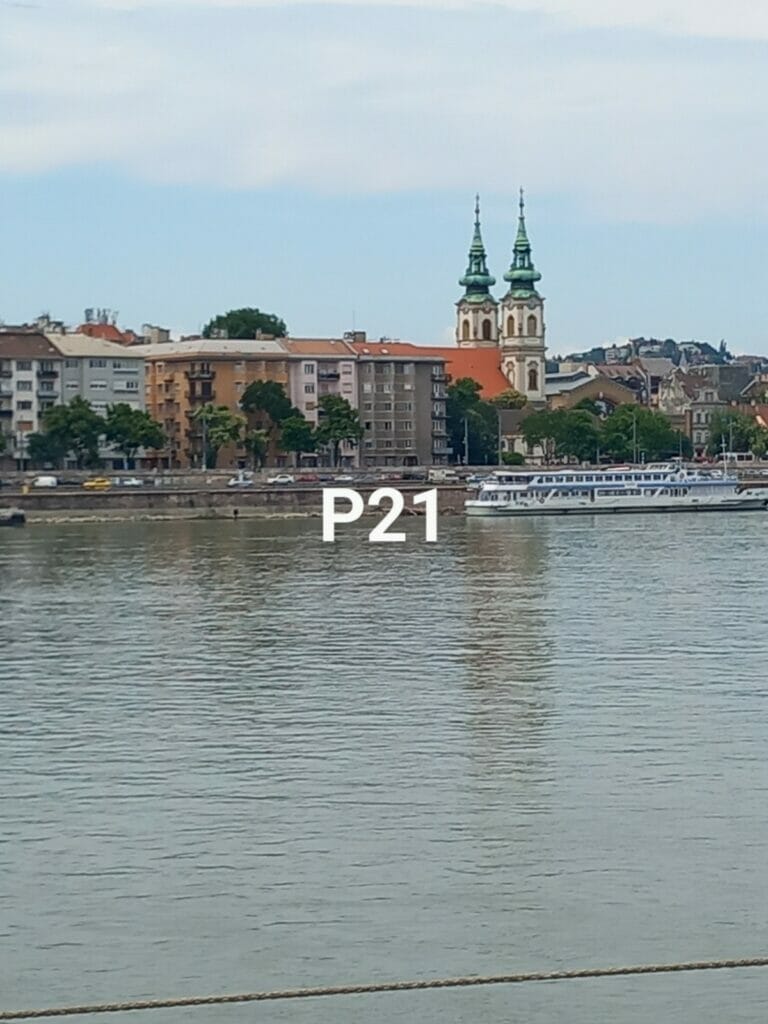
With a fully charged battery we headed for an overnight in Slovakia to visit Bratislava, which was a small, pretty capital city (P24) where we had to change the battery by the Motorway roadside and later camped by a lakeside before riding to Austria again, though this time to Vienna.
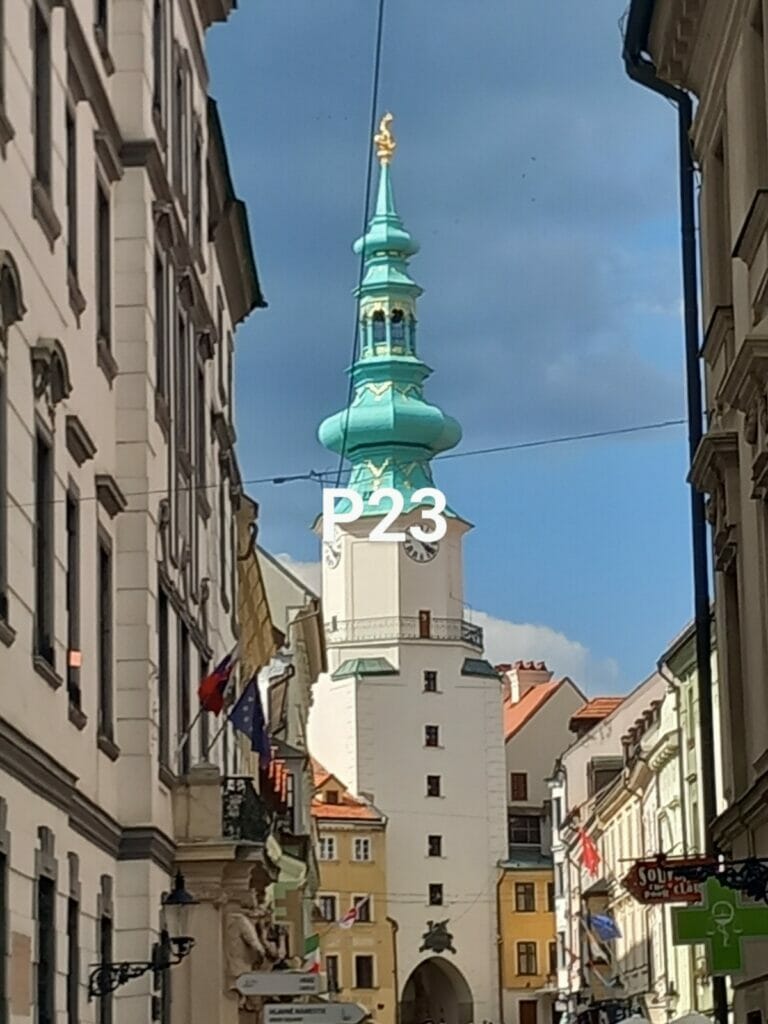
18/19.6.23 – Although the distance from Bratislava to Vienna was only about 50 miles it seemed to take ages to reach our campsite just outside the city. It was incredibly hot and putting the tent up was thirsty work. In addition to this I did my usual trick of “losing” my passport, by placing it on the bike seat while doing something else and forgetting about it, till Simon found it for me; panic over. We ate at a Greek takeaway and had fabulous Gyros to remind us of our purpose. The plan for Monday was an open top bus tour, which was a particularly good call with many famous sights (P24,25) explained in the onboard commentary.
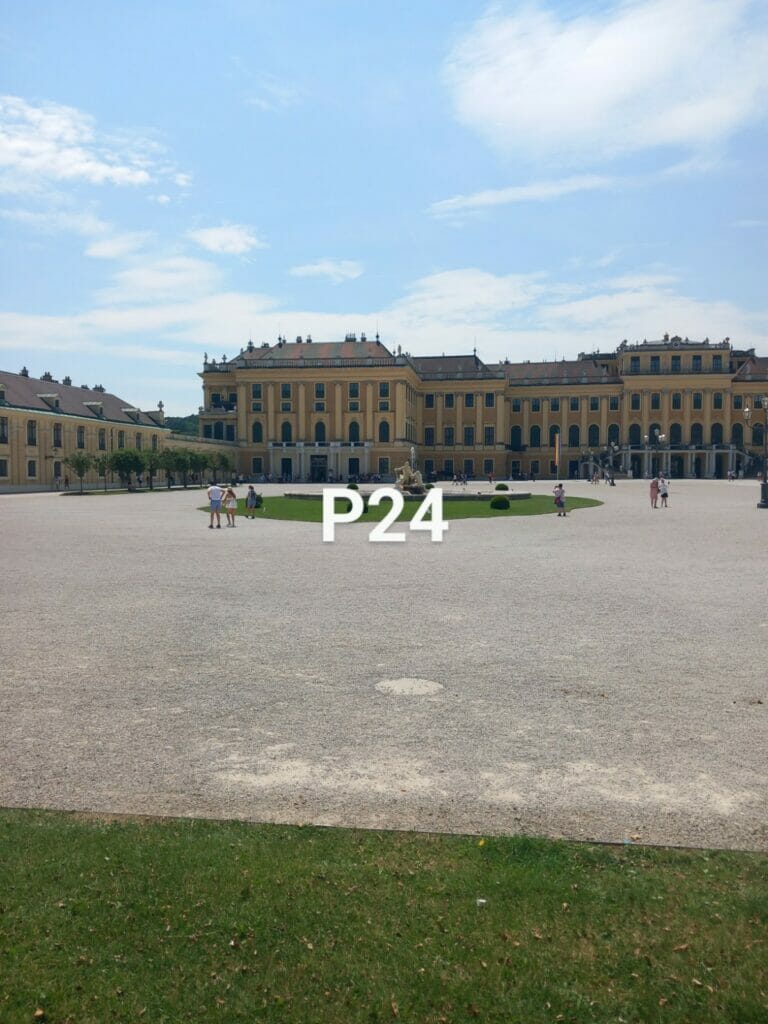
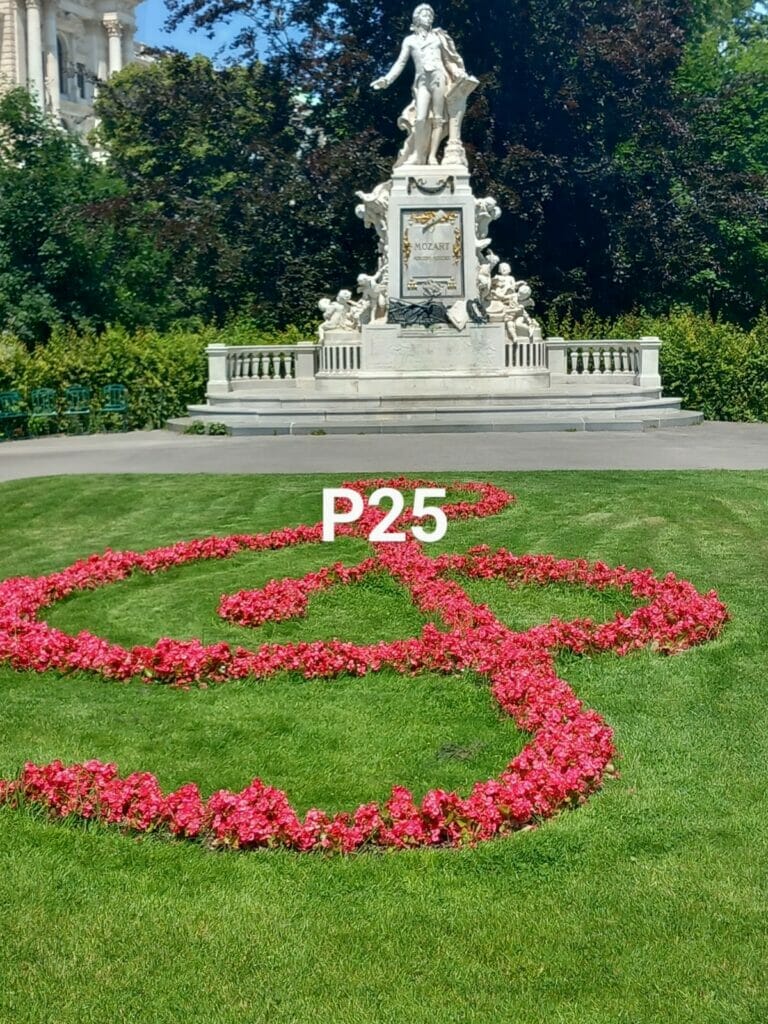 20.6.23 – The destination today was into Czechia, which was somehow magical with wooded glades (P26, 27) and rolling countryside before reaching Ceski Krumov, another beautiful world heritage site which had escaped damage in the second world war.
20.6.23 – The destination today was into Czechia, which was somehow magical with wooded glades (P26, 27) and rolling countryside before reaching Ceski Krumov, another beautiful world heritage site which had escaped damage in the second world war.
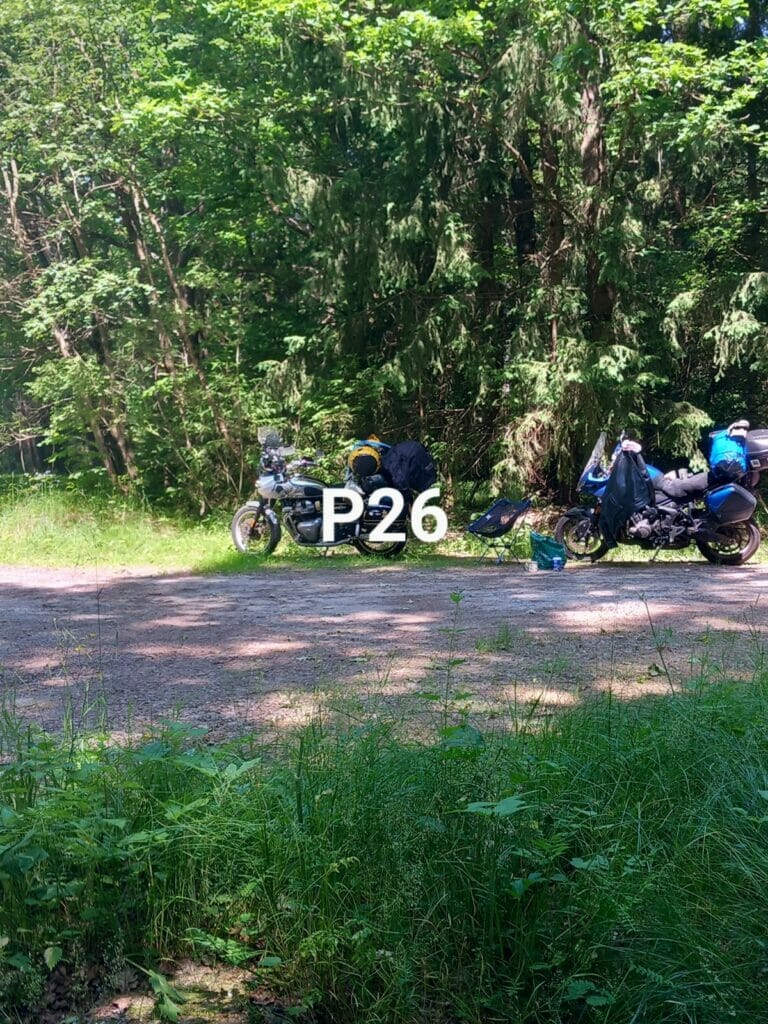
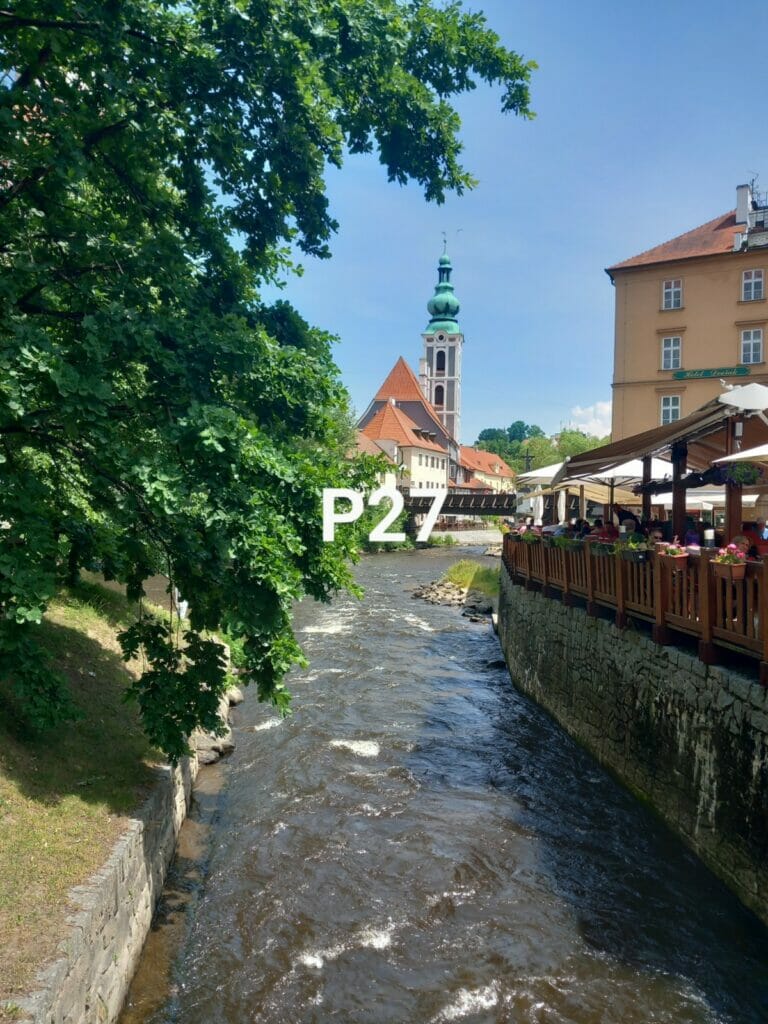 Again the bike would not start so after giving up trying to bump start in the heat it was unload all the gear to change the battery. Another Airbnb with a large kitchen and balcony for the evening meal and beer with glorious views over fields to woods and big open skylines.
Again the bike would not start so after giving up trying to bump start in the heat it was unload all the gear to change the battery. Another Airbnb with a large kitchen and balcony for the evening meal and beer with glorious views over fields to woods and big open skylines.
21.6.23 – We had planned to camp just outside Nuremburg about 200 kilometres away, but as we were having a brew and sandwiches for lunch we could see very dark clouds approaching fast, despite the weather forecast saying minimal chance of rain. We decided we knew better and donned the waterproofs in time for another downpour of biblical proportions with water forming streams down the autobahn, which did not seem to bother the Audi and Porsche drivers who didn’t bother to turn on lights or slow down; it was very stressful knowing I only had side lights on to save the battery. After an hour or so we left the motorway for quieter roads forlornly hoping the rain would clear as we approached Neumarkt in der Oberpfalz. OK, another hotel to get out of the deluge. Of course once checked in the rain stopped and a lovely sunny evening followed. It was a pretty little town and I strolled round the centre, discovering a small tower like monument to the old town that was virtually eradicated in late 1944/45 and a Simson motor scooter wrapped round a lamp post (P28) as an art installation! The other interesting sight was watching patrolling Police cars stopping in the street to let pigeons cross the road – this happened on quite a few occasions, not just a one off.
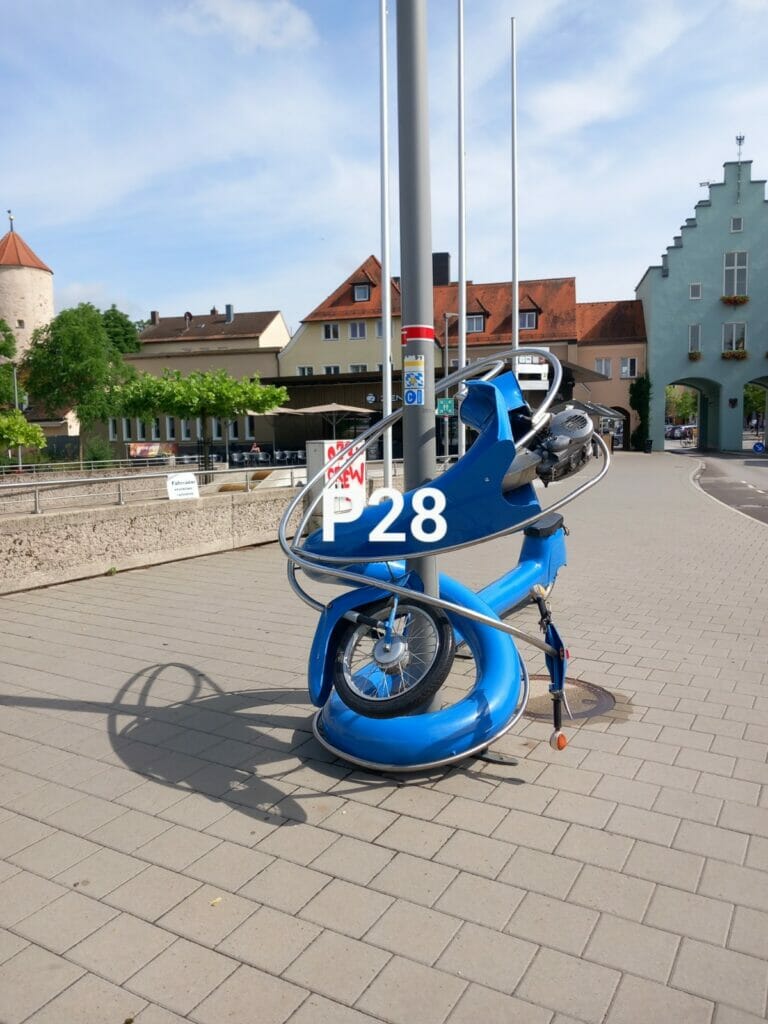 22.6.23 – From one rally site to another more macabre rally as we rode round the old Nazi Nuremburg rally grounds and Zepplinfeld; its such a huge area and we tried to imagine from the old footage of throngs of people and soldiers would have been like here (P30, 31). After we headed for Heidelberg for a walk round the old town and an Airbnb by the river Neckar for the night.
22.6.23 – From one rally site to another more macabre rally as we rode round the old Nazi Nuremburg rally grounds and Zepplinfeld; its such a huge area and we tried to imagine from the old footage of throngs of people and soldiers would have been like here (P30, 31). After we headed for Heidelberg for a walk round the old town and an Airbnb by the river Neckar for the night.
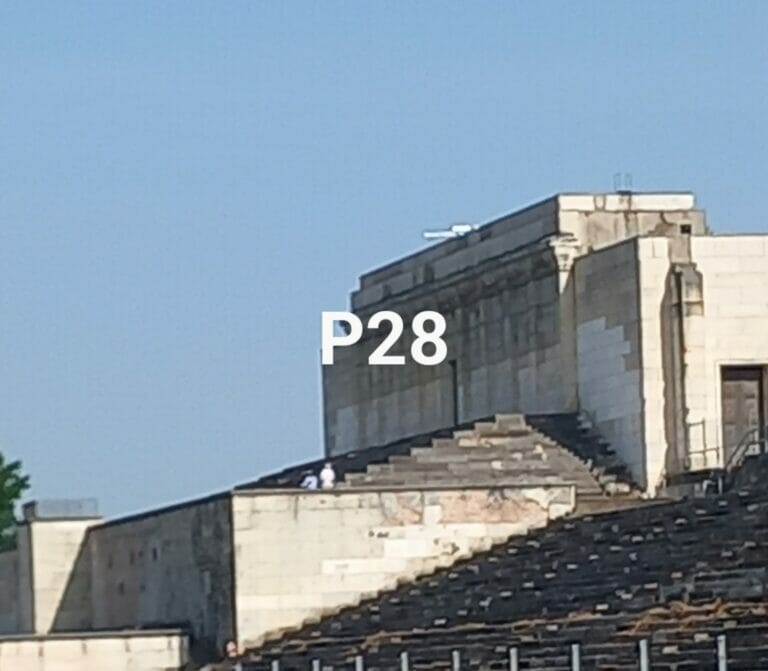
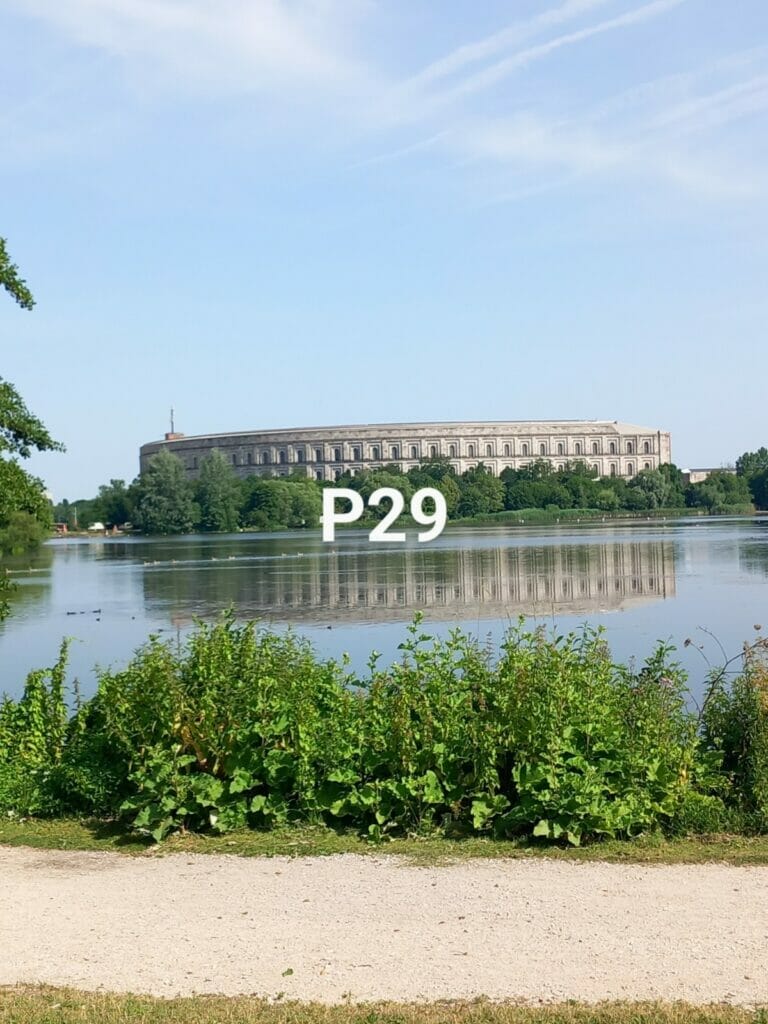 23.6.23. – On very good quality roads we headed for Belgium again and Malmedy, camping at Grotte des Nains, and it certainly lived up to it’s name! A short ride out to Spa to see the race circuit and the December 44 museum where Simon photo’d his Tiger next to a somewhat bigger Tiger tank.
23.6.23. – On very good quality roads we headed for Belgium again and Malmedy, camping at Grotte des Nains, and it certainly lived up to it’s name! A short ride out to Spa to see the race circuit and the December 44 museum where Simon photo’d his Tiger next to a somewhat bigger Tiger tank.
24/25.6.23 – The final leg of our return was to camp at the Juegdstadion Ypres where we have stayed many times previously. Throughout the tour we had planned on celebrating with a steak at In‘t Klein Stadthuis, but at £29 a head it is just not a realistic price. By coincidence the Flanders car rally was finishing in the town centre and I had to check myself from complaining about all the fuss, as if it were a bike rally I would have very accepting; each to their own. Unfortunately the Last Post was being held on the bridge outside of the Menin Gate as it was being refurbished On Sunday we explored the Great War scenes and despite having been doing this for some 30 years or so there is always something new to find, such as the commeration of the Christmas eve truce in 1914, though having the football on a cannon inaugurated by Platini is now questionable. (P33, 34)
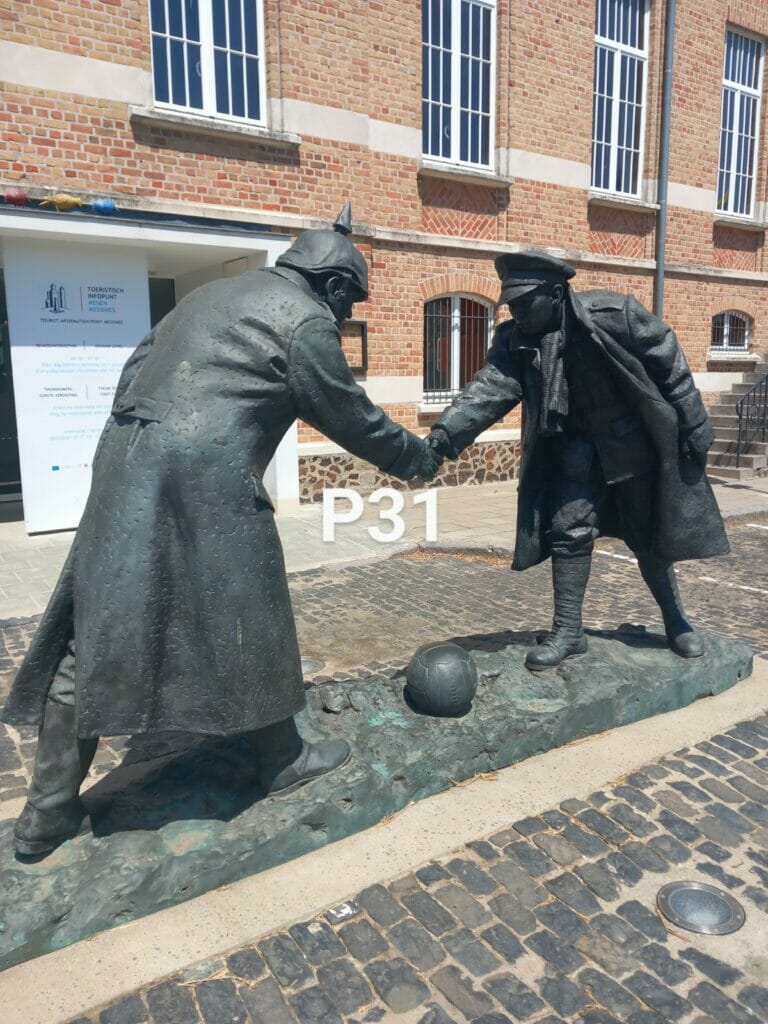
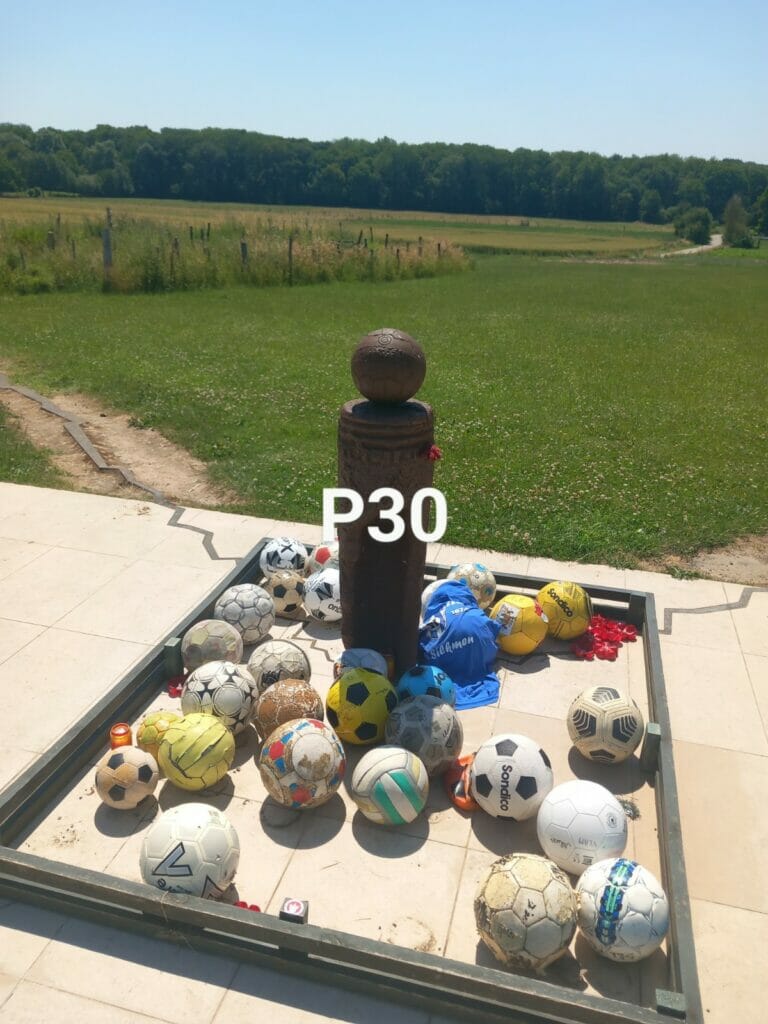 Monday 26.6.23 was our final day in Europe, where we visited the monument to the Indian troops at Nueve Chapelle and the adjacent Portuguese cemetery and small chapel of Fatima, (P35,36) unlike any chapel I had seen before being more reminiscent of a family living room. We caught the Chunnel early evening and stayed at the Premier Inn at Ashford overnight before a very relaxed journey back up north to Louth.
Monday 26.6.23 was our final day in Europe, where we visited the monument to the Indian troops at Nueve Chapelle and the adjacent Portuguese cemetery and small chapel of Fatima, (P35,36) unlike any chapel I had seen before being more reminiscent of a family living room. We caught the Chunnel early evening and stayed at the Premier Inn at Ashford overnight before a very relaxed journey back up north to Louth.
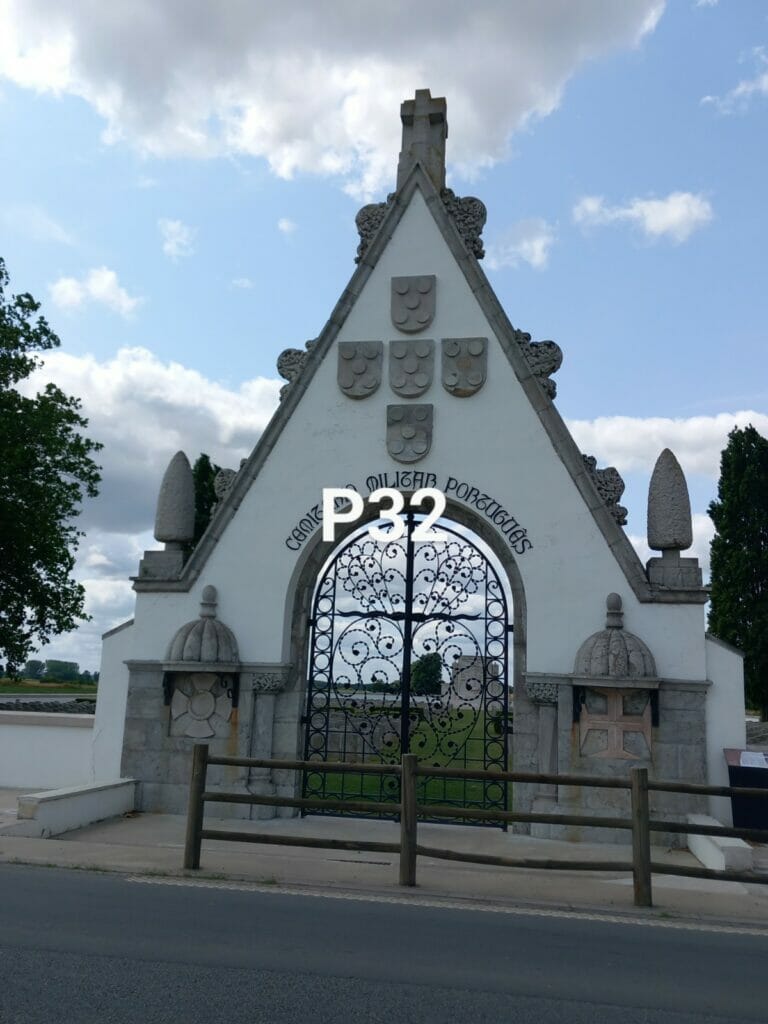
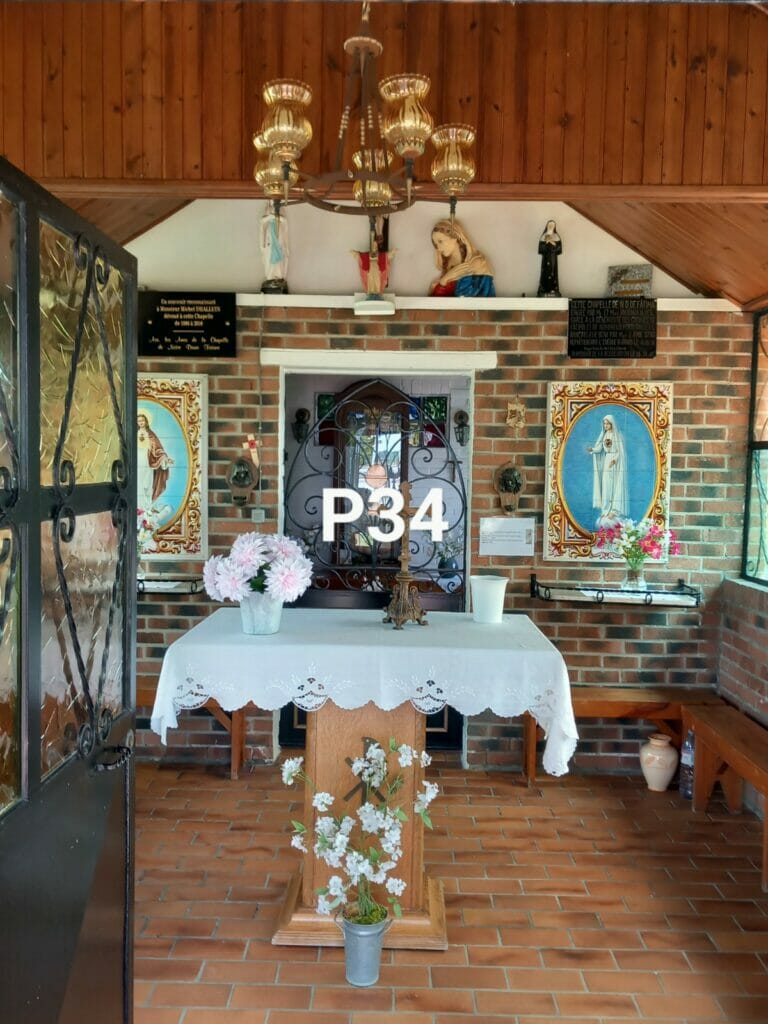
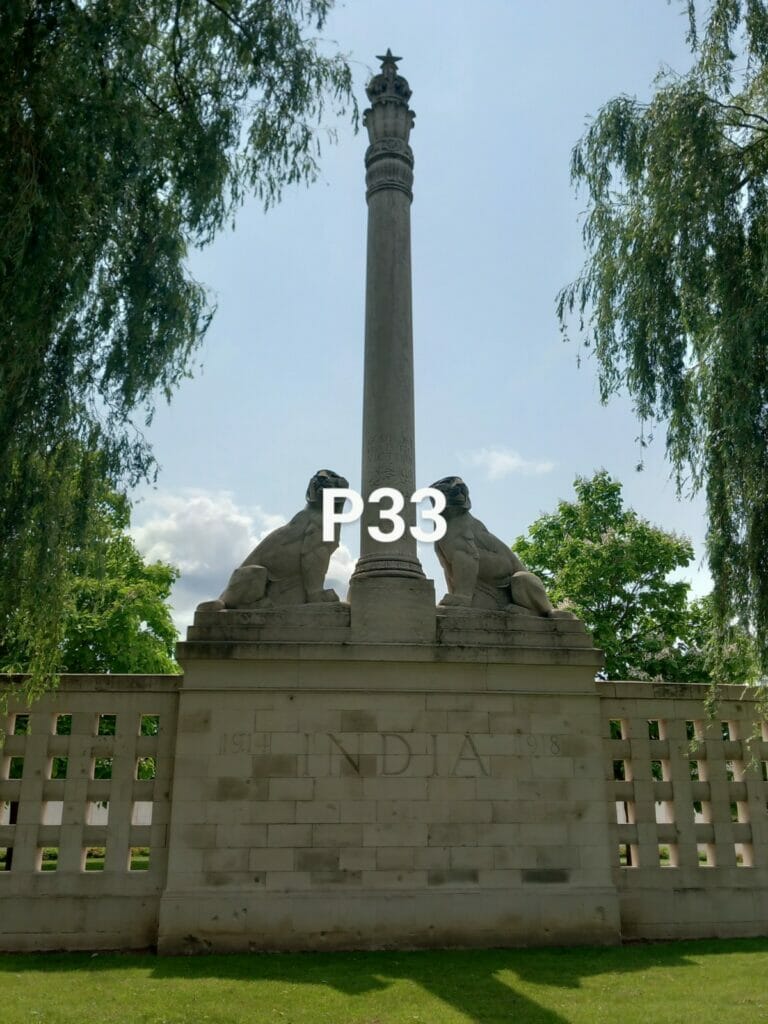
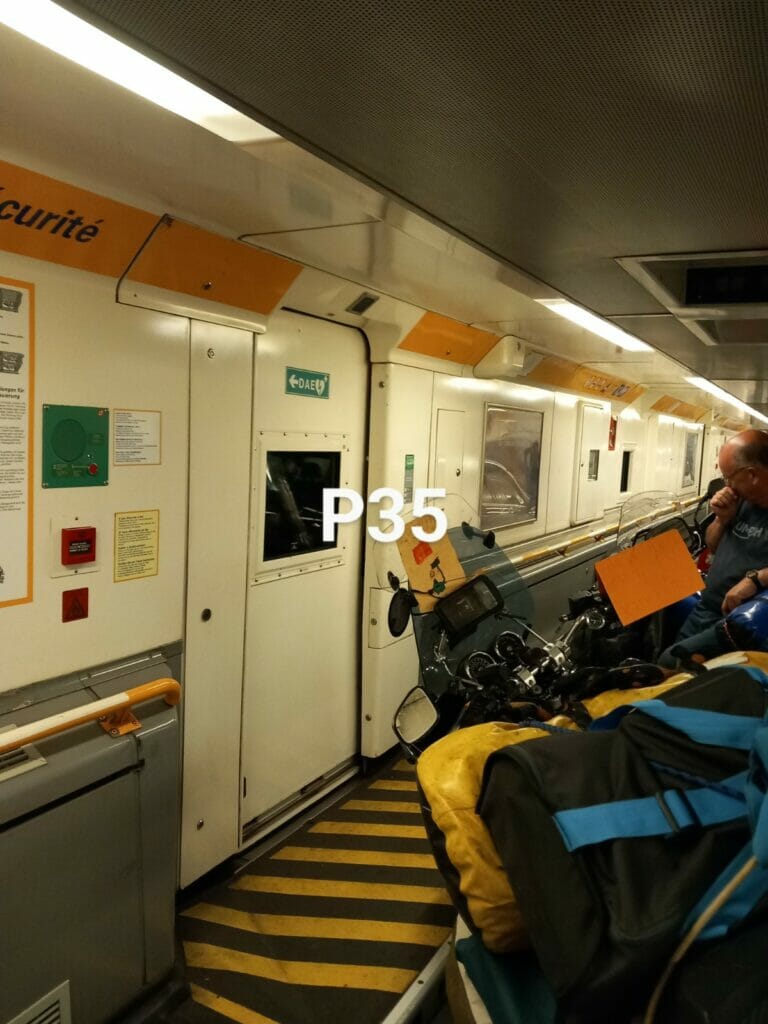 At 38 days and 5,500 miles it was a fantastic experience and well worth the overall cost. There’s a debate about what makes an adventure bike and in the 1970’s all my bikes provided adventures of many hues, the Interceptor recreates that same feeling.
At 38 days and 5,500 miles it was a fantastic experience and well worth the overall cost. There’s a debate about what makes an adventure bike and in the 1970’s all my bikes provided adventures of many hues, the Interceptor recreates that same feeling.
So, Who’s up for Greece 2025?.c
International Rally, Greece, June 2023 – Picture Galleries
The following galleries contain all of the pictures sent to us by Andreas of the Greek REOC Branch, organisers of the 2023 International Rally. They are made available here for anyone, members and non-members to see, to show you the kind of events that you can participate in as a club member.
Click on any picture to bring up the gallery viewer with the larger versions of the pictures.
Gallery 3
Gallery 4
Gallery 5
The world’s fastest Enfield, AKA Land Speed Record Royal Enfield
Words and photos by Pierre Martin (author of REOC Alcester Field Day 1998 – Data sourcing: The Gun #139 & misc.)
As far as land speed record is concerned, we all remember the exploits achieved with the Triumph Bonneville on the salt flats. But when it comes to think of the quickest bike of the world in 1970, few will be quoting Royal Enfield.
However, the first one to go over the magic 200 MPH mark was indeed powered by Royal Enfield.
In the early 70’s, the Southern Californian Timing Association was offering a timing service to riders of machines ranging from 50 to 3000 cc. Although Don Sliger broke the record, it was not to be ratified because he reached “only” 194.74 MPH (313.31 Km/h) on the return run.
With non standard engines for sure, the twin-twin-Interceptor was a one-off, but with an almost 1.5 litre capacity altogether, it allowed Don Sliger to reach 203.16 MPH (326.88 Km/h). The machine re-surfaced in 1997 in issue #135 of The Gun magazine and it didn’t take long before REOC Member Les Power made the deal to acquire it.
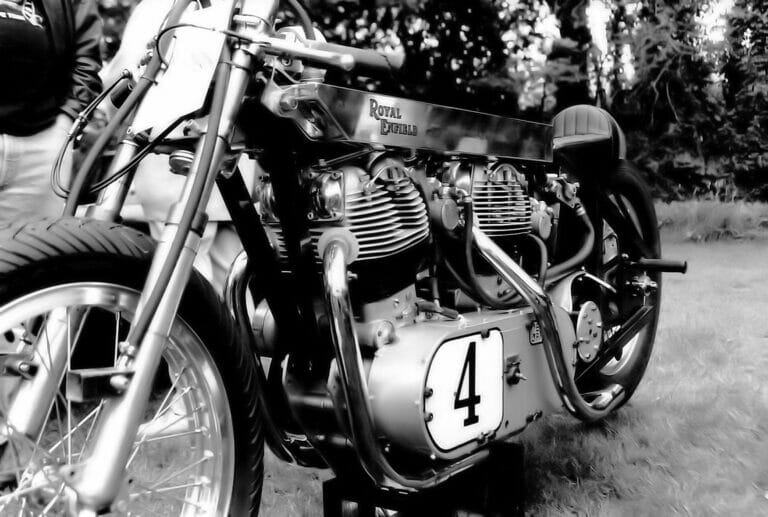
Front wheel hub is magnesium bolt onto RE forks. The air scoops located either side of the fork are not to cool the (non-existent) brake, but to catch air at speed to duct it into the petrol tank and increase the fluid flow through the two ½ in. taps.
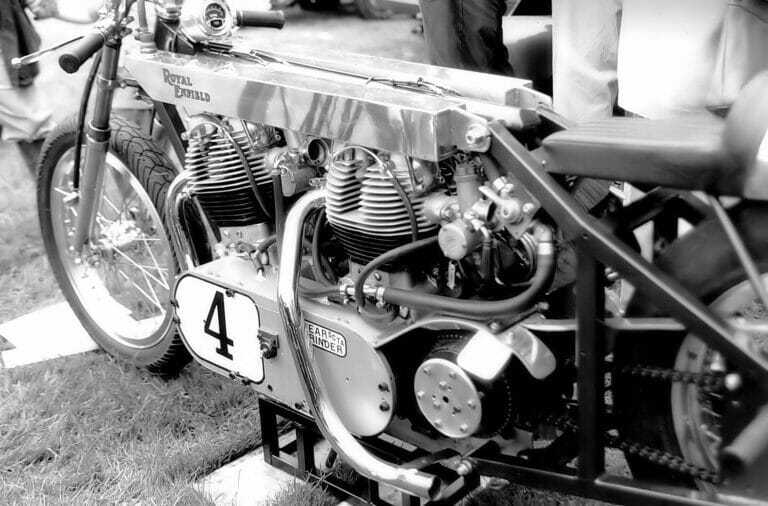
During the 1968 test ride, Sliger found the machine was unstable (wobbling) around 185 MPH. He then decided to build this new frame and use gear primary drive with three straight cut gears to avoid the known problems with chains. Both engines are then running in the same direction. Primary gear lubrification relies on the engine breathers. The camshafts were specially designed and supplied by Weber Cams. The clutch relies on a 6 springs system, but with numerous discs to cope with the torque.
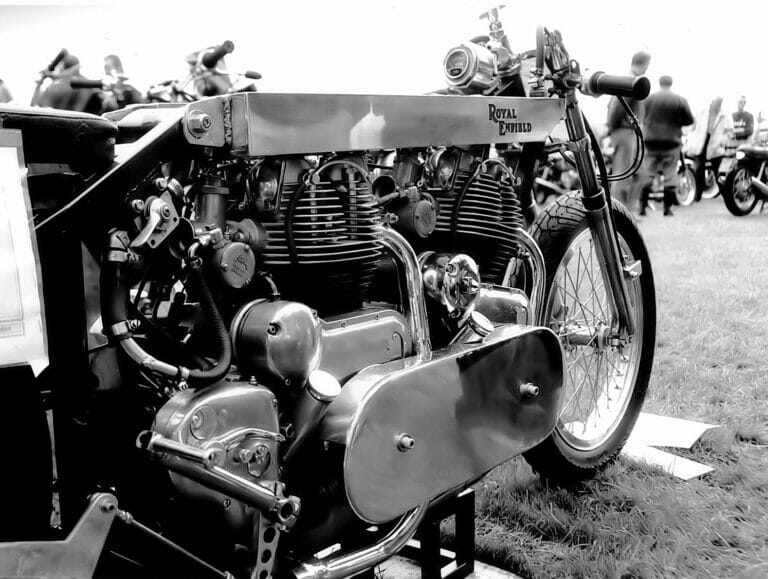
The engine balancing is crucial as soon as quick increase of the revs is required. The weight of the impressive primary gearing is counter balanced on the timing side by rotating weights. I was unfortunately not fully aware of this when taking the photographs and I certainly have missed the opportunity to study this any further.
Considering its actual shape, Sliger is often considered as the builder of the machine. Actually, he started from a previous project launched by Jimmy Enz. Originally, both engines were coupled by chain and tilted forward. In 1967, Enz had reached 192.27 mph (309.36 KPH) but had to give up after a chain broke up… and a tyre parting into pieces. This may be the reason why two different photographs are known, but there is another important change.
Further racing in 1968 showed some wobbling in the steering around 185 MPH (297,66 KPH). Sliger then decided to build another frame with a huge 2 in. spine tube and to couple the engines via gears to sort out the problems encountered with chains.
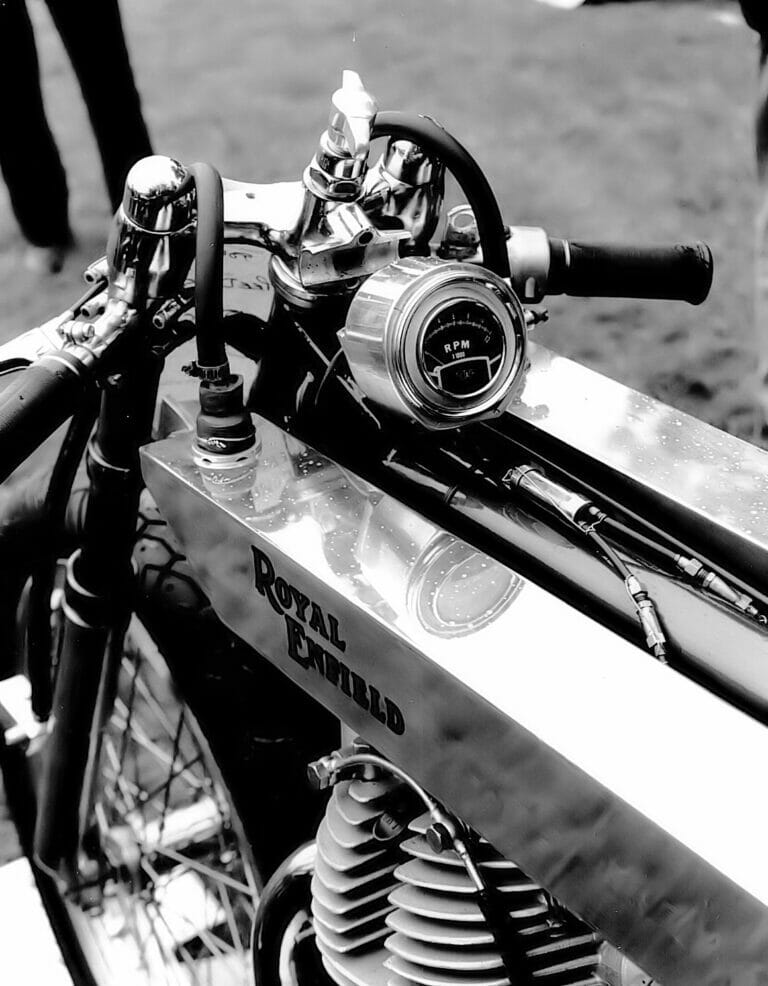
The frame top section is made from a 2 inches tube. The engines are held with conventional plates, but made of alloy. The gearbox sits behind the engines. Two detachable lugs are supporting the engines at the front and a similar layout is used at the back. The wheel base is no less than 70 inches and there is obviously no suspension at the back. Filling the tank involves removing it, put it upside down and fill through the taps ! But you wouldn’t want the rider to inhale the mix or any leak, would you?
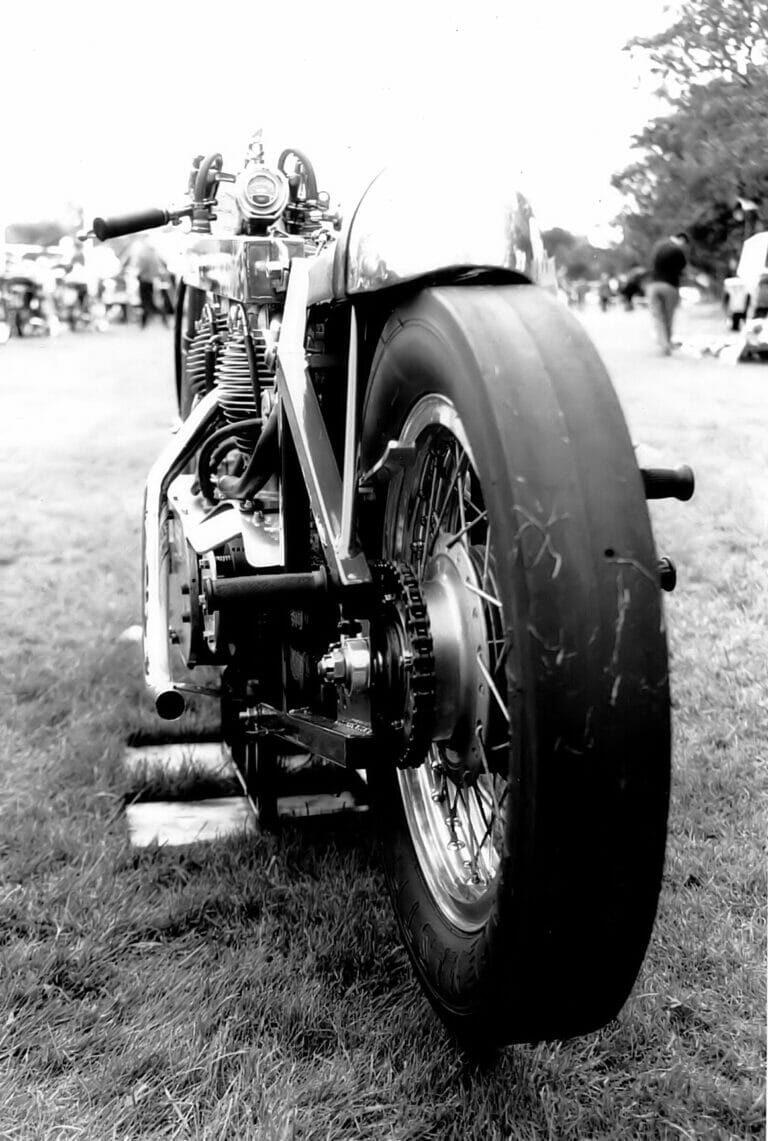
The rear brake relies on a Japanese hub. The 3 inches wide rim allows the fitment of a flat slick tyre.
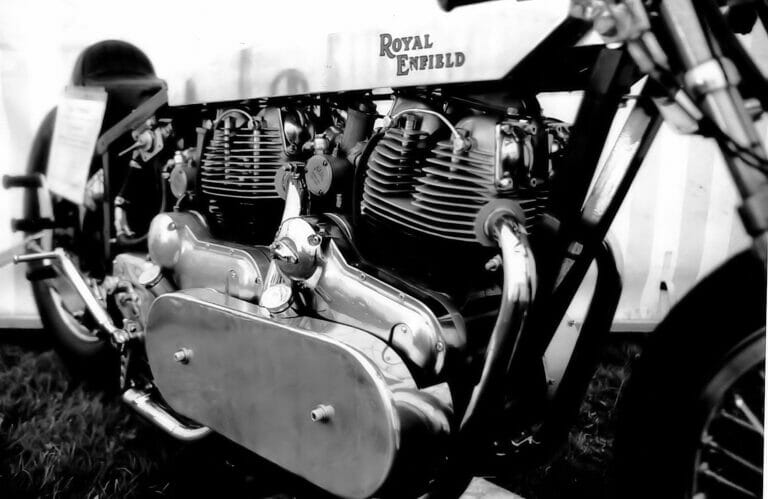 In closing…
In closing…
Enz, or someone else, may have tried another engine configuration at some stage because there are a few photographs in existence from other RE coupled engines, but with the back engine head and exhaust facing backwards, allowing the fitment of a central carburettor but I do not have any knowledge about this one.
As it is often the case in the USA, a record benefits from advertising. The Weber company, who had supplied the special camshafts for the engines, inherited the benefits. Unfortunately, the achievement didn’t fly over the ocean to save Royal Enfield motorcycles from closure.
In the end, anyhow, only a 2 litre turbo engine achieved a better performance… years later.
Any additional contribution to this article by those with more knowledge would be welcomed to benefit the RE enthusiasts’ knowledge.
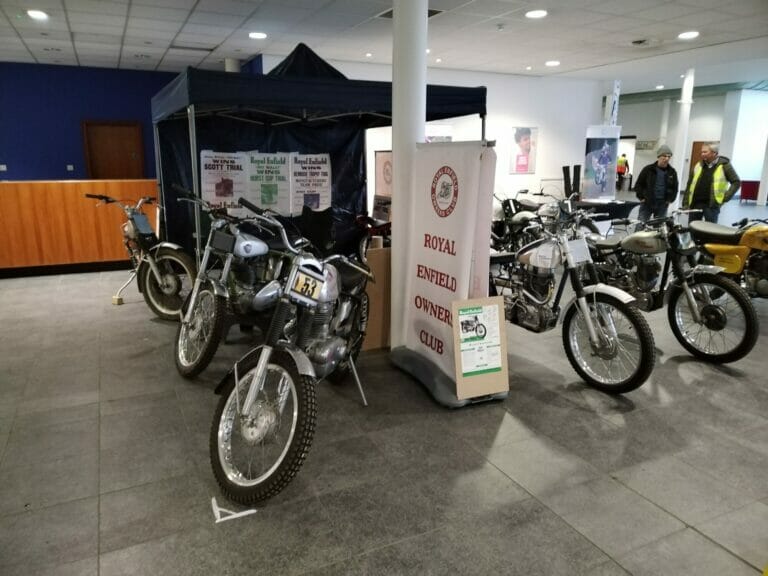
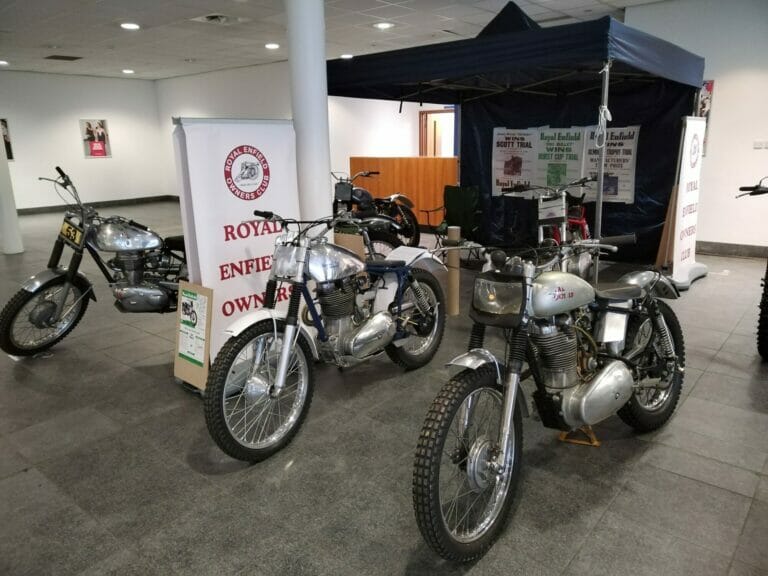
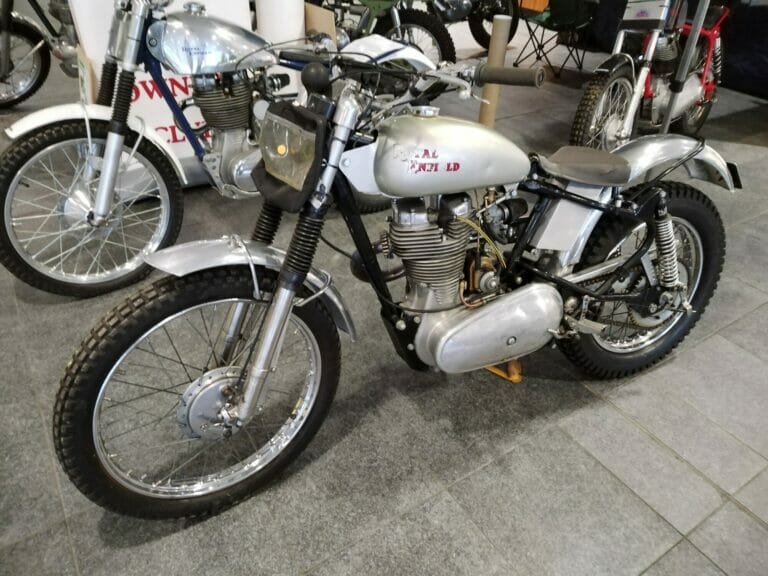
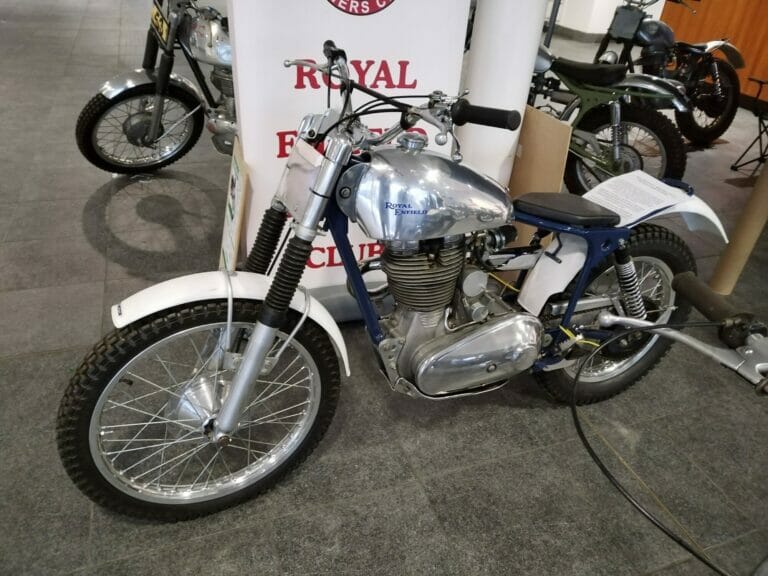
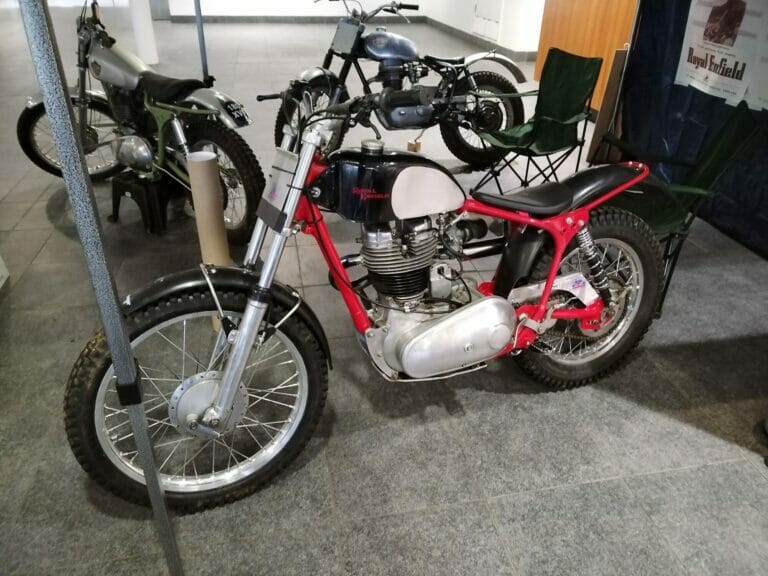
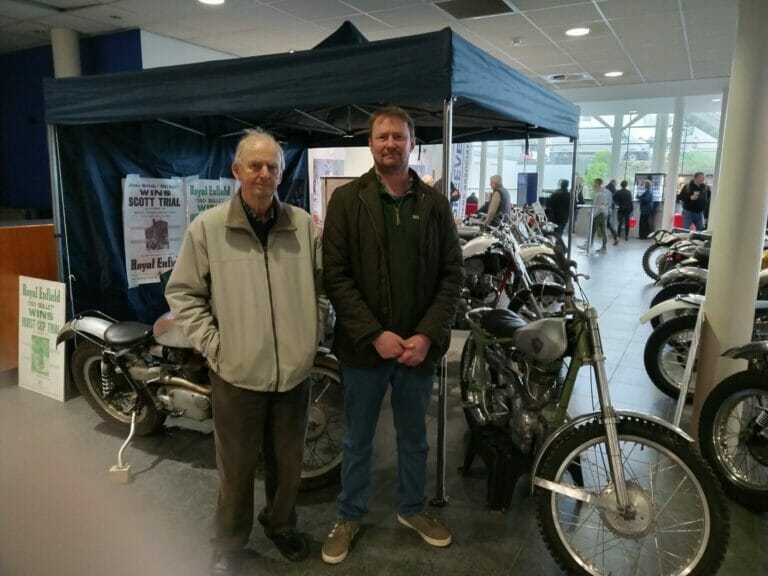
Pat and Ian Brittain, 11th Feb 2023
Barry Rogers, the current owner of the 250 RE registration, the former John Brittain and Peter Fletcher Crusader trials machine, called by for a natter. His visit reflected the warmth felt towards RE in the trials world even from those who did not ride them.
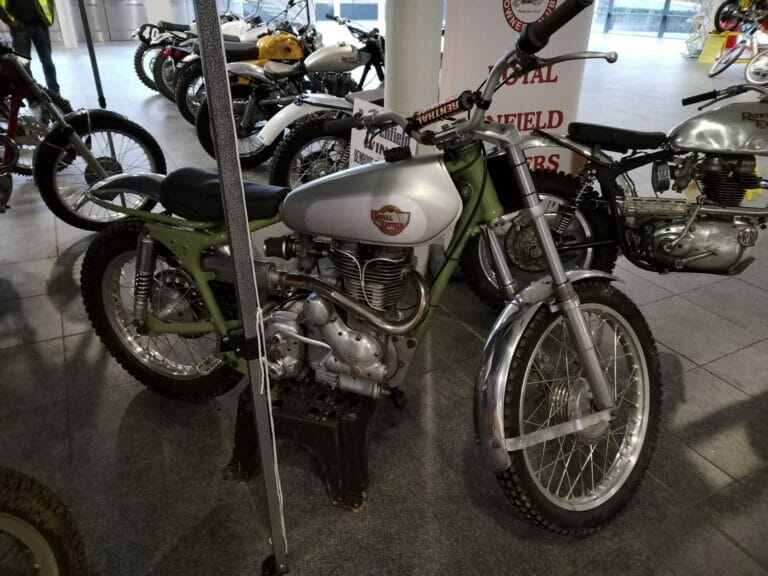
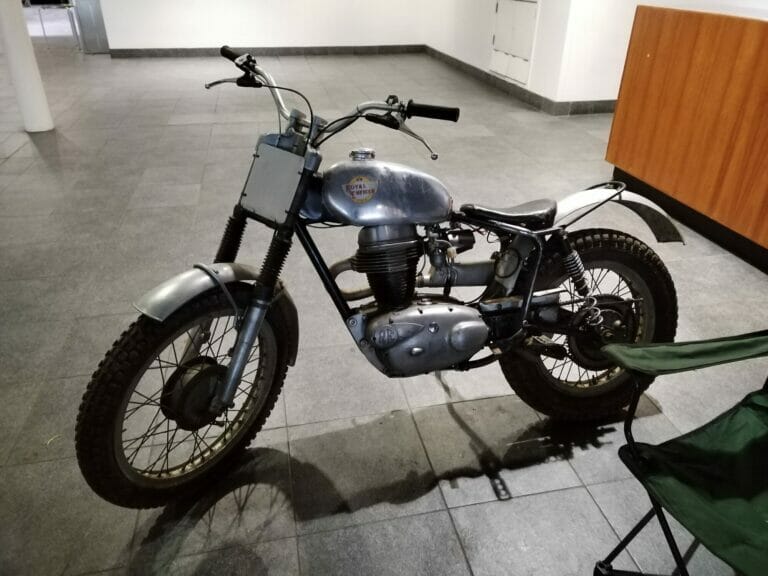
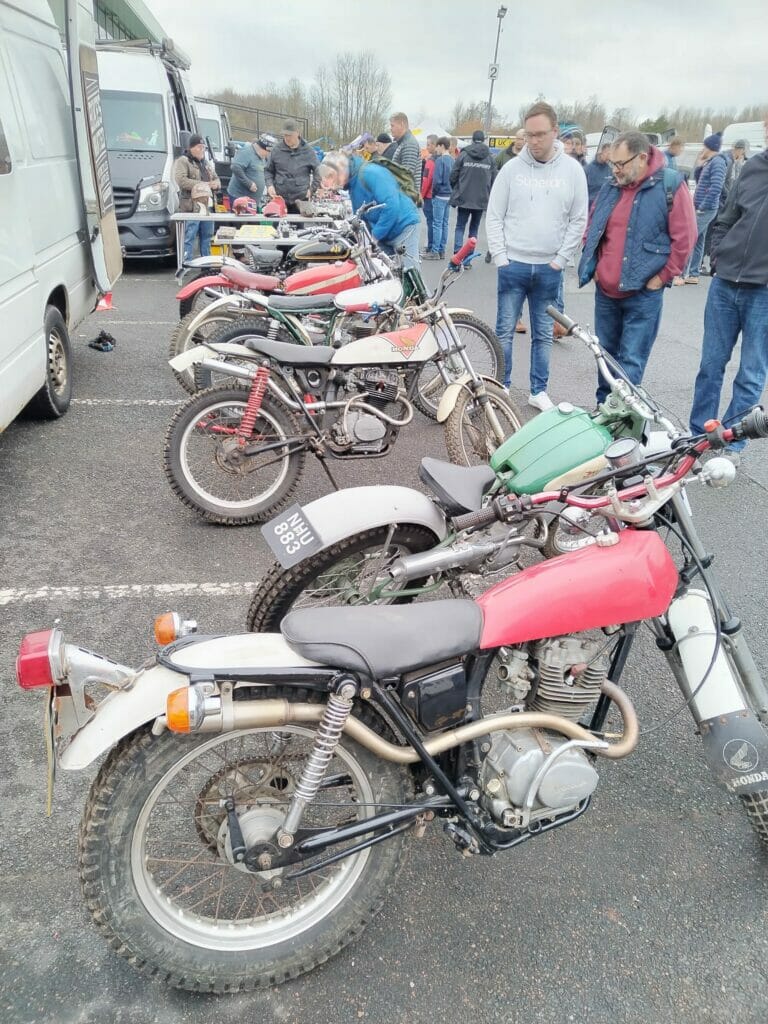
You can have Trials fun with almost any bike, even something bought for a few quid and a pasty.
JD Midshires REOC.
This motorcycle uses a 1971 Rickman frame that was originally fitted with a 750 Royal Enfield series 2 Interceptor engine. The engine is an Australian designed and manufactured Carberry.
The “Rickman Carberry Metisse” is my dream combination (Mick’s Ultimate Ride (MUR)). The dream was born by a life long association with Royal Enfields and admiration of both Rickman frames and the Carberry engine.
My loyalty to Royal Enfelds started with my first bike, a 1949 350 Royal Enfield Bullet, assembled as a teenager from a mixture of parts with guidance from my Father. I got my learners licence on that bike when I was 16. After joining the RAN, I met a friend of my Father, Charlie Duffill in Perth, Western Australia, who owned a 1971 Rickman Interceptor. As a 16 year old – that bike seemed like the ultimate!.
Roll on many years later to 2010. Paul Carberry had built the Ian Drysdale designed prototype V twin engine in Melbourne and was forming a company to go into production. The concept was Paul Carberry’s and the engine used many readily available Royal Enfield components such as cylinders, heads, conrods, gearbox and primary. Other readily available parts were used where possible such as Mitsubishi starter motor, Yanmar gear oil pumps, and Nissan hydraulic valve lifters.
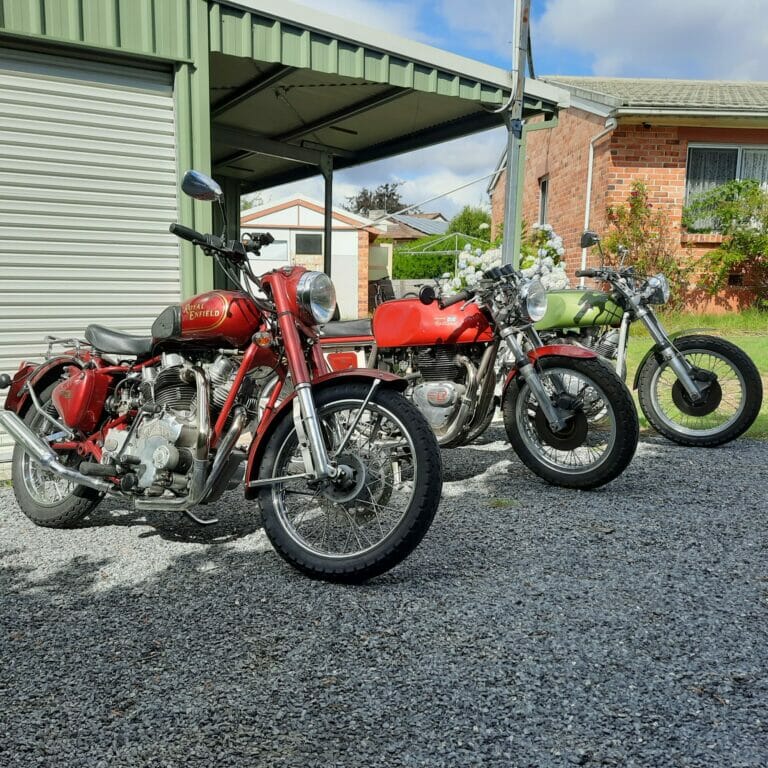
Carberry, Rickman Intercepter Metisse, Rickman Carberry Metisse
I rode the Carberry prototype and was impressed. I considered becoming a shareholder in the new company, but made the call not to. I did however maintain a keen interest in the Carberry product.
12 production Carberry bikes/engines were made, plus another was delivered to Royal Enfield in India with the objective of the concept/design being picked up by them. Some engines were sold on their own, but most were fitted to modified and engineered Indian made Royal Enfield frames and running gear. The frames were lengthened and strengthened. The company was disbanded in 2012 and Paul took the patterns to India with the intent to manufacture there.
In 2016 I bought Carberry No 8 from Mike Floyd, a major financial investor of the Carberry business.
In 2020 two more opportunities came to me. Firstly I managed to purchase approximately 1.5 Rickman Interceptors from an estate in NSW – all in parts. Secondly, I got the opportunity to purchase the left over parts from the Australian Carberry operation. After building 1 Rickman Interceptor out of the parts, I started to think about how I could marry the Rickman left over parts with the Carberry parts of which there were 10 of some parts and none of others and no drawings or parts listings.
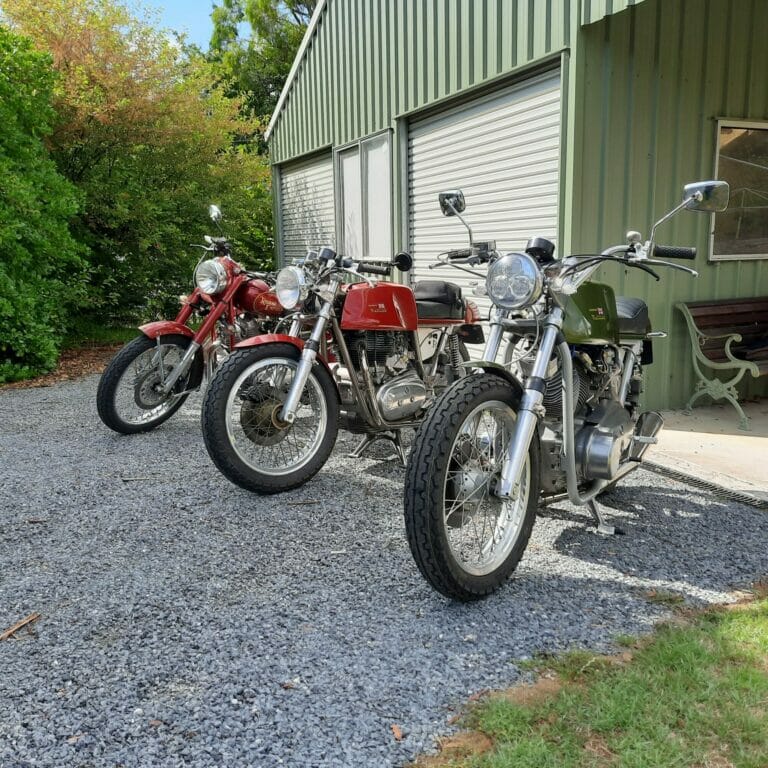
…and seen from the other side…
As you can imagine there were many difficulties in building a custom bike that was never designed to end up as 1 piece!. The first thing I did was lie the frame on the floor with a set of empty Carberry cases roughly in position. They sat there for about 2 weeks with me walking past them thinking about options and possibilities! I figured it was possible. So then the searches started for parts across the globe. Not a quick or cheap exercise. At the same time I was playing with 350 and 500 Bullet race bikes and talking to Tom Lyons (“Ace”) in the US as I have one of his Bighead heads with roller rocker assemblies. It came to light that there were 2 sets of the rocker assemblies made for the standard bullet head that were never fully machined and were still at the machinist. Long story short, I bought them for the Rickman Carberry. There were only 5 sets of these rockers assemblies made and the Rickman Carberry is fitted with 2 of them.
The frame, gearbox , fork yokes and crankcases went to Verex. The frame was bolted to a frame jig /strongback. Once the gearbox was positioned (the gearbox sprocket is as close to the swing arm pivot as you could possibly get!) the frame was cut to accommodate the crankcases. The original Carberry has the gearbox mounted directly to the crankcases in a similar way to the pre unit Royal Enfields. On this build the engine is little lower and moved forward using an adaptor plate between the box and crankcases. New chrome moly down tubes were made and brazed – just like Rickman did. I decided to get the frame powder coat painted instead of nickel plated as the cost was beyond my budget (estimates were about $5000 to remove old plating and replate).
One of the big issues was what to do for forks. The Rickman Interceptor is fitted with Rickman manufactured forks. Very nice but very rare. The stanchions on the set I had were so badly bent that somebody had cut the springs and stanchions in two to get them off the bike. The stanchions are imperial tubing that is difficult to source. After many enquires, I found a company in Canada that had made a batch of stanchions and I contracted them to build up a set using Maxton cartridge inners and my sliders. I won’t name the supplier – as their work was nothing short of terrible. All hot air and talk. Anyway – I fixed what was required – so a happy ending. This was the only bad experience I had on this build (other than my own reworks/ rethinks etc!!)
The fibreglass petrol tank was in poor condition and need repairs. The tank had to be shortened at the front /bottom as the tank and frame down tubes wanted to be in the same place. This was done and the tank lined. The seat base and rear guard only needed minor repairs. The seat was upholstered by a Mate. The front guard was sourced from Rickman in UK.
The engine build was not too difficult as I had most parts NOS. A local Vincent guru threw his expertise at the crank alignment. The biggest issue was the timing case. The only one I had was an original “reject” that that not been in the machining jig incorrectly and all machining was about 2mm out relative to the casting. After considering various fixes – the best pathway was to source a new timing cover from Carberry in India. Issues with that were that there were some design changes with timing gears and ignition pickups that made them incompatible. Anyway – long story short – we resolved all issues over time.
MotoGadet electrics and speedo were used. These are just FANTASTIC!. I have a simple single instrument and wiring with speed, revs, oil pressure, warning lights etc etc. The bike electrics have circuit breakers for each circuit, inbuilt relays (although I had to add an extra relay for the high current starter motor), programmable indicators/lights etc, no key (my mobile phone activates ignition when I am in close proximity to the bike) and the bike is alarmed.
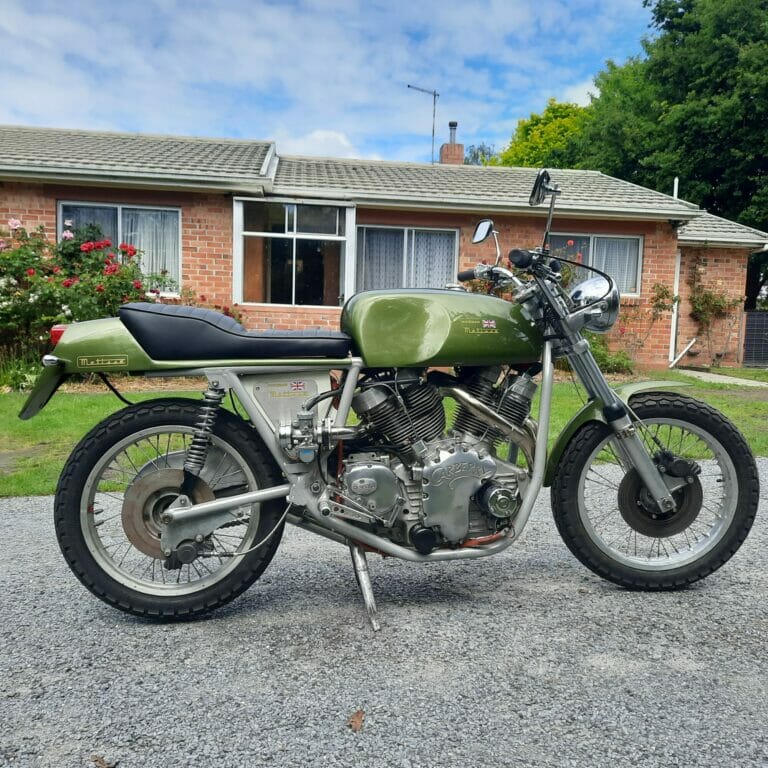
The Rickman Carberry Metisse, otherwise known as the ‘MUR’ – Mick’s Ultimate Ride.
Now I have the full suite – a reasonably original Rickman Interceptor, An original Australian made Carberry and MUR – the Rickman Carberry. The questions that may be asked may include
- which do I like best
- which is the best bike
- why do you need three
They are all great bikes – but for different purposes. I explain to my Wife – they are like shoes – you need different shoes for different occasions (actually workboots cover most occasions don’t they ?!)
This is the result!
Frame – modified 1971 Rickman Interceptor chrome moly frame. Original steering angle and wheelbase maintained, Adapted to take Carberry engine with new chrome moly down tubes joining into the original frame tubing under the gearbox. Frame modifications carried out by Verex in Tasmania. Powder coated paint.
Wheels – Rickman 18” sourced from different sellers in different parts of the world. Re spoked with stainless steel spokes.
Swing arm – second hand Rickman (but not Interceptor version). Powder coated paint.
Forks – Original Rickman sliders and yokes. New stanchions manufactured and fitted with latest technology Maxton cartridge internals with adjustable damping (both spring and return).
Rear suspension – Ikon progressive with adjustable damping.
Brakes – Original Lockheed AP racing calipers. 10” Rickman cast iron discs front and rear.
Bodywork – Original Rickman (tank modified to fit frame). Paintwork by Tabboo Restorations in Tasmania.
Engine – 1070cc 55 degree V twin. NOS Carberry crankcases and bottom end. Royal Enfield 535 alloy cylinders. Modified and ported Royal Enfield heads (by Headworks in Melbourne) fitted with “Ace” custom roller rocker arrangement increasing valve lift 45%, large valves and beehive springs. JP high compression pistons.
Gearbox – Royal Enfield 5 speed (a gearbox that was developed in UK in about 2002 to replace the original Albion designed gearbox in the last pre unit construction Indian made models)
Clutch/primary – Bob Newby clutch and 32mm toothed belt. Custom primary inner and outer cases. (Outer made using 2 cases from 2 different model Royal Enfields welded together).
Ignition system – Ignitech electronic programmable.
Carburettors – 34mm Mikuni round bore.
Exhausts and intakes – Stainless (by Verex in Tasmania). 2 into 1 exhaust system.
Electrical and Instruments – Motogadget.
Specification comparisons
| Rickman Interceptor | Carberry | Rickman Carberry | |
| Engine Capacity | 750 | 1070 | 1070 |
| Gearbox | Albion 4 Spd | RE 5 Spd | RE 5 Spd |
| Carburation | 2 x 30mm Amal | 2 x 30mm PWK | 2 x 34mm Mikuni |
| Ignition | Coil/Points | Screamin Eagle | Ignitech |
| Frame | Rickman CrMoly | RE 500 Bullet Modified | Rickman CrMoly |
| Wheelbase | 1422mm | 1465mm | 1422mm |
| Weight | 168KG | 211.5KG | 189.5KG |
| Front Forks | Rickman 42mm | RE 500 Bullet | Rickman 42mm |
| Wheels Front
Back |
Rickman 18″ Alloy rim, Magnesium hub Rickman 18″ alloy rim Magnesium hub |
RE 19″ Steel
RE 18″ Steel |
Rickman 18″ Alloy rim Alloy hub Rickman 18″ Alloy rim Alloy hub |
| Steering Angle | 27 degrees | 27 degrees | 27 degrees |
| Brakes Front and Back | 229mm CI disc with Lockheed calipers | RE 6″ Drum | 254mm CI disc with Lockheed calipers |
Enfield motorcycles were built. The Field Day event, held at Alcester Rugby Club, was
marshalled by Tony Knight and Gordon Gambrell and logistics were by the South Midlands branch
members under the leadership of Ray Tew.
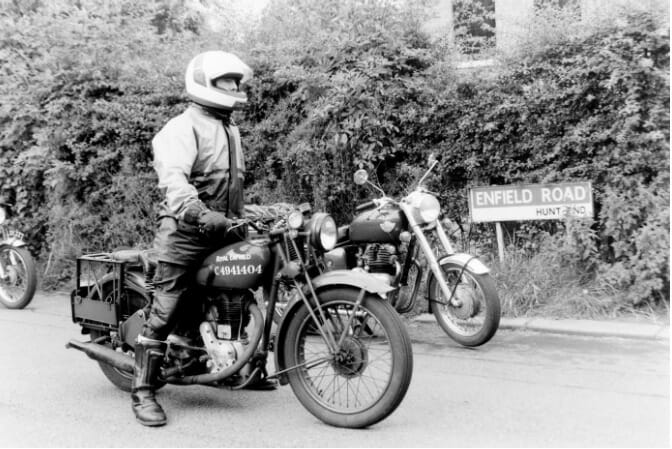
RE Bikes at Enfield Road
On Saturday morning Ray and his local Marshalls organised a run, THE RUN, to the Enfield Works.
The riders were invited to make a stop at Enfield Road, where 82 Enfield motorcycles were lined up.
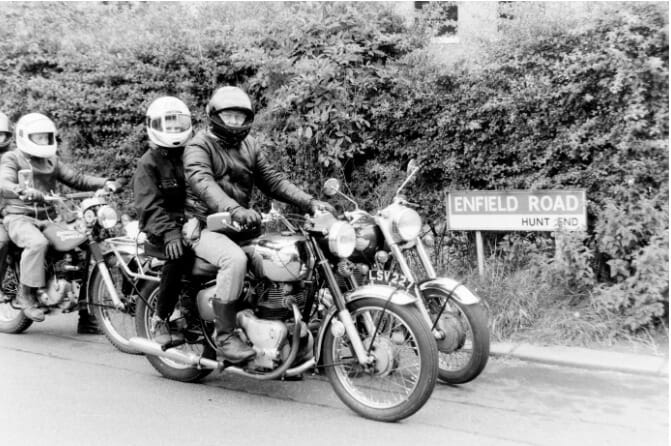
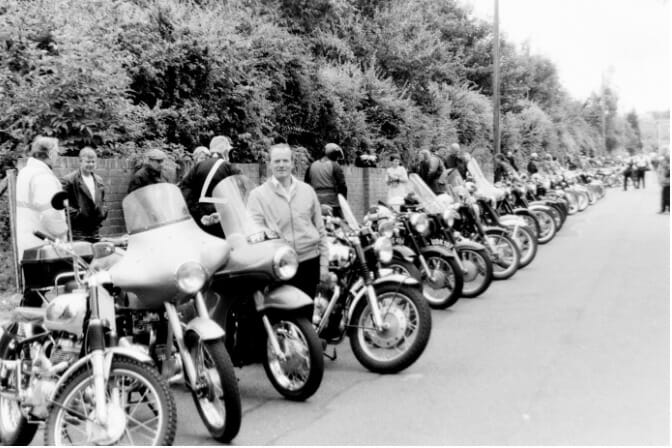
Some of the 82 Royal Enfields lined up at Enfield Road
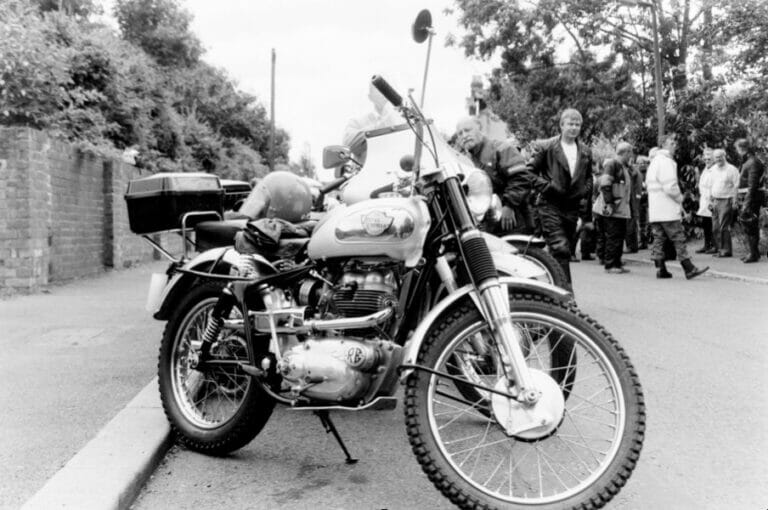
A Trials model in road-going trim
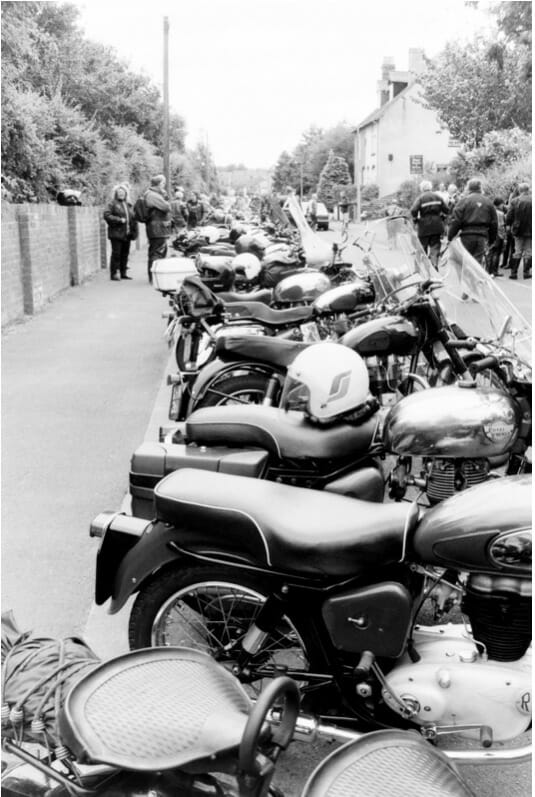
More bikes at Enfield Road
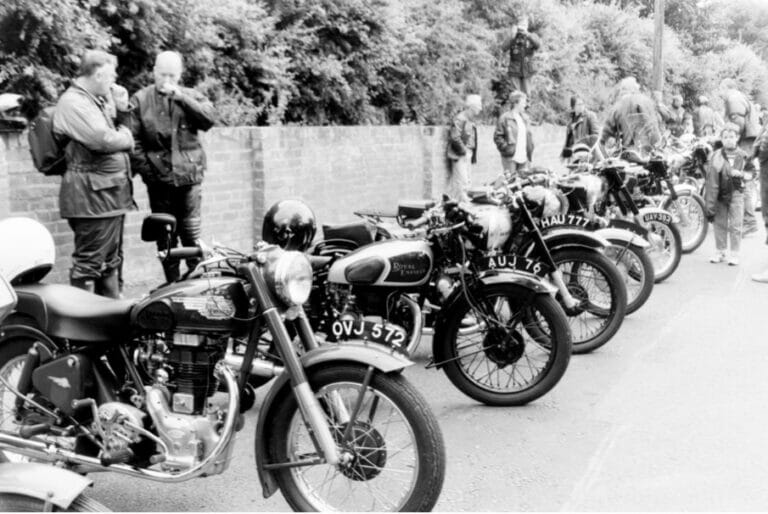
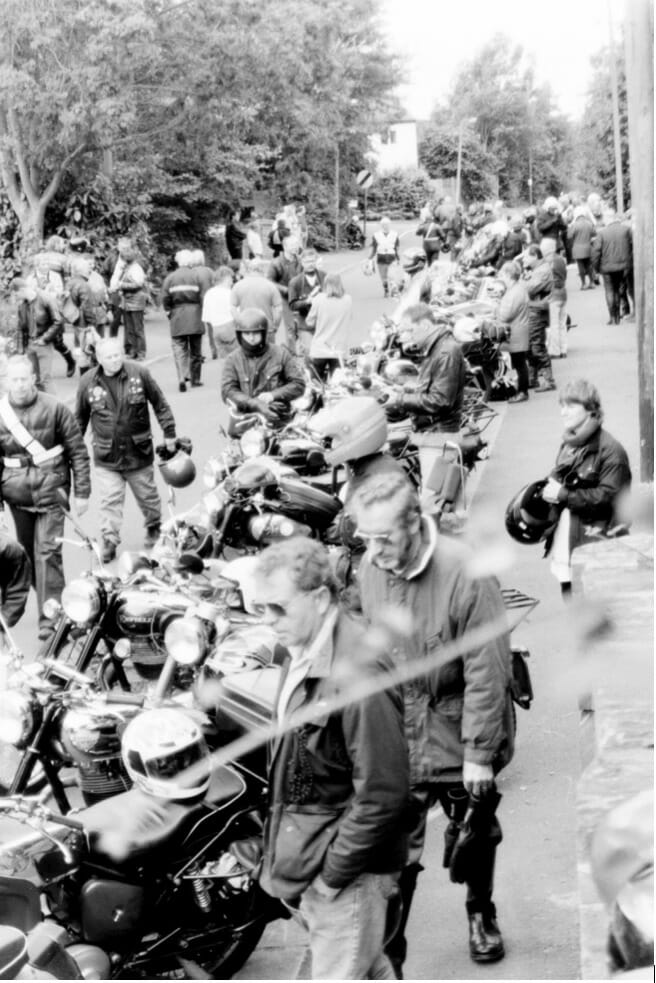
Road Closed!
The stop at Enfield Road was the opportunity to display a fine array of models, and have chats with people passing along. Obviously, the road was closed to traffic.
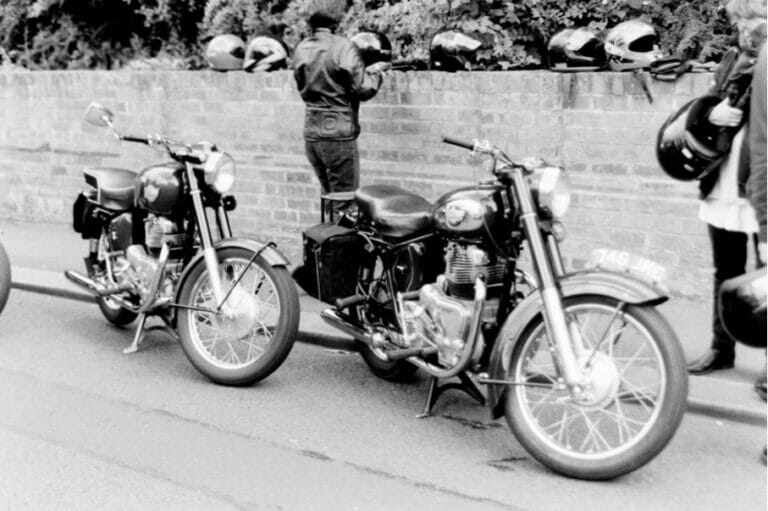
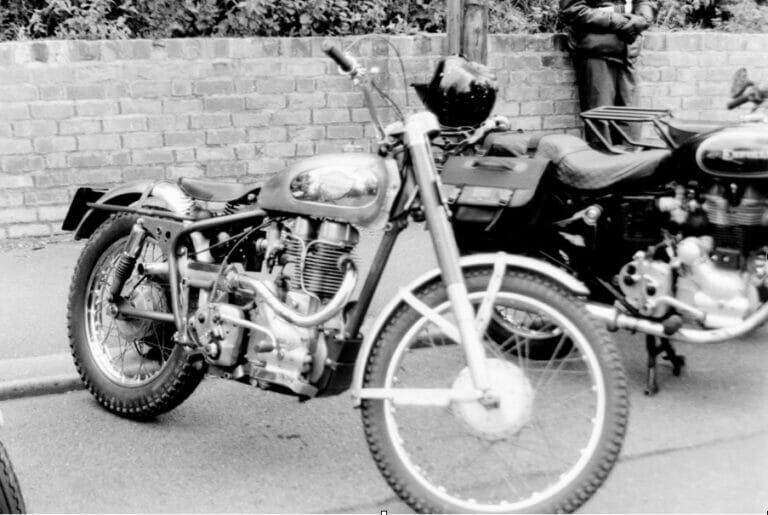
A Bullet Trials model
Several generations of motorcycles were displayed
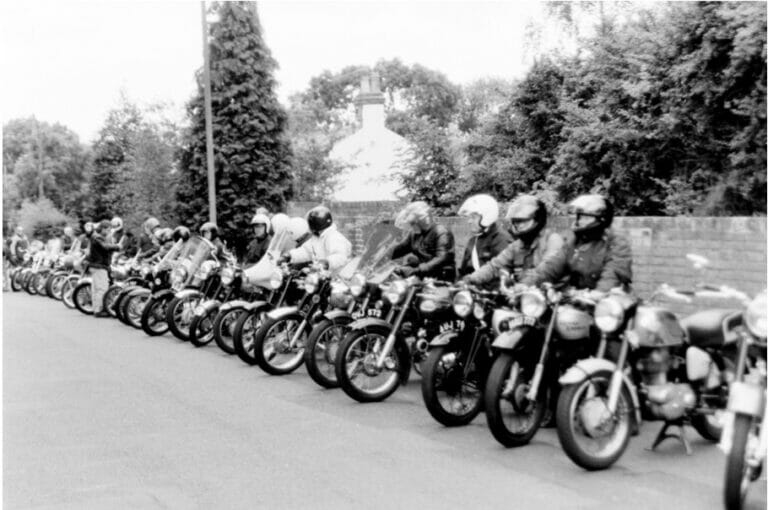
A long lineup
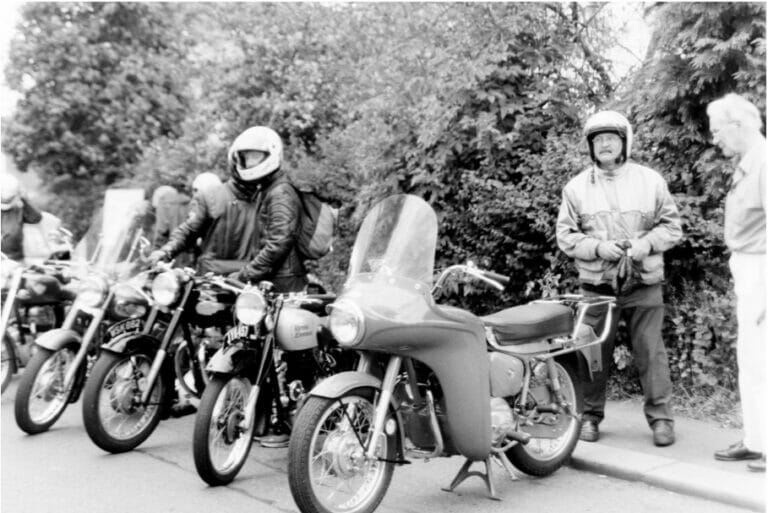
Ready to take off towards the Old Enfield works
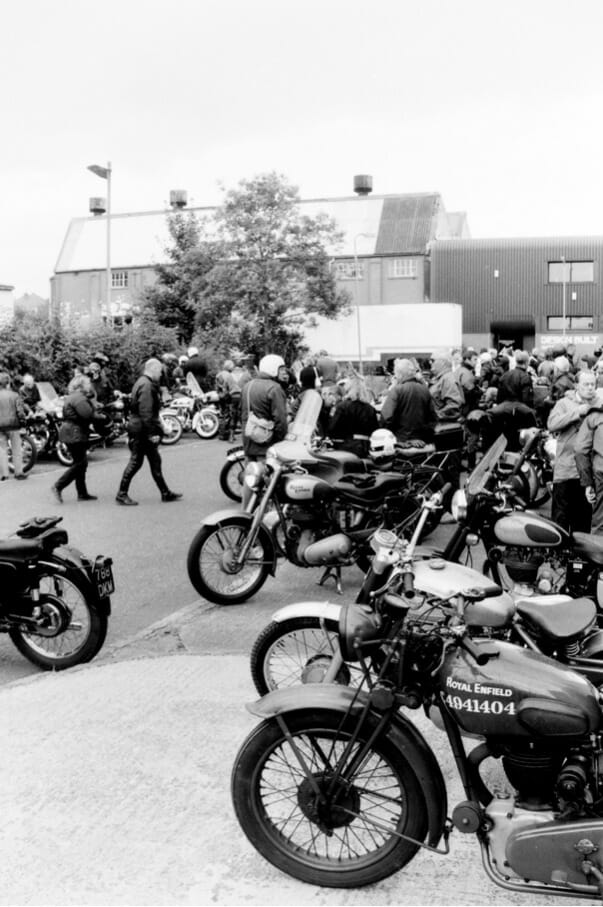
Gathered at the site of the old Enfield Works, Redditch
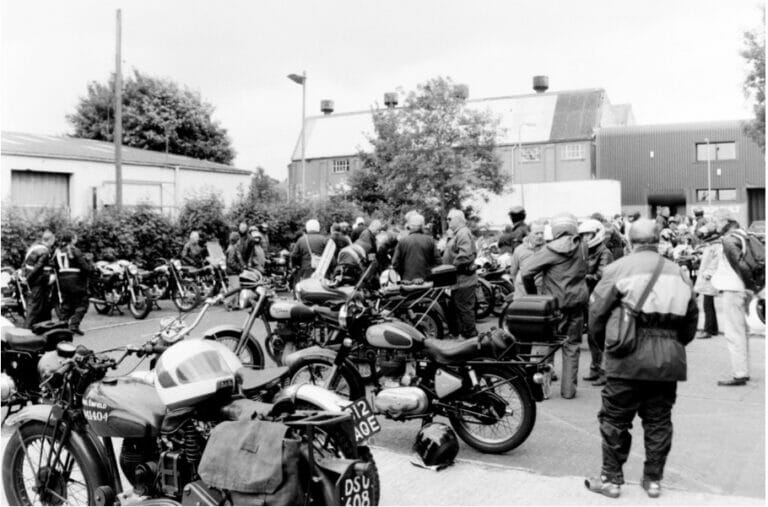
The motorcycles and riders at the site of the old Enfield works in Redditch
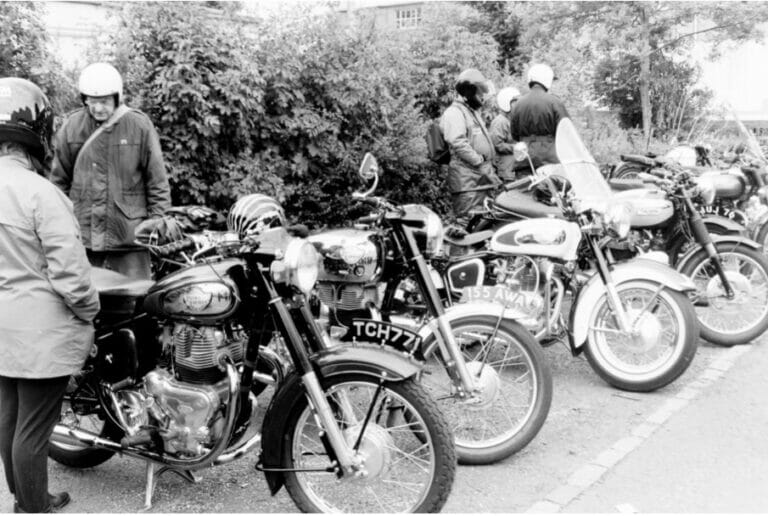
Among other Sunday activities and festivities, the motorcycles were displayed by category, ridden around the main arena to be judged for concours prizes by ex-Royal Enfield employees. Memorabilia was also displayed as well as some competition machines.
Going to the site of the old factory, sharing knowledge of history and the enthusiasm about Royal Enfields with Ray and his crew made the Alcester Field Day a splendid and memorable event.
For a full report, see THE GUN #146 – September 1998
The following additional photographs were taken by member Pierre Martin.
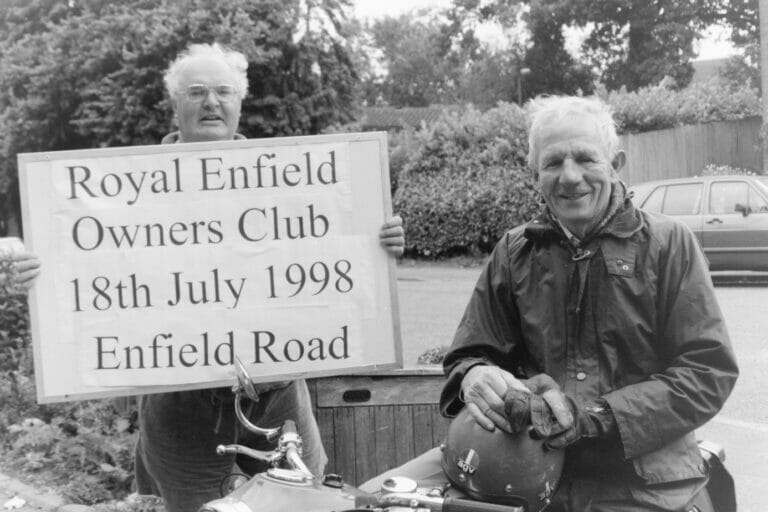
Julian Edwards and Roger Boss at the 1998 Field Day, Alcester
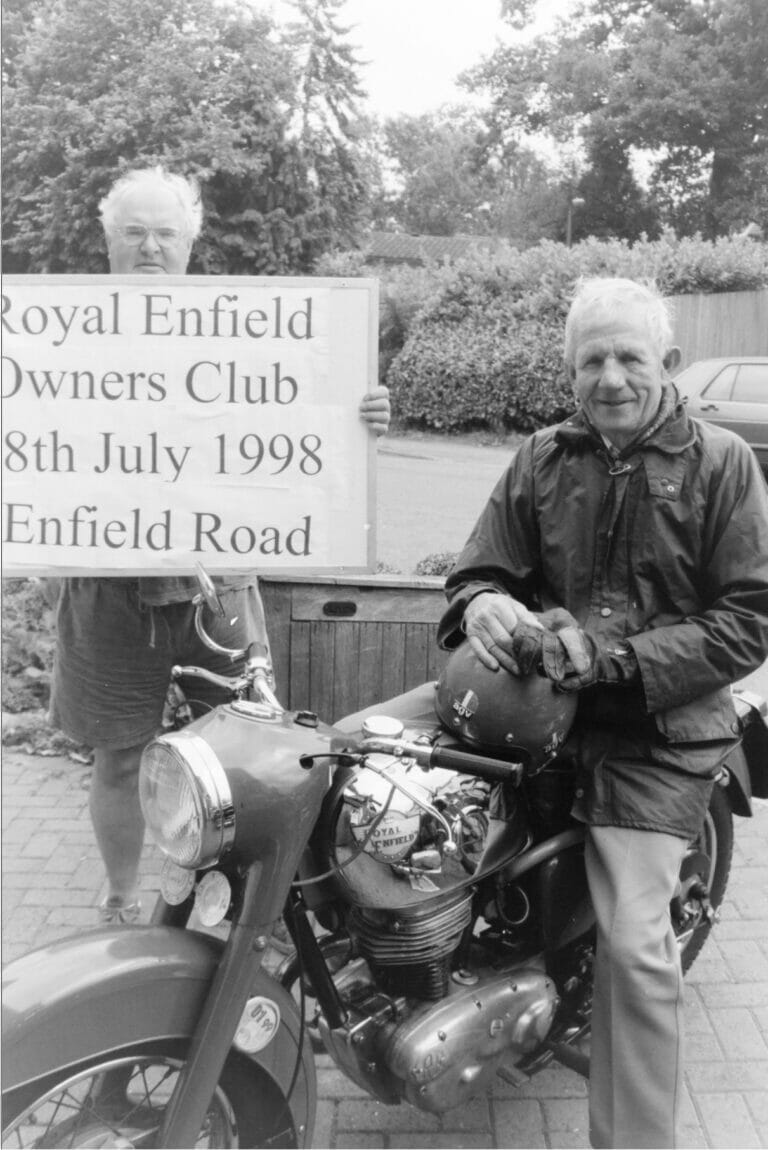
Comment, on the Jan. 16th FB post, from Robert Murdoch “The very same motorcycle on which Nigel Buckingham , R-E Tester, lost his driving licence, and hence his job. He was recorded at over 80 mph on a Redditch road where he shouldn’t have!”
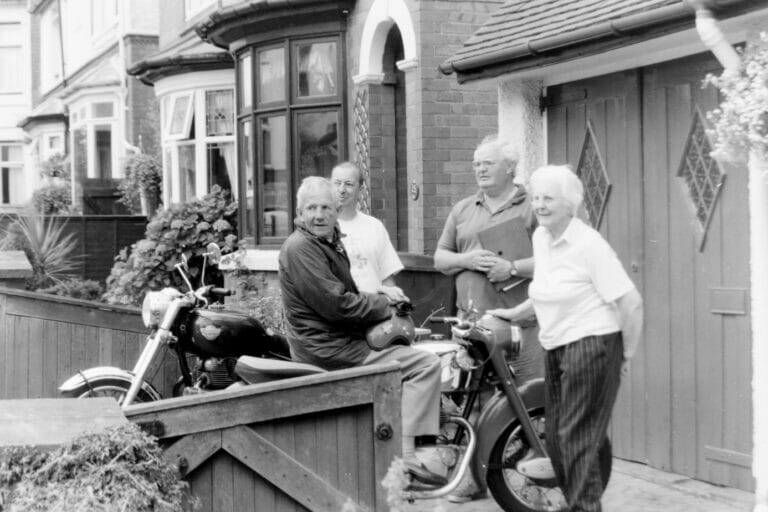
Roger Boss, Pierre Martin, Julian Edwards and Mrs Mountford (Major Mountford’s widow) along Bromfield Road (Redditch)
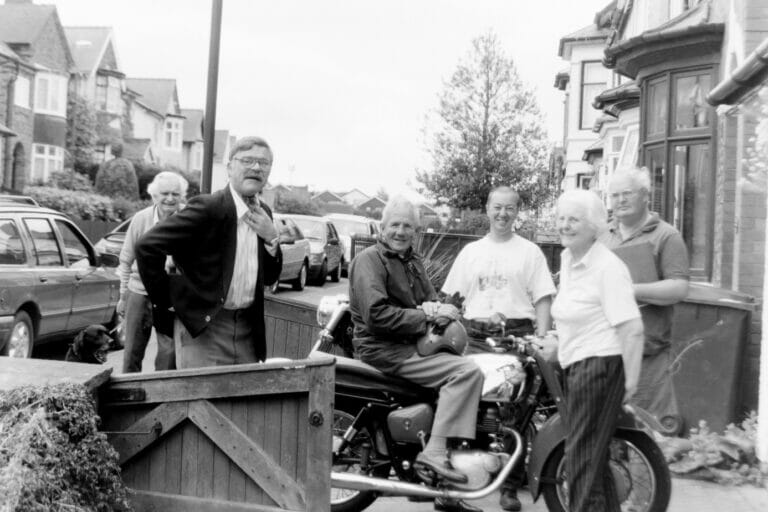
1998 Alcester Field Day… the day after. We were quietly discussing bikes along Bromfield Road (Redditch) with Frank and Julian Edwards as Roger Boss rode back to Richards Mountford’s home with the 250 prototype. Frank then brought out some documents and photographs of prototypes for secret foreign buyers and Roger was very much interested as he had not been invited to test ride them. Richard suddenly drove back home “to check that everybody was enjoying life while he was at work” and he joined us, sharing other memories. Roger recalled some very happy memories from his test rider period with Brian Crow. I’ve had good laughs, increased my knowledge of the make, had a wonderful time with pure enthusiasts. What a day!
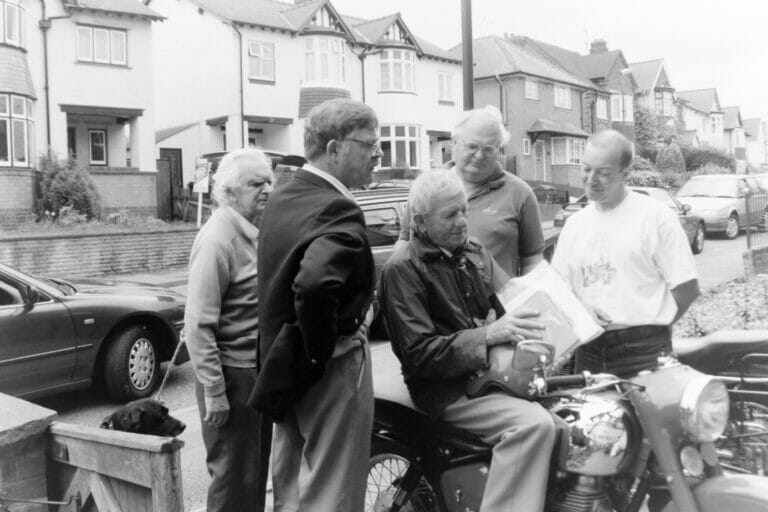
From L to R: Frank Edwards, Richard Mountford, Roger Boss, Julian Edwards, Pierre Martin commenting photographs of prototypes
A reproduction of two magazine articles relating to members of the REOC revisiting the 1949 International Six Days Trial route in Wales.
The articles are reproduced by kind permission of the publishers of Real Classic magazine.
Please click on the links below to open or download the article pdf files.
The Start
This Autumn, (end of September, beginning of October) I took part in an organised tour event, led by Nathan Millward, from North Devon to the Isle of Skye, as part of the first of two groups, mostly of larger bikes. The second group, led by Nathan’s business partner, David, left the next day, following the same route.
I was mounted on my trusty 2018 Royal Enfield Himalayan, “Sherpa” which was the smallest and least powered bike in our group (with the exception of a mid-sized Honda scooter that joined the group later that day), the next one up being a Honda CB500X, but most of the bikes being 650cc or larger, including a couple of 1200cc machines.
The tour started on the Sunday morning, and arrived at the Isle of Skye on the afternoon of the Thursday, theoretically leaving a day free on Skye and the surrounding area before we all headed home on the Saturday. But first, I had to ride from my home in North Oxfordshire to Ancaster in Lincolnshire for the REOC AGM on the Saturday, before turning around and heading down to my B&B for the night in Devon. That meant a ride of 388 miles before the tour had even begun, and a taster of what was to come the following Saturday on my way home, with a lot of motorway riding just to get the miles done before it got too late at night.
Day 1
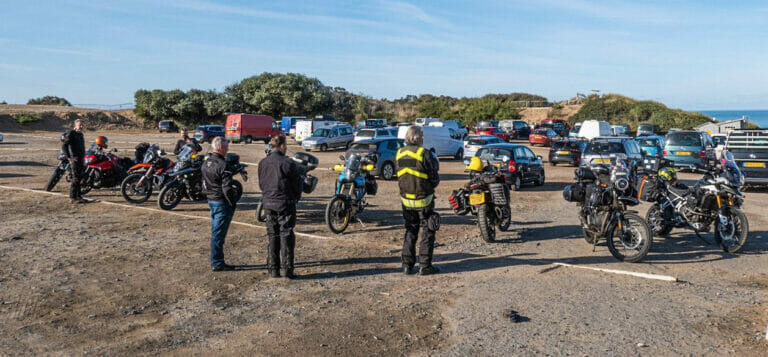
The Sea to Skye Group #1 of 2, at the starting point at Saunton Sands, Devon. My little Himalayan second from right.
The first day took us up along the North Devon coast, via the Valley of The Rocks, Lynmouth, Porlock and Minehead, before zipping up the motorway towards and around Bristol, and stopping at the old Severn Bridge services at Aust to collect the reminder of our group who were meeting us there. Then over the bridge and into South Wales, via back country roads to Abergavenny, onto Llandovery and then up towards the mountains, via the Devil’s Staircase and down towards Llanwrtyd Wells and our stop for the night at the Neuadd Arms hotel (All our stops were hotels, thankfully no camping on this tour – setting up camp every evening then having to strike camp and re-pack the bike early every morning would have been no fun, at least for me).
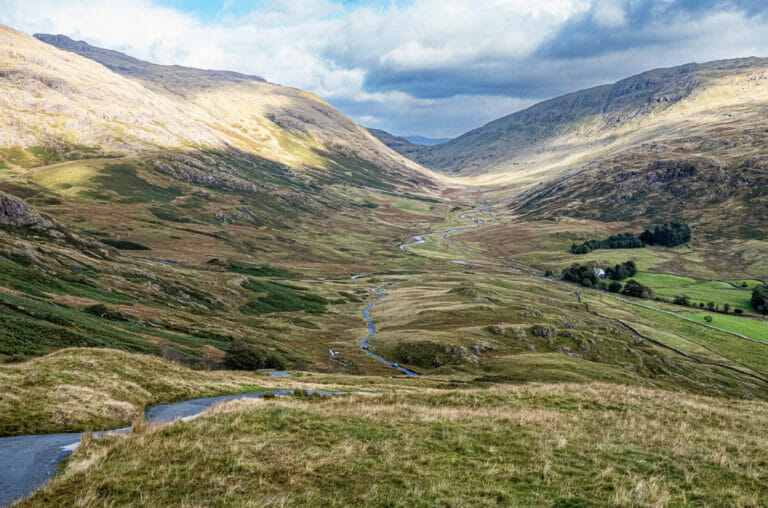
Our route back down the mountains towards our first hotel stop.
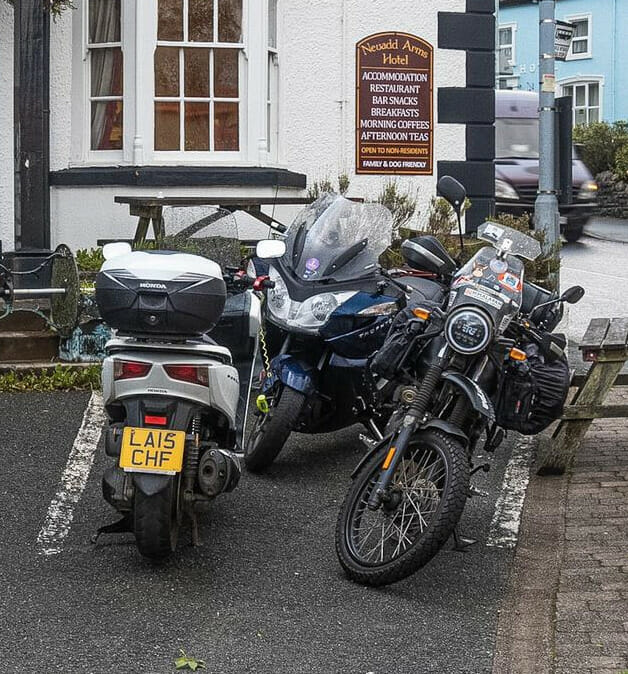
Part of our group outside the Neuadd Arms Hotel, Sherpa the Himalayan on the right
Day 2
The next day, in pouring rain, we all fuelled up, then set off northwards towards the Snowdonia national park region. This was when some of the limitations of the Himalayan became more apparent, as ALL of the other bikes (with the exception of the rider on the Honda Scooter, who joined us at the Severn bridge) could easily do multiple vehicle overtakes with ease, and romp up steep roads (which we encountered a lot) whereas I could only plod along, often unable to safely overtake even a single vehicle at times, depending on how fast they were going. On narrow wet roads, with lots of bends, overtaking on a Himalayan isn’t all that easy. It can maintain 70mph on a dual carriageway or motorway no problem, but snap overtakes past fast moving vehicles on most other roads are rather difficult to achieve safely.
The weather was extremely changeable that day, veering from sunny, to drizzle, to windy, very cold and torrential rain, often changing in a few minutes from one to the other. At one time, while riding around the valleys near the reservoirs in the Elan valley, down a majestic avenue of tall trees, attempting to avoid the lines of mushed up leaves (as slippery as wet ice) I suddenly heard a sound like a Messerschmitt coming in for a strafing run. As we slowed to a halt at the top of one of the dams, I looked down, to see that my aftermarket silencer had parted company from the exhaust downpipe.
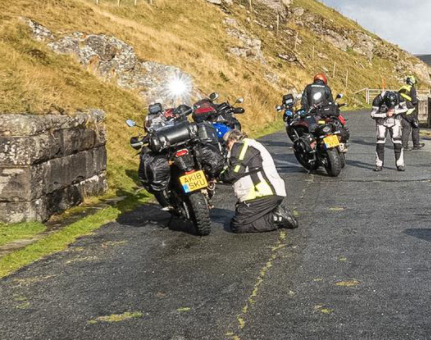
Me having to fix my silencer in bitingly cold winds at the top of one of the dams in the Elan Valley.
Odd, as it had been on the bike for more than six months with no previous problem. It took some sorting out, and borrowing some tools from Nathan (as my small ratchet chose that time to give up the ghost) but I was able to re-tighten the clamp enough to hold the silencer more or less in place until we got to the next hotel at the Wirral Peninsula that evening where further repairs were undertaken.
Onwards we went, stopping at the Devil’s Bridge station tea rooms for elevenses, and then onto the coast for a brief lunch stop, where the sunshine came out for a short while, before turning to torrential rain again, a few minutes after a few of us had sat down around an outside table to eat lunch.
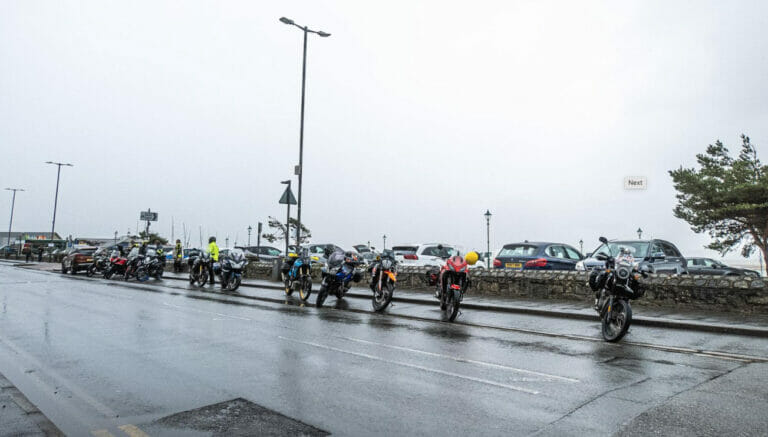
A wet seaside lunch stop
We continued onwards, following the coast road for a while, before heading back up into the mountains and more bad weather. Taking it very easy on the wet and slippery roads, I lost contact with the two sections of the group, but caught up with some of them at a cafe, where a tea and welsh cake stop was declared. We then met up with the rest, and after another fuel stop, continued up through North Wales and back into England, and to the Leasowe Castle Hotel on the Wirral Peninsula, just as it was getting dark.
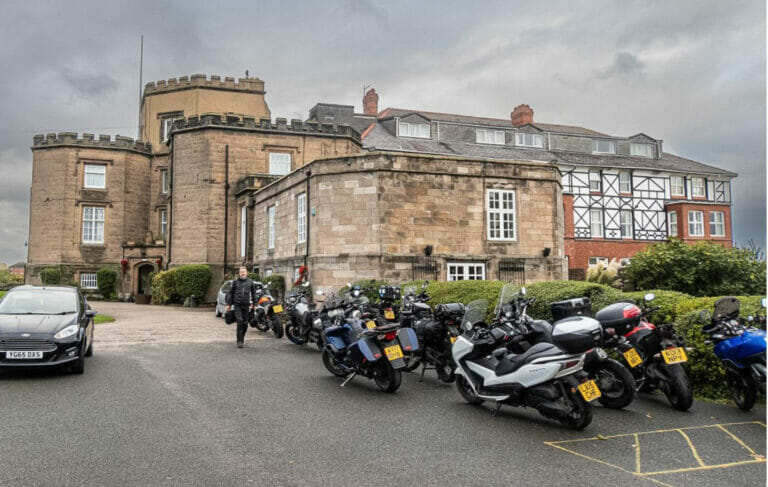
The group outside the Leasowe Castle Hotel on The Wirral, the following morning
I borrowed some wire from a fellow rider to lock the silencer into place, to ensure that it would not slide backwards again, and that repair lasted all the rest of the trip, although the silencer itself continued to deteriorate, paint burning off and rust spots starting to appear, and I junked it once I got home (it was a cheap Chinese universal job).
Day 3
After breakfast at the hotel, we all packed up and set off through Liverpool, firstly to Tescos so that Nathan could try and find a replacement phone (his one had died in all the rain the day before) and then off up the motorway towards Preston in Lancashire, where we stopped for fuel and a tea break, then into the countryside for a stop at Puddleduck’s Tea Room in the warm sunshine at Dunsop Bridge. Unlike the previous day, after a brief stop for lunch, the group split, as there were two routes plotted. The first was straight up into Cumbria and some more technical riding through various passes like the Hardknott and Wrynose, the second a more relaxed route through the Yorkshire Dales national park, the North Yorkshire moors, and then down into Teesdale, and across Cumbria to our third hotel stop, in Carlisle. I chose the second route, as did a couple of other riders in the group, although we mostly didn’t ride together.
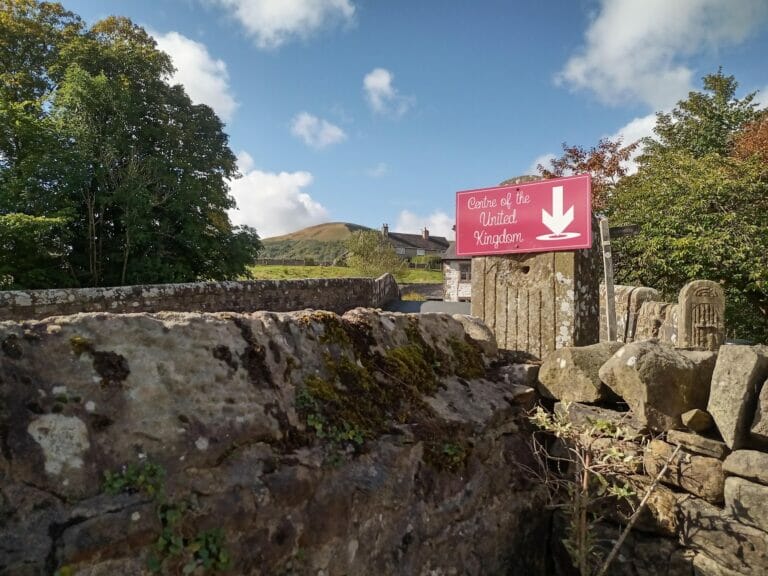
The view from Puddleducks Tea Room, at Dunsop Bridge in the Ribble Valley
I set off, initially following Stuart on his Honda scooter, meandering across the countryside. We stopped at a point on the moors, to take some photos, then he set off again, and by the time I had finished taking pics, he had vanished, and I didn’t see him again until that evening at the hotel.
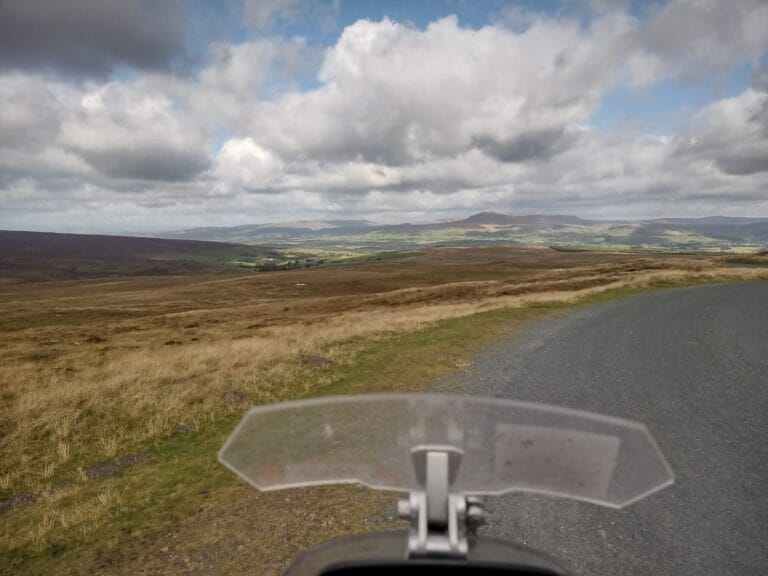
A view across the moors, north of the Forest of Bowland
From there I rode back down into the valley, and via Bentham and Ingleton, to the road across the Yorkshire Dales National Park, past White Scar Caves and the Ribblehead Viaduct (where, sadly, I couldn’t find anywhere safe to park for a photo opportunity) and onwards to Hawes, where the main road through the town was closed and in the process of being dug up. I detoured around the town via back roads, got back on the main road, and crossed the river Ure at Bainbridge, before heading back along the other side of the valley, and thence up and over the infamous Buttertubs pass. For obvious reasons it was not a good idea to stop and take pictures up there, especially as the wind was a bit vicious, so I continued down the other side, via Thwaite and Keld, and back up onto the moors where Nathan’s pre-plotted route took me to within a hundred yards of the famous Tan Hill Inn, where I stopped for a break, tea and an excellent late lunch.
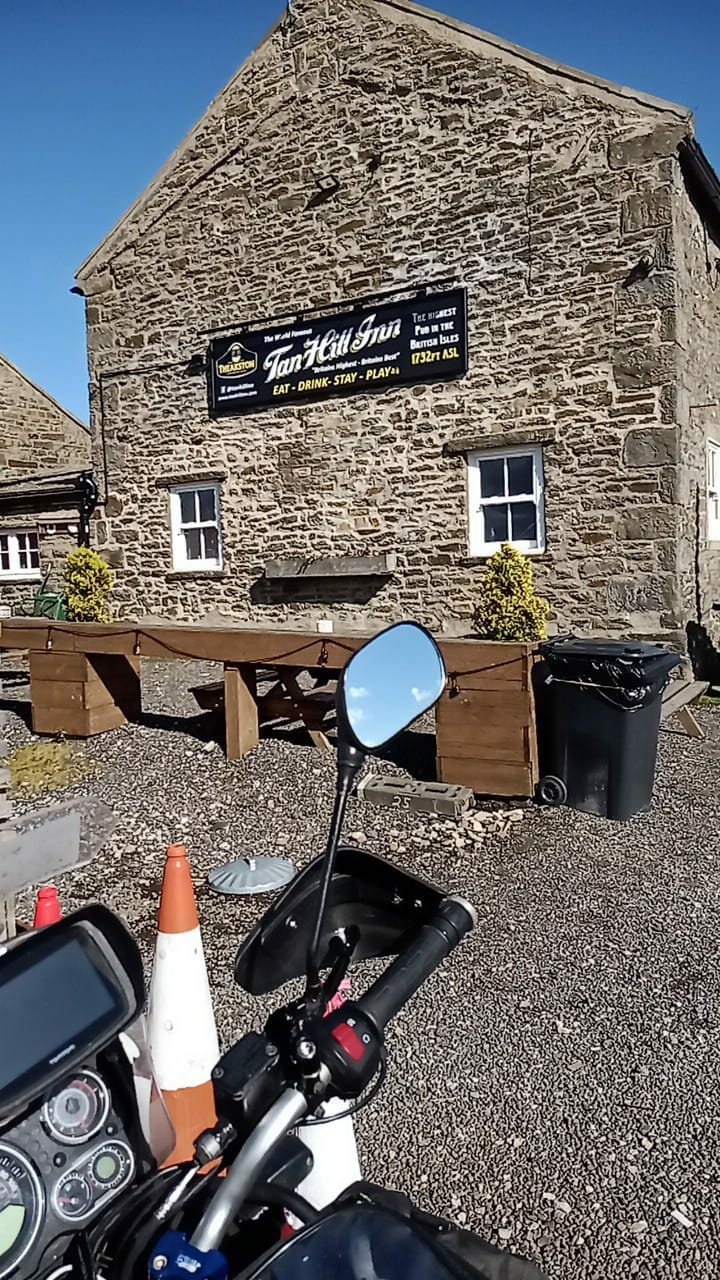
Parked up for a late lunch at the Tan Hill Inn
After lunch it was time to ride back down into Teesdale, and follow the roads across Cumbria, via the Hartside Pass and then minor back roads near Penrith, to Carlisle, where we were staying at the Cumbria Park Hotel. The ride towards and up the Hartside Pass was challenging, as some of it was rather steep and I was riding into a stiff headwind, which was not only very cold, but together with the steep terrain, caused the poor Himalayan some difficulties, with my speed dropping rapidly. Having to lug me and my luggage as well as itself, up the pass, into the heavy wind, truly revealed the lack of overall power, which doesn’t usually become apparent unless you are trying for a rapid overtake.
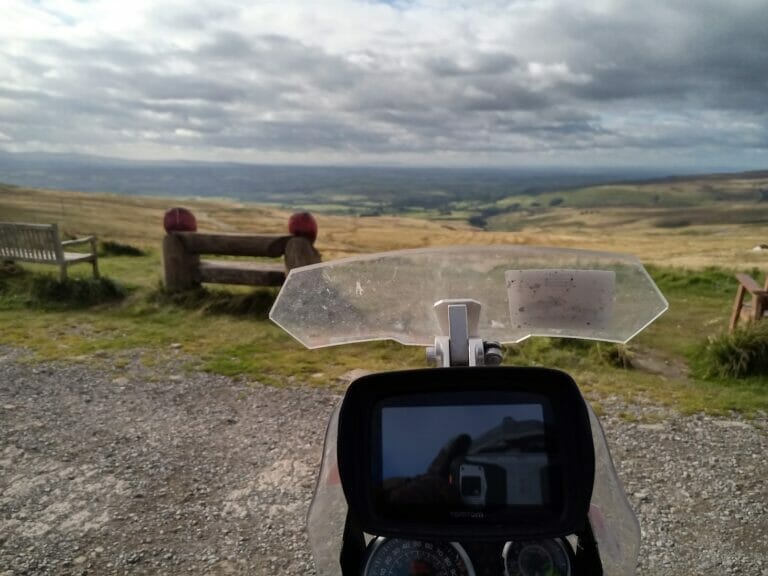
At the summit of the Hartside Pass
When I arrived, there were already a couple of bikes, and Stuart’s scooter, parked up. I checked in, found my room, then went and unloaded the bike for the fourth time so far (counting the B&B on the Saturday evening). For those that are interested, I had sold my Royal Enfield aluminium panniers and the factory pannier rails a while back. They had served me well, and had never leaked, but I had decided to move to soft panniers, mostly for the weight saving, with just the small and lightweight Hitchcocks throw-over panner rails to keep things out of the back wheel. For this trip, as we were not camping, I had bought a cheap pair of smaller expandable throw-overs, rather than the larger “Dirtsack” ones I use for camping, and some smallish drybags, to keep my changes of clothes and other non-riding gear dry. At the end of each day I left the panniers strapped to the bike (secured with a steelcore lockable strap) and just took the smaller drybags indoors to my room. Less weight to carry.
Day 4
The start of day 4, after an excellent breakfast and a mass re-packing of the bikes, first took us to an Argos store on the outskirts of Carlisle, where Nathan had arranged to pick up his replacement phone, the previous day’s stop at the Tescos in Liverpool being unproductive. Then we set off north again, towards Gretna Green and into Scotland. Once again the poor Himalayan suffered from the inability to safely carry out fast overtaking manoeuvres, as a lot of the roads were fast A roads, and I got used to seeing most of the group overtaking me and vanishing into the distance. However, once past Dumfries, and some fast main road action, we entered the Galloway Forest area, and found ourselves on twisty back roads, and while I was still falling further behind, I was much more comfortable, as those kinds of roads really suit the Himalayan’s character.
After a while, we stopped for a late morning break, in a tiny village called Carsphairn, where we found a really excellent little shop and tea rooms. Small but perfectly formed, they did us tea, coffee and snacks for good prices and with excellent and very friendly service. As if having a large group of bikers descending on them looking for refreshment was a regular occurrence…perhaps it is!
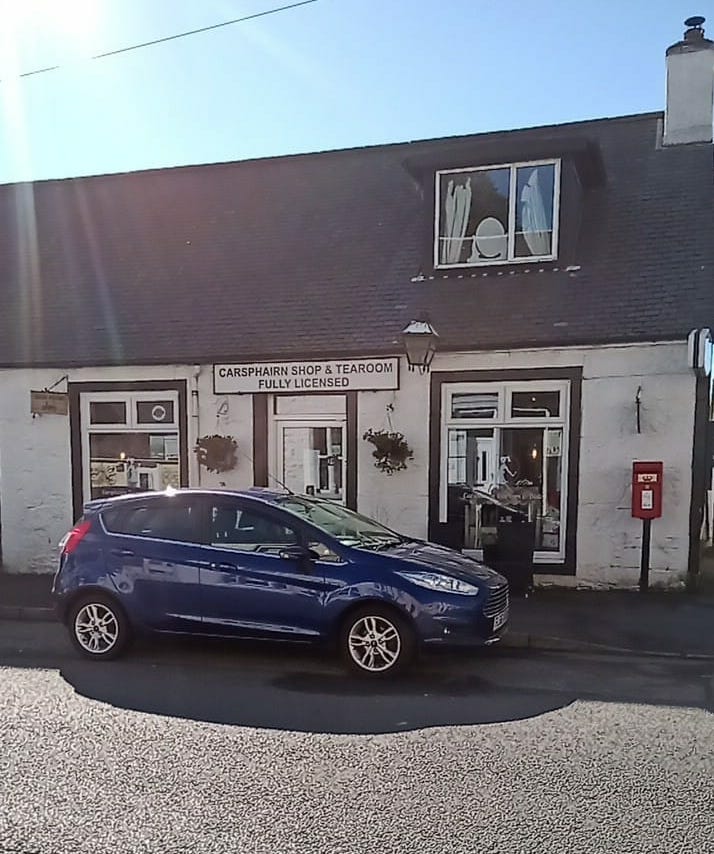
Carsphairn Shop and Tea Room. We were parked on the other side of the road
We then set off further north, towards Largs, where we were going to stop for lunch, before getting a ferry. Unfortunately after exiting from the nice rural areas of Galloway, we headed towards Largs via Ayr and Prestwick, mostly on the A77 and A78, fast dual-carriageways for the most part, and I fell behind, even though I was keeping my speed up to 70mph wherever possible. Once again it was overtaking that let me down. I finally caught up with the group just before we got into Largs, at a parking area just north of the Androssan Ferry Terminal.
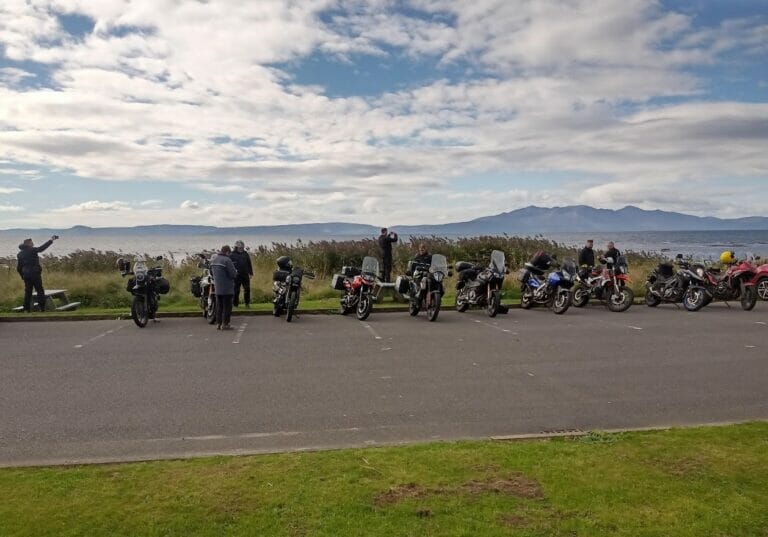
Parked up near “The Waterside” in West Kilbride, looking out at the Firth of Clyde
After a few minutes we set off again, into Largs, for a comfort stop and a late lunch. There were quite a few options, but myself and a few others settled for the Riviera Cafe as it was only a very short distance from where we had parked up, and they had some very good food and drink on offer. We all got stoked up and warmed up, ready for the remainder of the day’s journey. After a further fuel stop, we rode north yet again, up to the McInroys Point Ferry Terminal, where we only had to wait a fairly short while, before boarding the ferry for Hunter’s Quay and the last leg of the day’s ride.
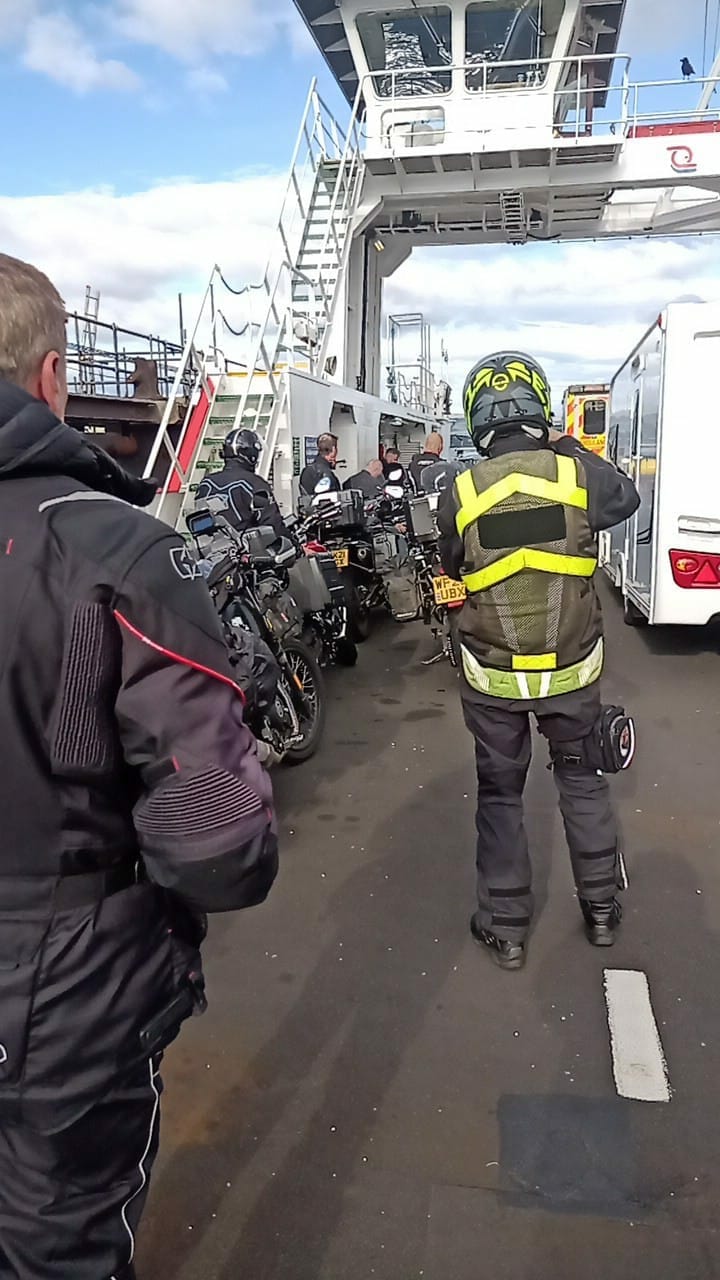
Onboard the ferry crossing over to the other side of the Firth of Clyde
Once back on dry land we had a quite long and meandering course that took us into the forests and mountains on very small roads, which were for the most part in remarkably good condition, before ending up, emerging from the trees, onto the A83 by the “Rest and Be Thankful” viewpoint. It was then a more or less straight ride down the A83, from high up in the valley, down the valley’s side, then turning North-East along the western shore of Loch Long, and thus into Arrochar, where we arrived, hungry, thirsty and travel weary, at the Arrochar Hotel, on the shores of the Loch.
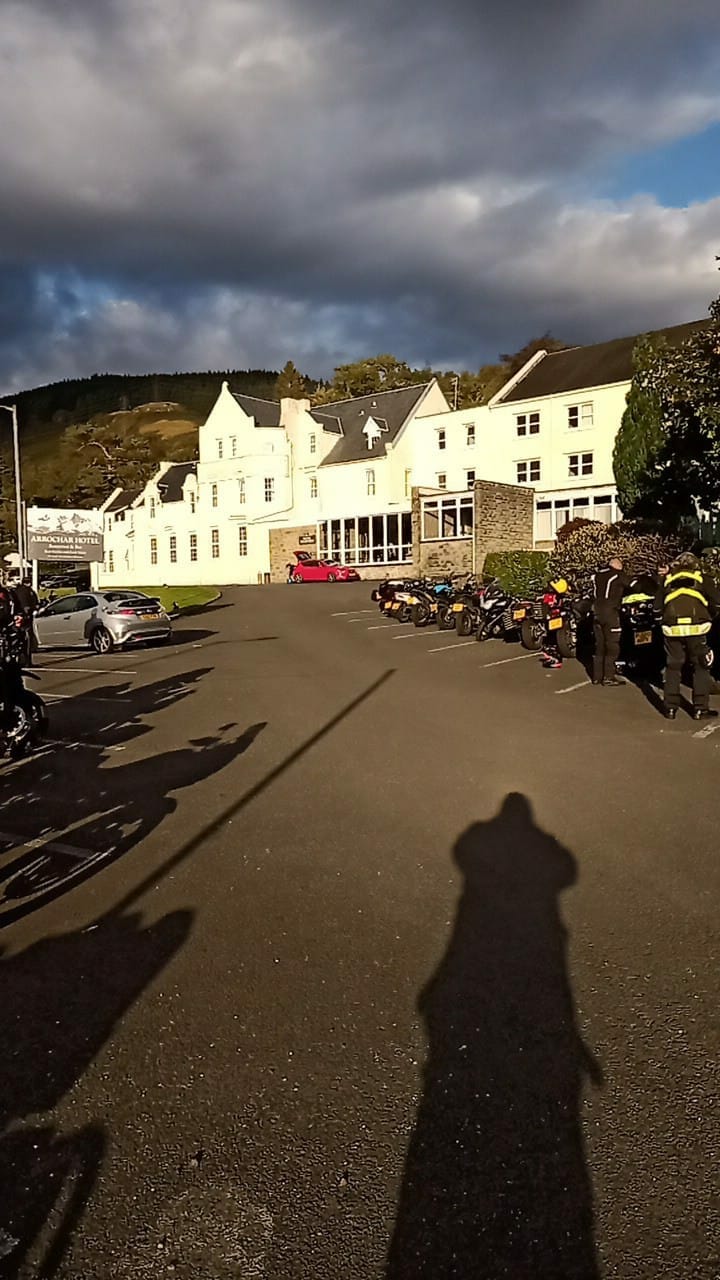
All parked up outside the Arrochar Hotel, Loch Long
Day 5
Our final day of scheduled riding on the tour, and the day started with a large group breakfast at the hotel, and lots of discussion on which routes people would be taking. There were two potential routes on offer, one of them being out to the coast to see a particular lighthouse, before backtracking and heading towards Skye. I’ve seen a lighthouse, and didn’t want to add on an extra hundred miles to the route, on our last day. A few other riders also decided that they preferred the shorter route, so I led my small band of rebels onto the more direct route via Loch Lomond (where, amazingly, I managed a snap overtake of some caravans and motorhomes…it just so happened that I was in the right gear at the right time, with sufficient forward visibility), Crianlarich, Bridge of Orchy, Glen Coe (where we stopped at the visitors centre for a tea break, and a short while later a fuel stop), before turning north up the west coast of Loch Eil towards Fort William, although there was a moment of confusion as the route I had got from Nathan seemed to direct us onto a ferry at Corran. One of our little group studied the map on a sign by the ferry parking area and realised that this would take us a very long way off our route, with some major backtracking required. So we set off again. By now I was starting to get a bit peckish, and as we rolled to a stop in a layby next to the Glen Garry viewpoint, quite a bit further on, via Spean Bridge and Invergarry, I interrogated the satnav to see if there were any cafes, pubs, restaurants, etc, that might be open on a Thursday afternoon, this far out into the wilds.
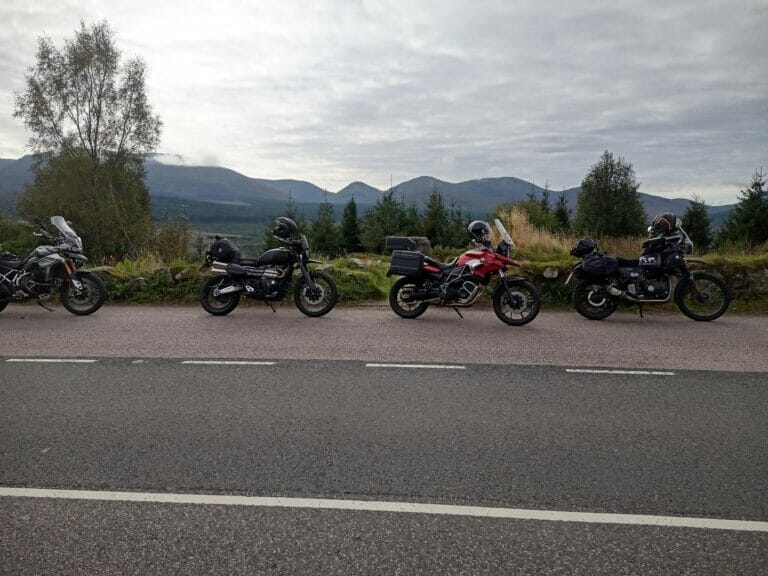
The rebel group, at Glen Garry Viewpoint
It turned out that there was, about 20 miles further on, and we all agreed that us Rebel Scum should stop and refuel ourselves with hot food at the next available opportunity. Thus we pulled into the car park of the Landour Bakehouse, all ready for lunch. As it turned out, the bakehouse didn’t have anything hot (except soup) it was all sandwiches and pastries, but the lady behind the counter told us that the bakehouse was owned by the same company as the pub, the Cluanie Inn, by the shore of Loch Cluanie, and that it would be perfectly alright for us to leave our bikes there while we ate in the pub’s restaurant, which we were very happy to do.
Some time later, filled up with hot food, we remounted our noble steeds and headed west on the last leg of the long trip to Skye. The ride took us through amazing scenery of mountains and lakes, long narrow waterfalls cascading down the mountainsides, heather and rocks, until we approached the Kyle of Localsh, and the bridge over to Skye itself.
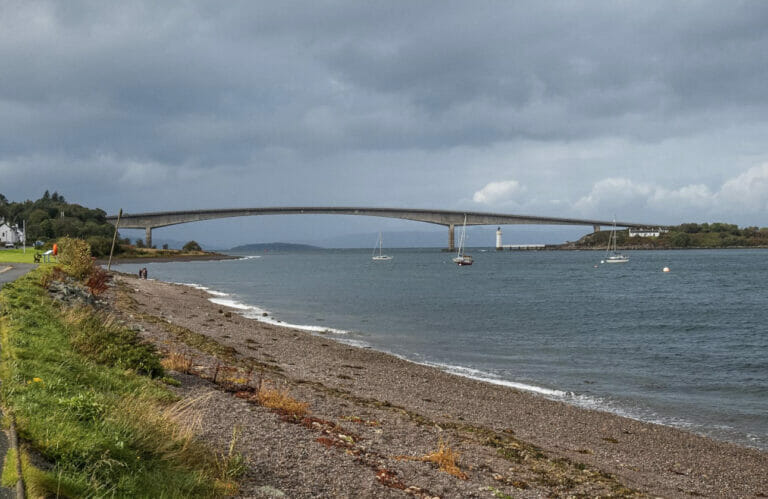
The bridge from the mainland to the Isle of Skye
Our journey was over. Once over the bridge, we turned left, down into Kyleakin, and our final destination, the King’s Arms hotel.
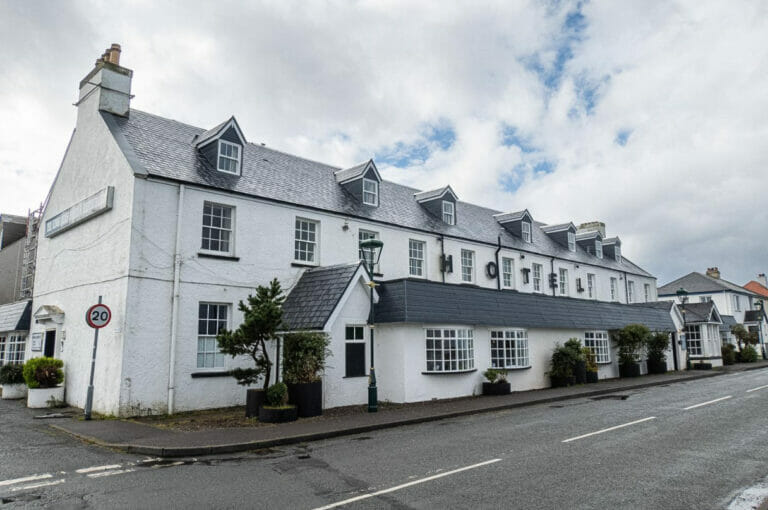
The Kings Arms Hotel, Kyleakin
Day 6
After a good night’s sleep, albeit in a narrow bed in a tiny room (the bathroom was bigger, you could almost have had a party in there!) we all met up for breakfast, and afterwards into the hotel lounge to chat about plans for the day. Some wanted to tour the island (fair enough) but I wanted a day off. I had covered 1373 miles since the previous Saturday morning, and had a 557 mile ride home on the Saturday. At that point it was pretty academic anyway, as the rain was hammering down, there were gale-force winds blowing, no vehicles were crossing the bridge, and the boats moored in the loch were bouncing about as if on aquatic trampolines.
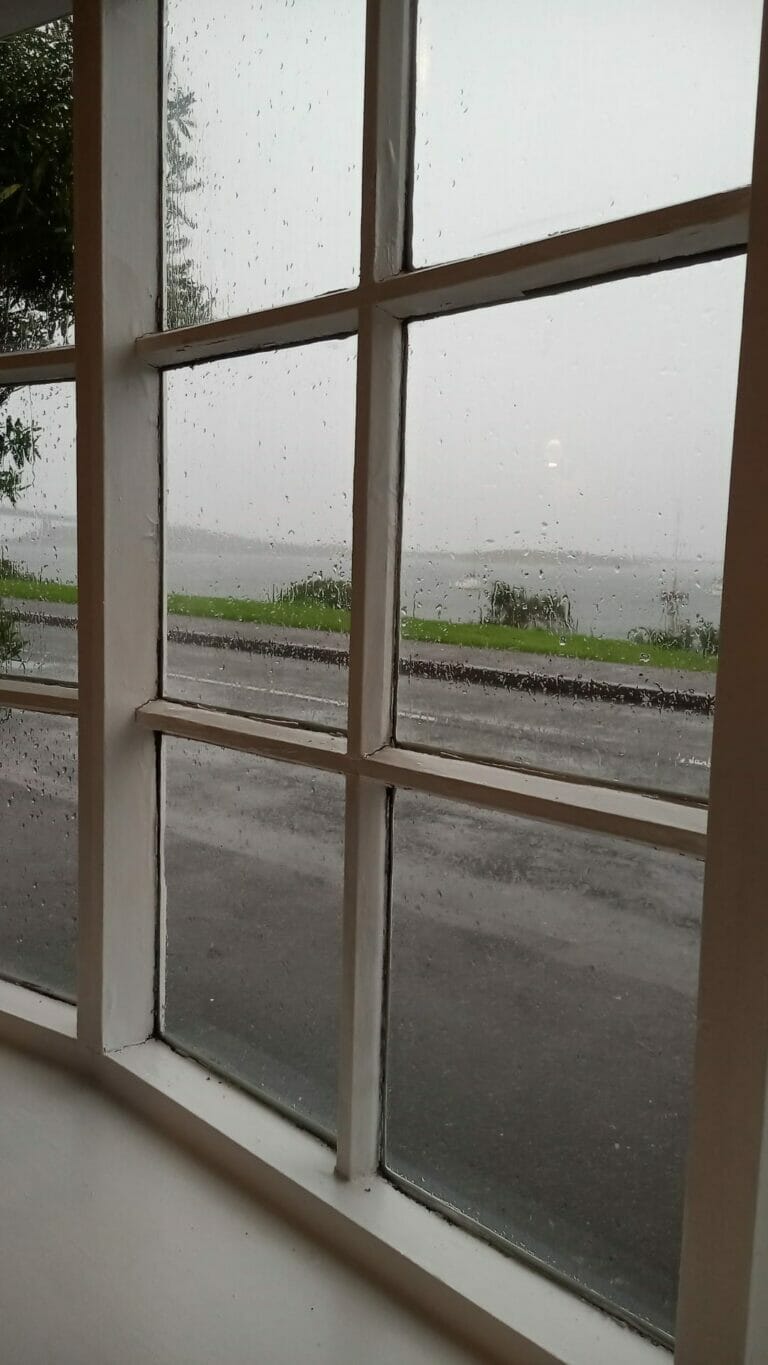
The view from the hotel window on the Friday Morning
Later on, the weather eased a bit, and around mid-day some intrepid members of our group donned their waterproofs and set off to explore. And found a landslide blocking the main road. Some detoured, some turned back, went over the now re-opened bridge to the mainland and explored over there. I went out for a walk, looking for something to eat, as there was no food service in the hotel (not even tea and biscuits) until the bar opened at 6PM. I walked all around the village, and down to the harbour, finding nothing open. There were two cafe/bar places, both shut until 4/5PM, a tiny tea room that was only open on Wednesdays, and no shop. I couldn’t even buy a Mars bar. I even resorted to walking back up the hill to the roundabout by the bridge, and along to the local Indian restaurant. It was shut.
I went back to the hotel, and took a nap, and at 4PM, walked back down the street to “The legend of Saucy Mary” a bar and restaurant that was open for drinks from 4PM, and food from 5PM.
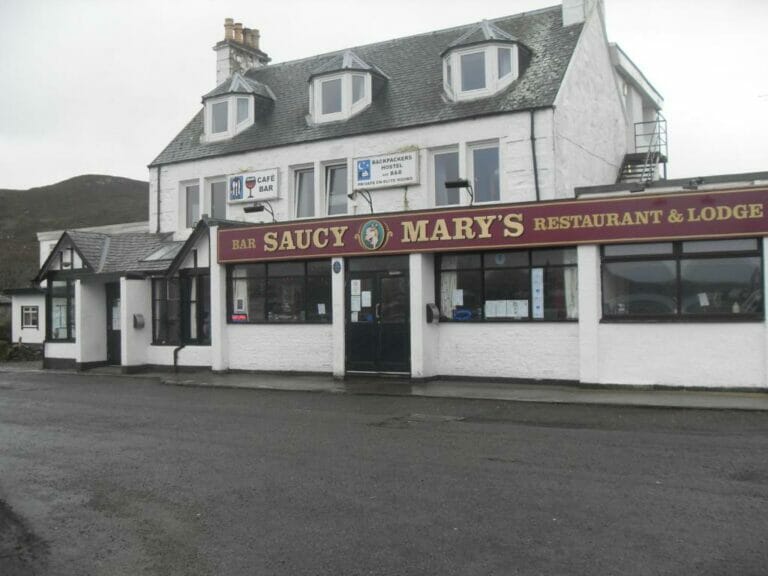
The Legend of Saucy Mary restaurant and bar, Kyleakin
I posted a message in our group’s whatsapp channel, and people started to drift in, until, with the arrival of several more group members who had decided to try the other place, but didn’t like it, we had taken over about half the tables in the place. The kitchen opened promptly at 5PM, and an Irish waiter came around to take our orders. All the staff were extremely friendly and helpful (with the exception of the barman who was a rather surly Eastern European gentleman). When the food started to arrive it was all well cooked and extremely tasty. Many beers (or in my case, ciders) were imbibed, and we stayed in there for quite some time, before wobbling off back to the hotel and bed.
Day 7
The journey home begins! This section doesn’t have much in the way of pictures, as I just rode and rode, only stopping for breakfast after a long ride through the Cairngorms, and then hammering my way southwards, on dual carriageways and motorways, 557 miles back home to North Oxfordshire, only stopping briefly for fuel and comfort breaks..
I had decided to get as early a start as possible, and try to make it all the way home in one day, unless bad weather or some other factor forced me to break the journey. I thought I’d have breakfast as soon as the hotel restaurant opened at 7AM, and thus be on the road by 7:30AM, when it should be fully light. Unfortunately the hotel staff had other ideas. No, I could not have my breakfast now, OUR group’s breakfast was booked for 8:30AM, and I could not have it any earlier because the whole restaurant was taken up with a group of 48 very loud American tourists.
I was not happy, but there was nothing I could do. I had already loaded the Himalayan up with all my luggage, so I just had to check out, put on my riding gear, and head off.
Up and out of Kyleakin, over the bridge in the early morning light and drizzle, and back through the mountains, retracing in reverse the route we had taken on the Thursday afternoon. Until I got to Spean Bridge where, rather than turning south towards Fort William, I headed east, following the route that my Sat Nav assured me would be the quickest. This took me into the Cairngorms National Park, past many mountains and lochs, then up and over the mountain passes between Kinloch Laggan and Dalwhinnie. I was very glad to see the latter, as it contained the first petrol station I had seen actually open since I had left Skye and I was getting very low on fuel, with just about ten miles range left in the tank and my 3 litre emergency supply. I filled up, stretched my legs, and finding the A9 just at the edge of the village, started heading south.
I was starting to get very hungry, but this particular stretch of the A9, varying between two-lane and dual carriageway frequently, was pretty bleak and empty. However I pushed on and was rewarded with the sight of the Ballinluig Motor Grill Diner. It was pretty busy, but I managed to snag a parking space, as another biker, on a Triumph, also pulled in. We queued up together, and agreed that we would share a table, so we didn’t have to wait too long. He was from Orkney, but was touring the mainland. We had a nice chat, and after our cooked breakfasts and tea arrived, we both set to with a will!
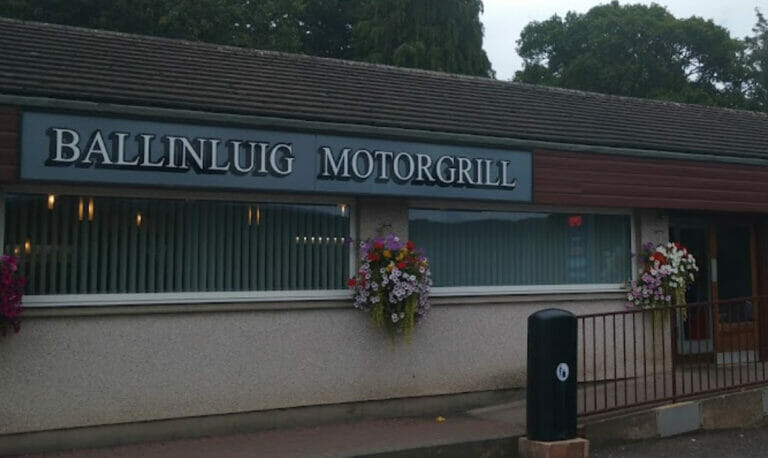
My breakfast stop on the A9 north of Perth
Once breakfast was finished, we said our goodbyes, and I headed south on the A9, keeping right up to the speed limits where traffic conditions permitted, as I needed to make progress. The sun had come out and the roads were drying, although there was a constant chilly wind blowing. The weather would cycle constantly between sunshine, cold winds and showers for much of the rest of the day.
The A9 became the M9, then the M80, round the outside of Glasgow, and as the miles rolled by, onto the M73, the M74, and the A74(M) until finally I was back in England and on the M6, heading south through Cumbria. Junction signs for Carlisle, Penrith and Kendal flashed by, Lancaster, Preston, Warrington, and then into the north Midlands, Crewe, Stoke-on-Trent and Stafford. As I approached Birmingham, the light was starting to go, and I merged into heavy traffic joining the M5, and thence onto the M42, to circle around the south of Brum.
The last leg was in sight as I rode through the late evening darkness to the junction with the M40, practically on autopilot now. Exiting the M40 at the Gaydon junction and back onto normal roads for the first time since just south of Perth that morning, I was shocked by how quiet everything was. The manic scream of the exhaust, the engine vibration and the constant blast of wind noise (mitigated by the earplugs I wear all the time when riding now) were gone, replaced with the gentle plodding of the Himalayan’s 411cc Long Stroke engine and nothing else. It was 9PM and I had just 20 minutes until I was home.
I rolled up onto my driveway at 9:20PM, just ten minutes shy of fourteen hours since I had left Skye that morning, with about twelve hours in the saddle. The poor abused Himalayan had done me proud, not missing a beat whether crossing mountain passes or thrashing along motorways. And the Seat Concepts high touring seat kit, augmented by a cheap rip off of the Cool Covers seat cover, enabled me to ride 557 miles in one day with no ill effects to my backside, although my knees were hating me towards the end of the ride.
In total, from when I left home on Saturday morning to head to the REOC AGM, to returning home on the following Saturday evening, I had covered 1930 miles, ridden in all weathers and through all kinds of landscapes. The only difficulty with the bike during the tour was the issue with the cheap aftermarket silencer, which was not Royal-Enfield’s fault, Despite being mercilessly thrashed for much of the tour, and ALL the way home, Sherpa had not used any noticeable amount of oil, although the rear tyre was pretty much dead by the end of it, VERY squared off (was about half-worn when I set off). The only other thing that was measurable, and notable, was the fuel consumption. Under normal circumstances I get about 75mpg (I know that the Himalayan can do better, but I’m a big chap, and was hauling luggage too). Under constant motorway thrashing, first on the Saturday afternoon as I rushed to get from Lincolnshire down to North Devon, and on that final long ride home, I was riding with the throttle on the stop for most of the time, and saw after a couple of fuel stops, that for the previous session it had dropped to little more than 55mpg. I suppose that is to be expected if you are riding a heavily loaded small capacity single cylinder motorcycle with the throttle wide open. Otherwise the bike did fine, no problems.
So, can a Royal Enfield Himalayan tour? Absolutely!
Views: 1711
